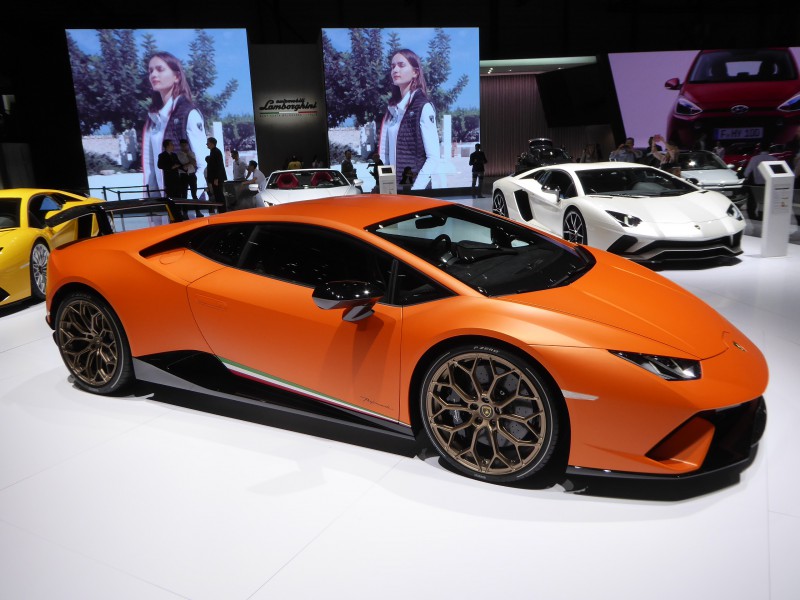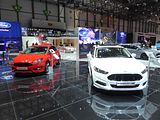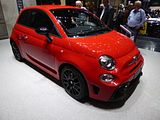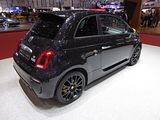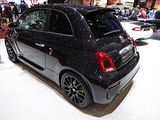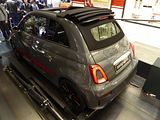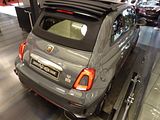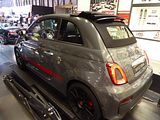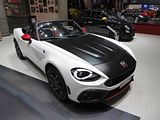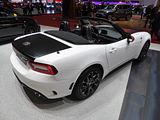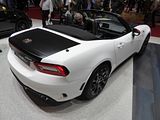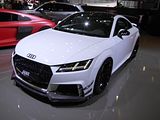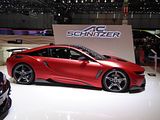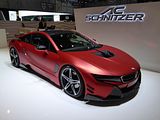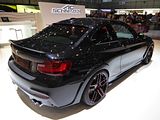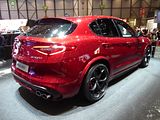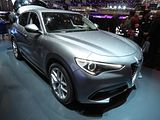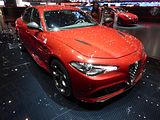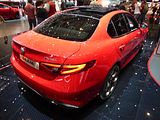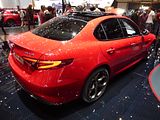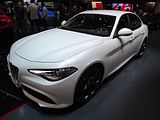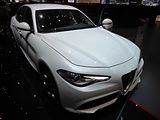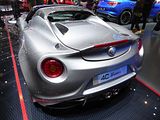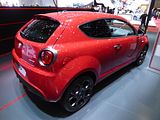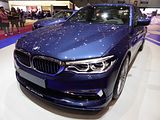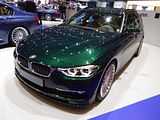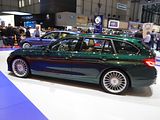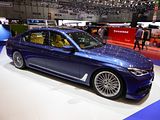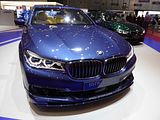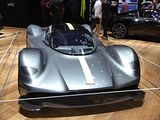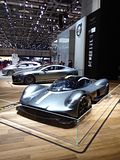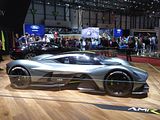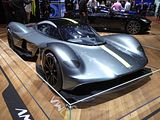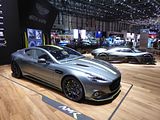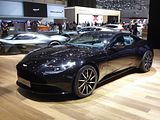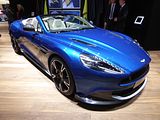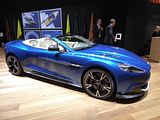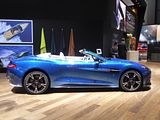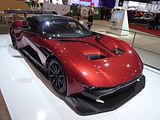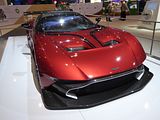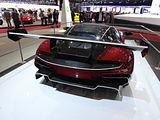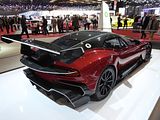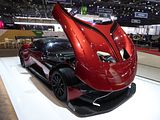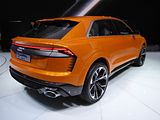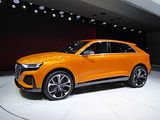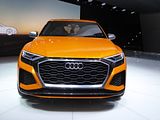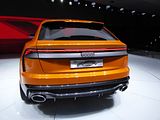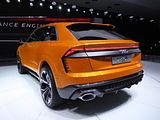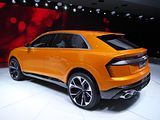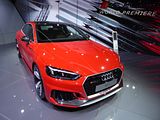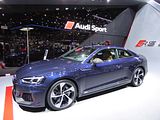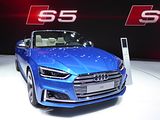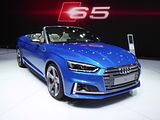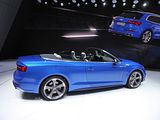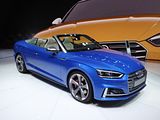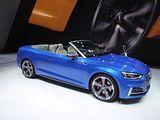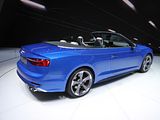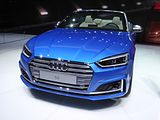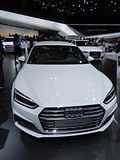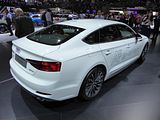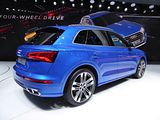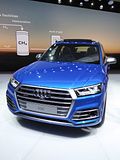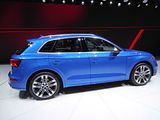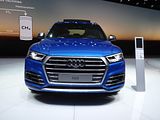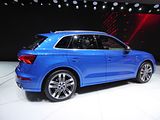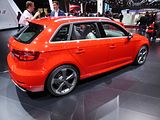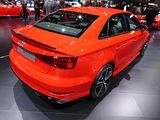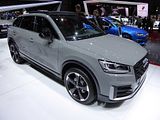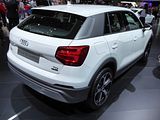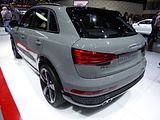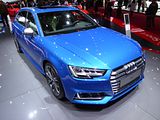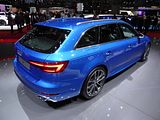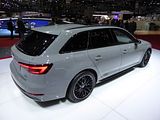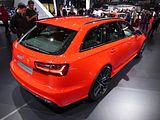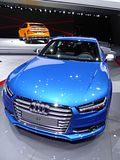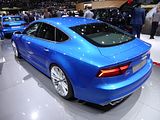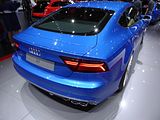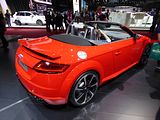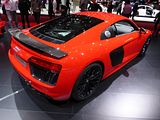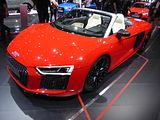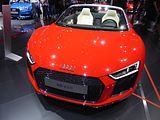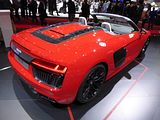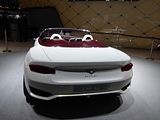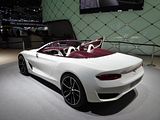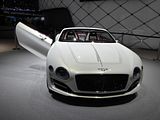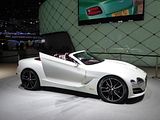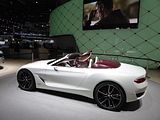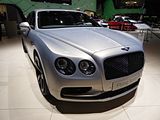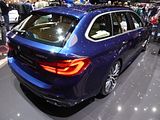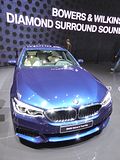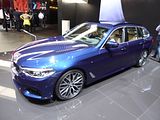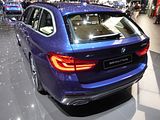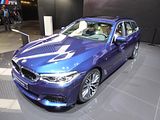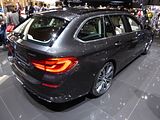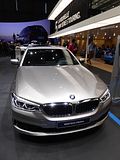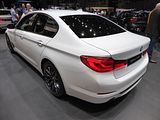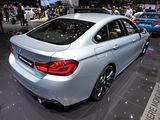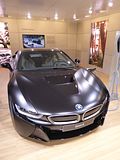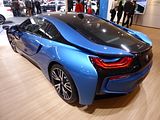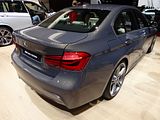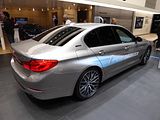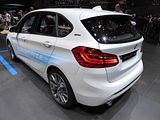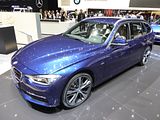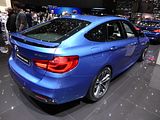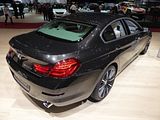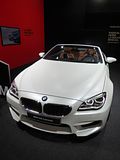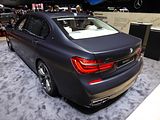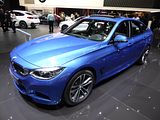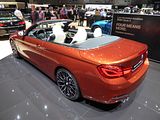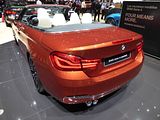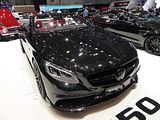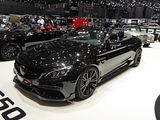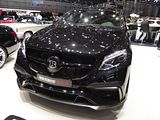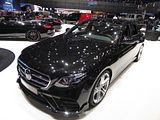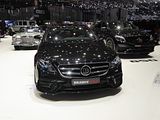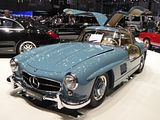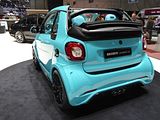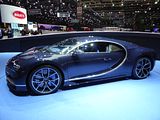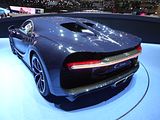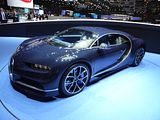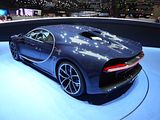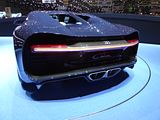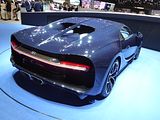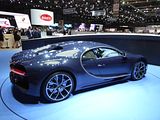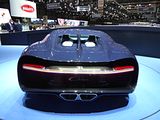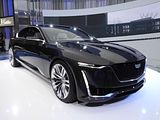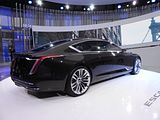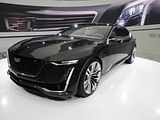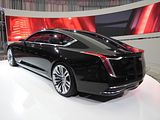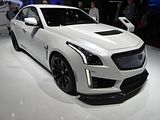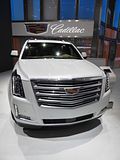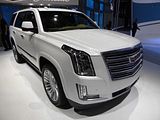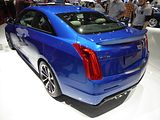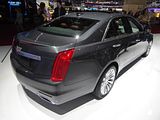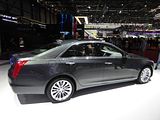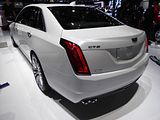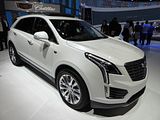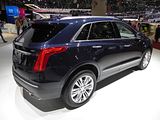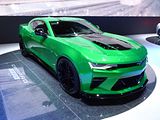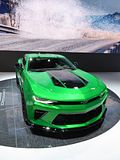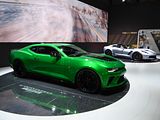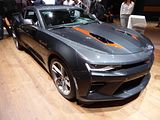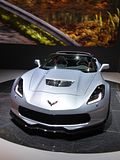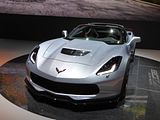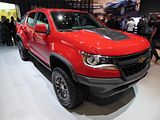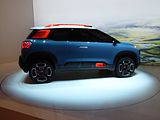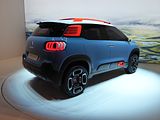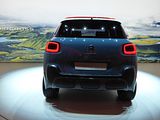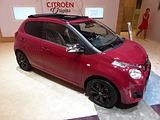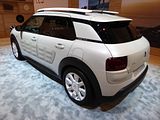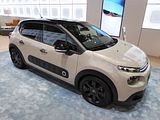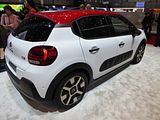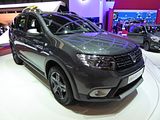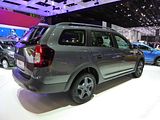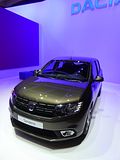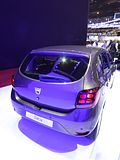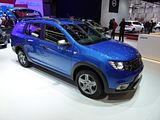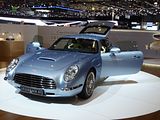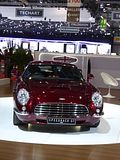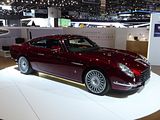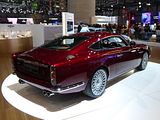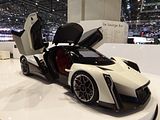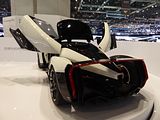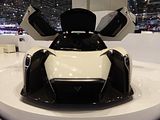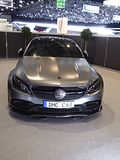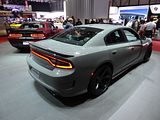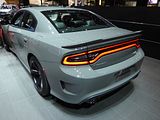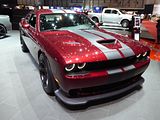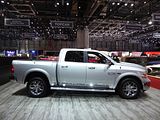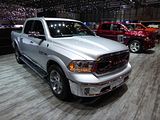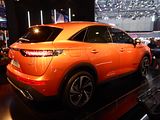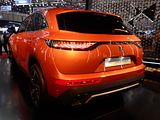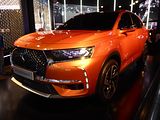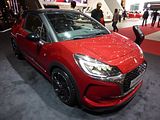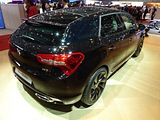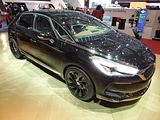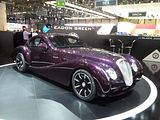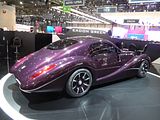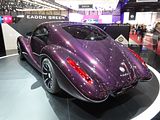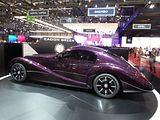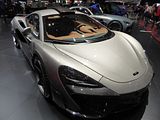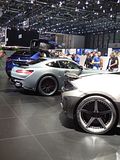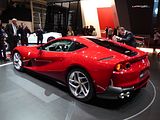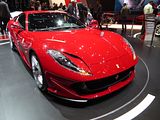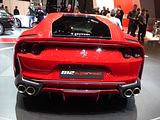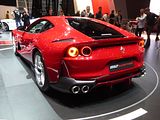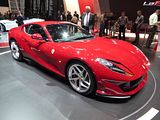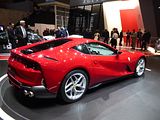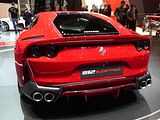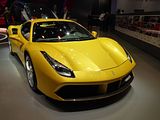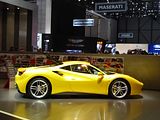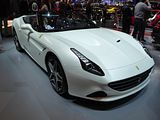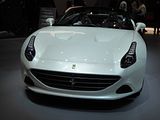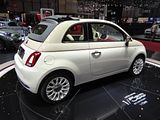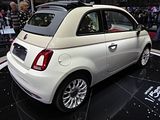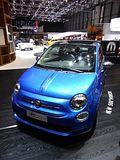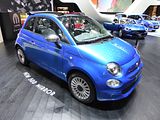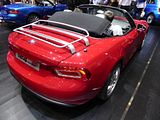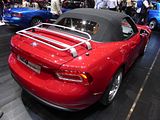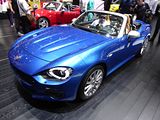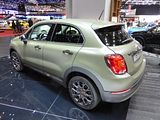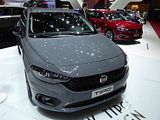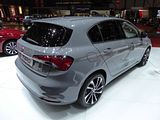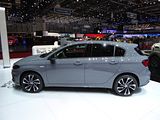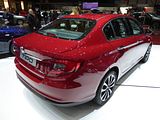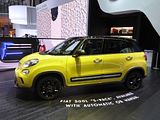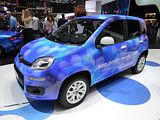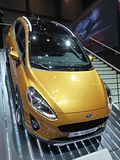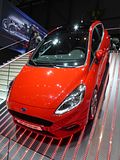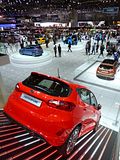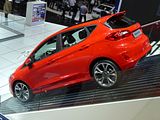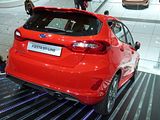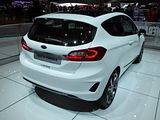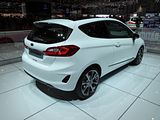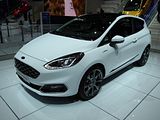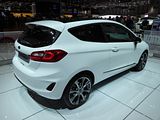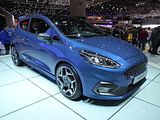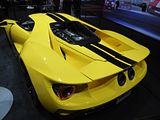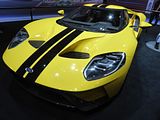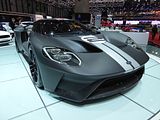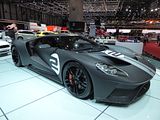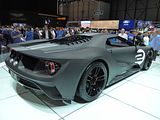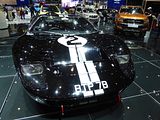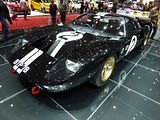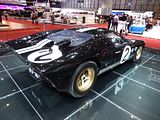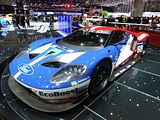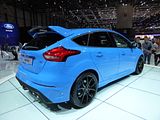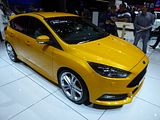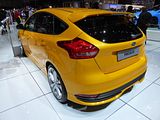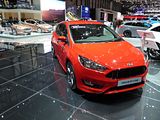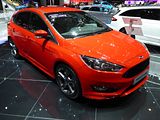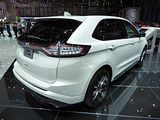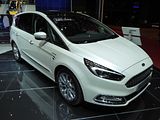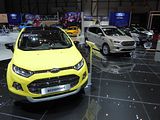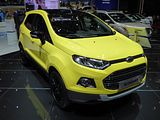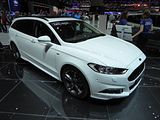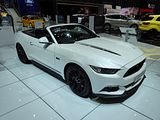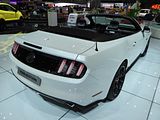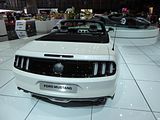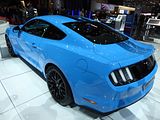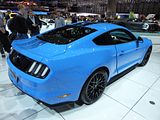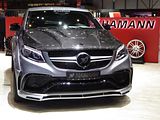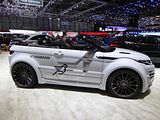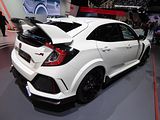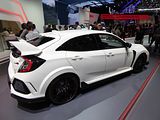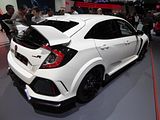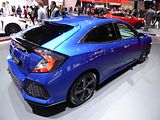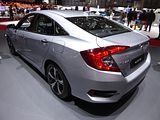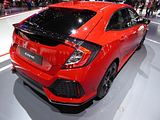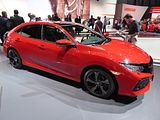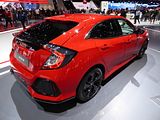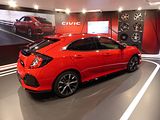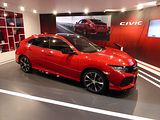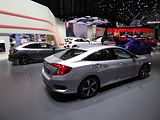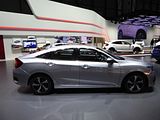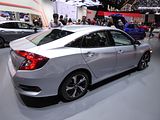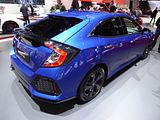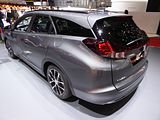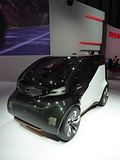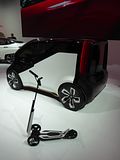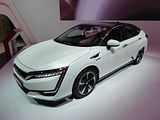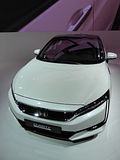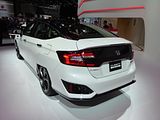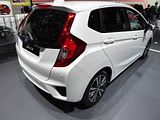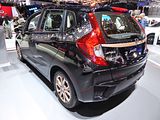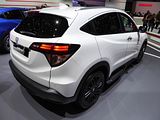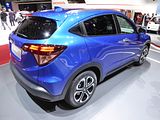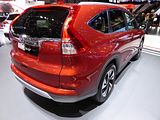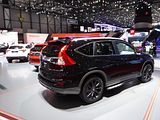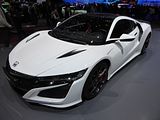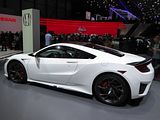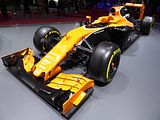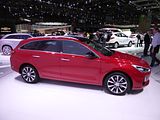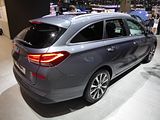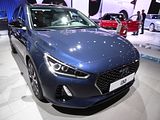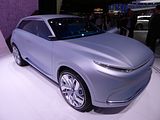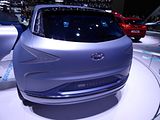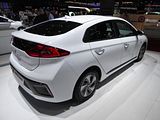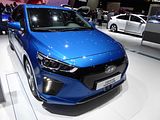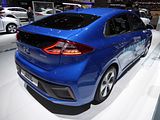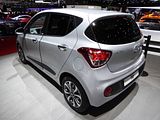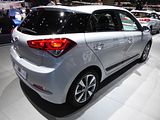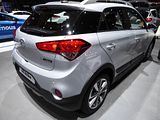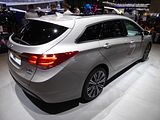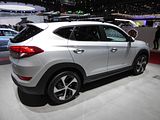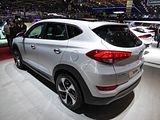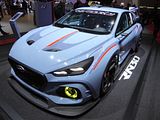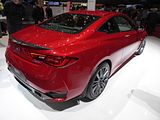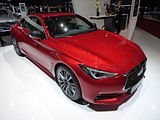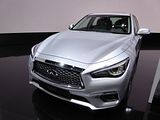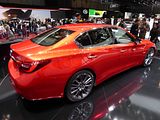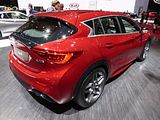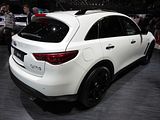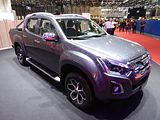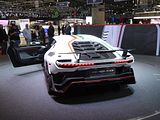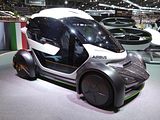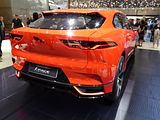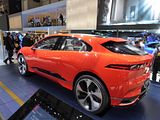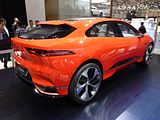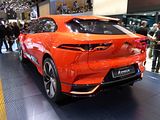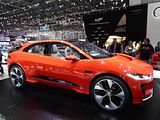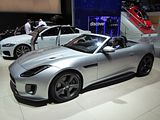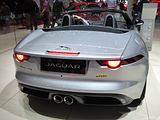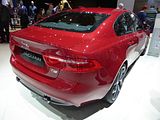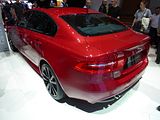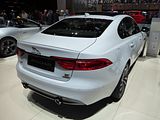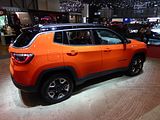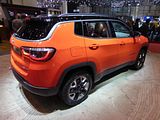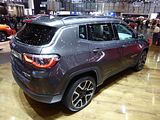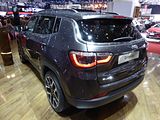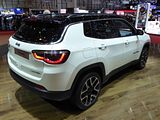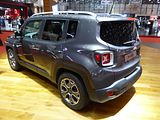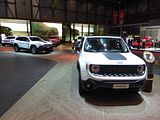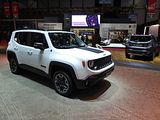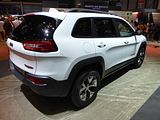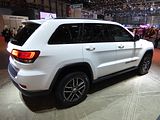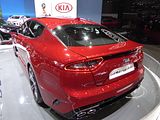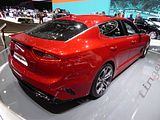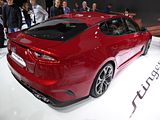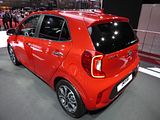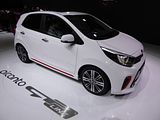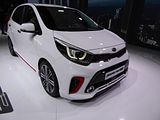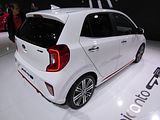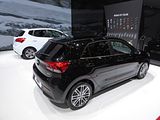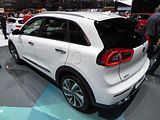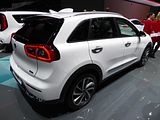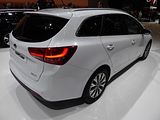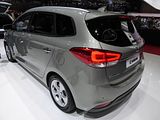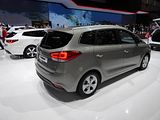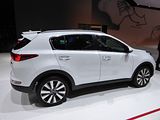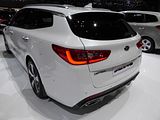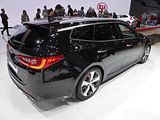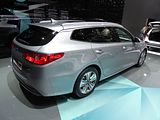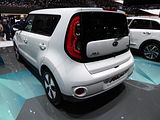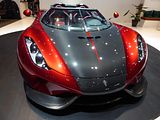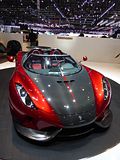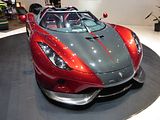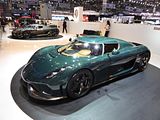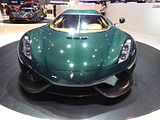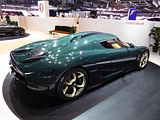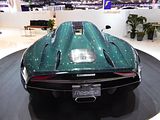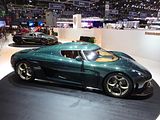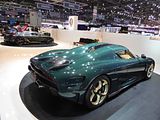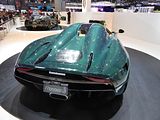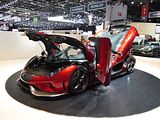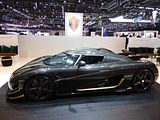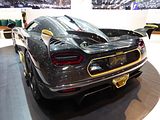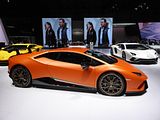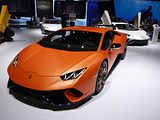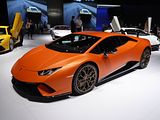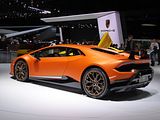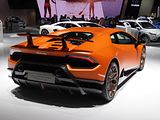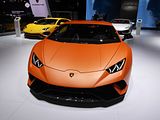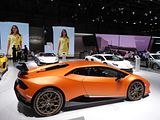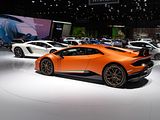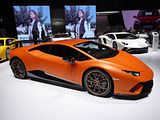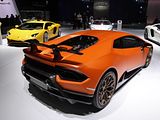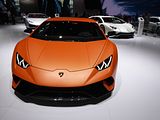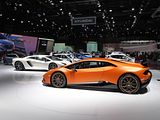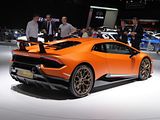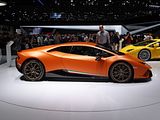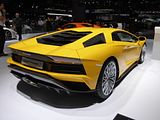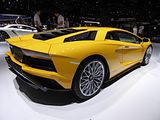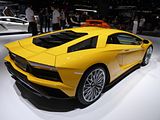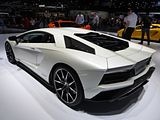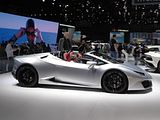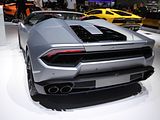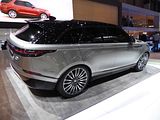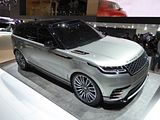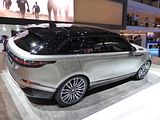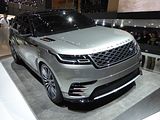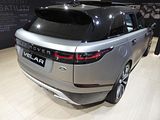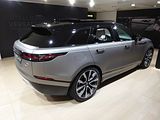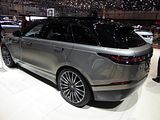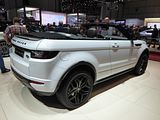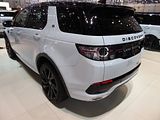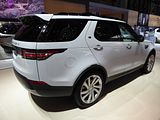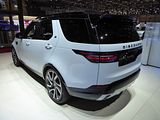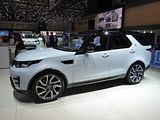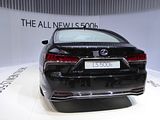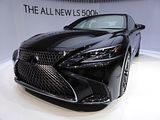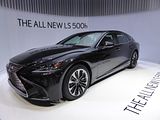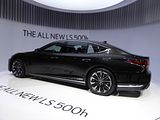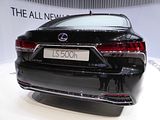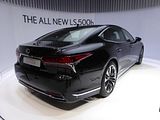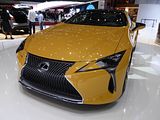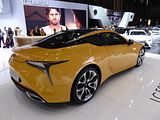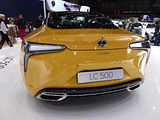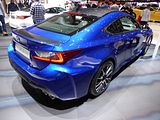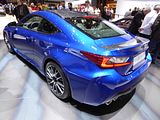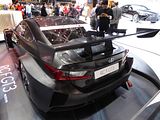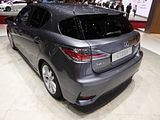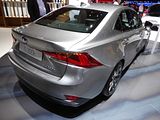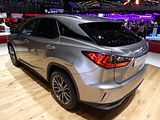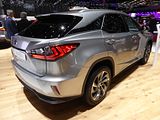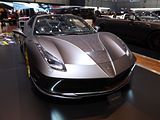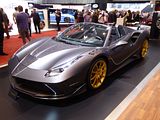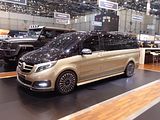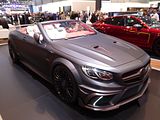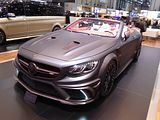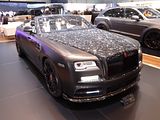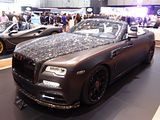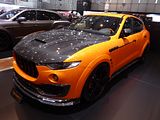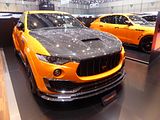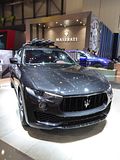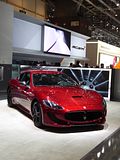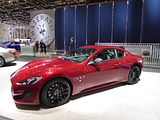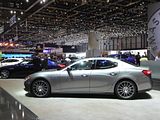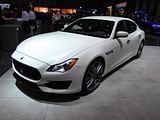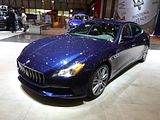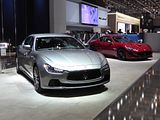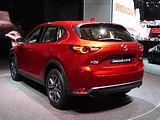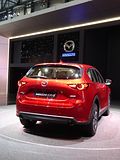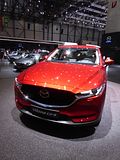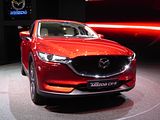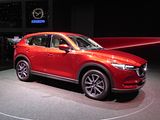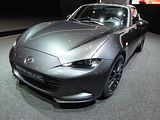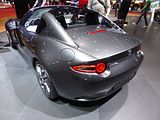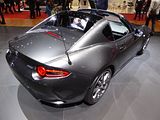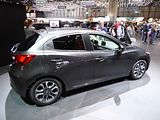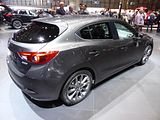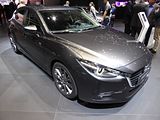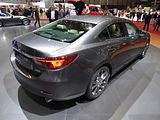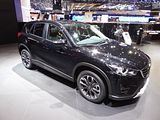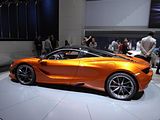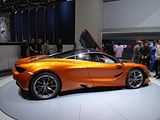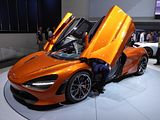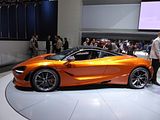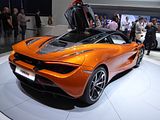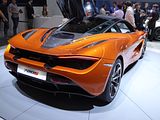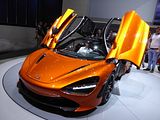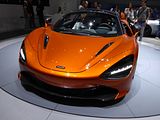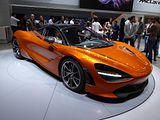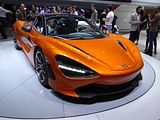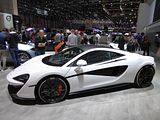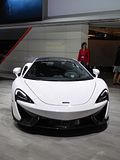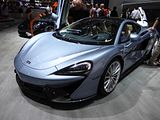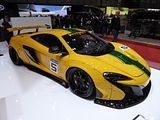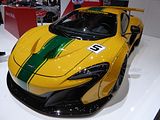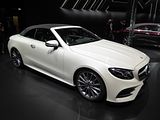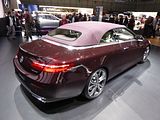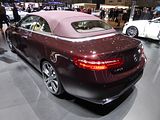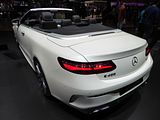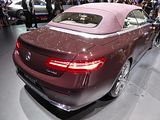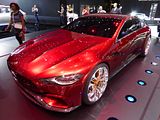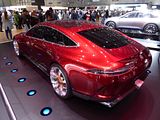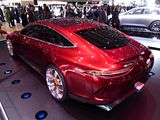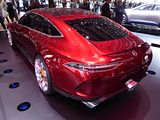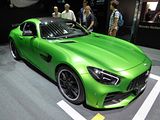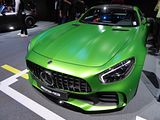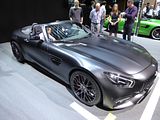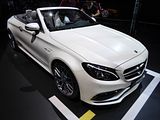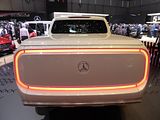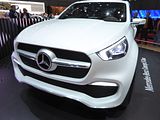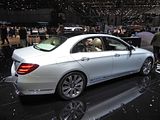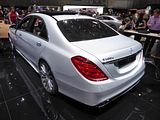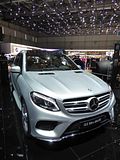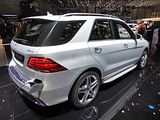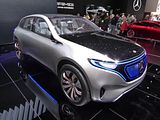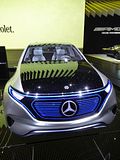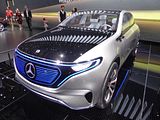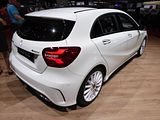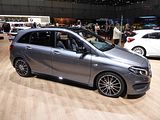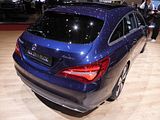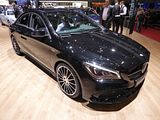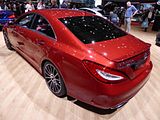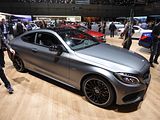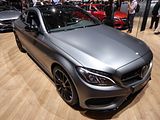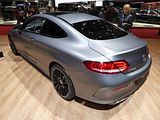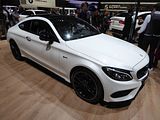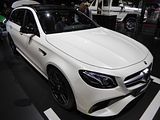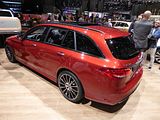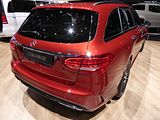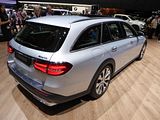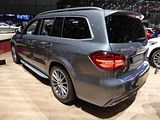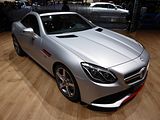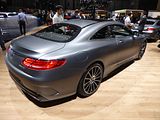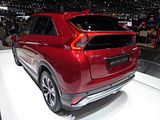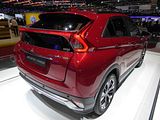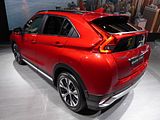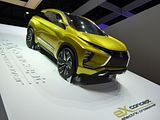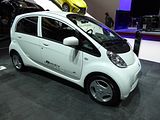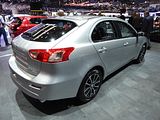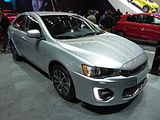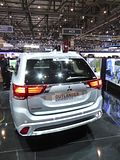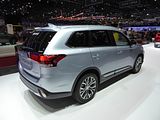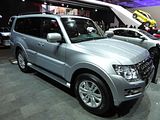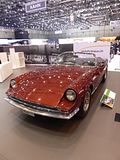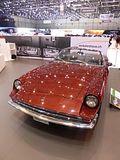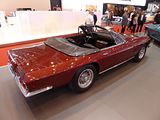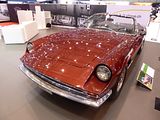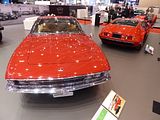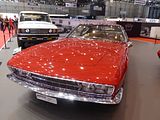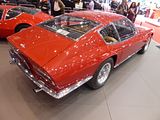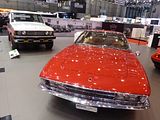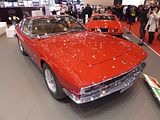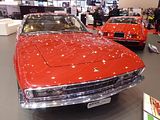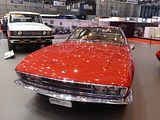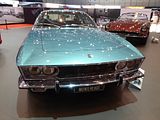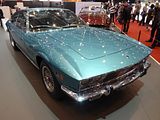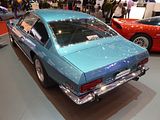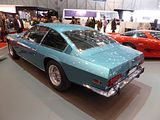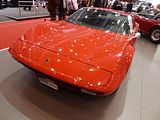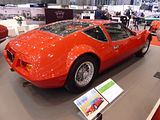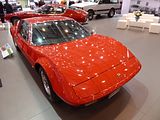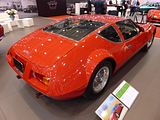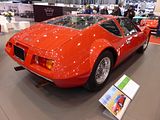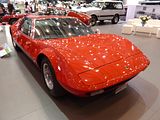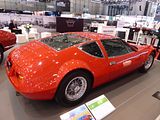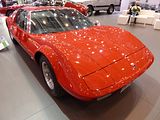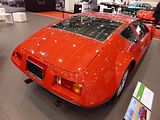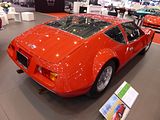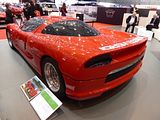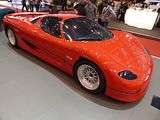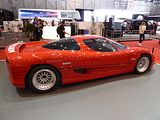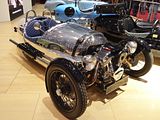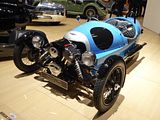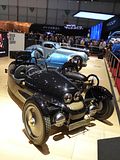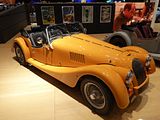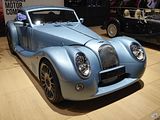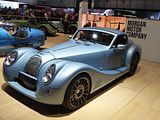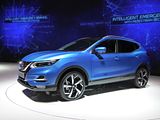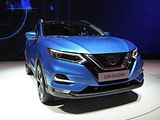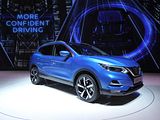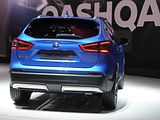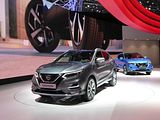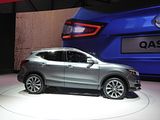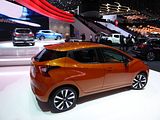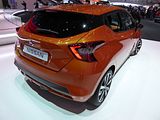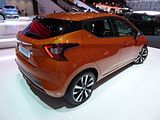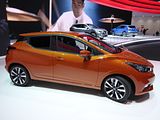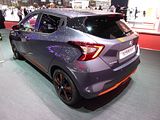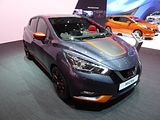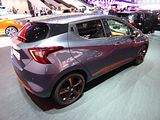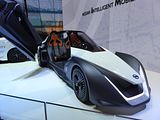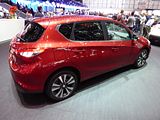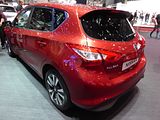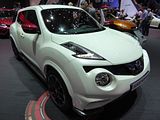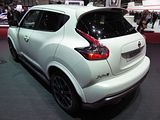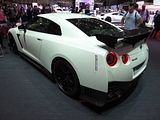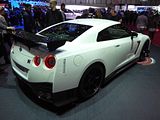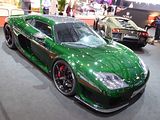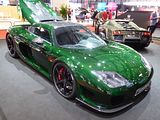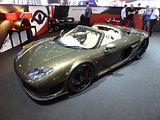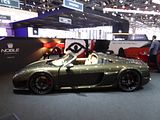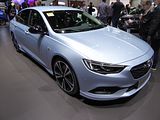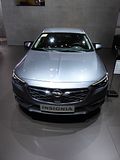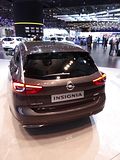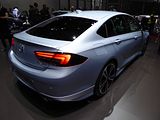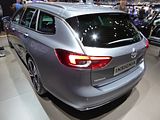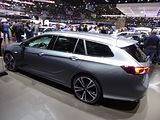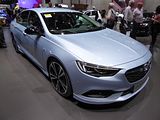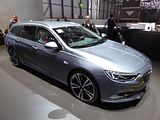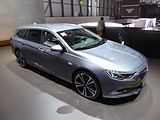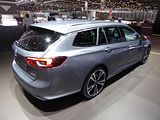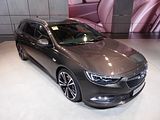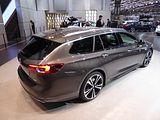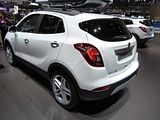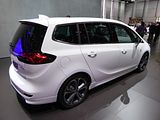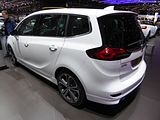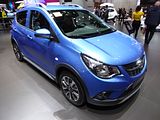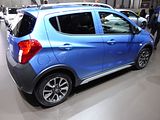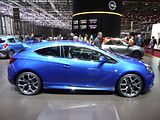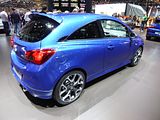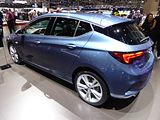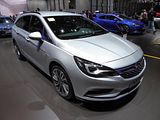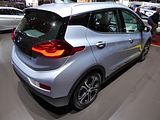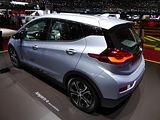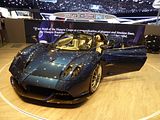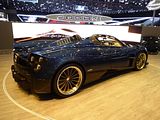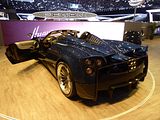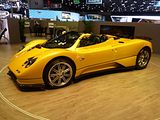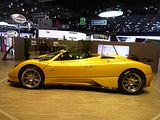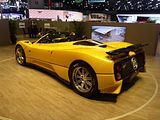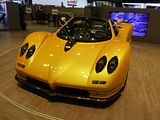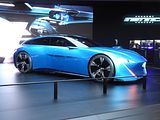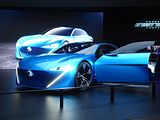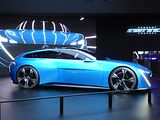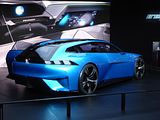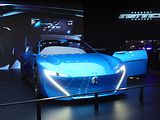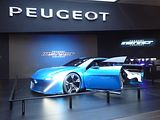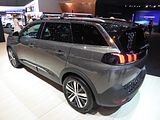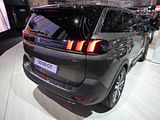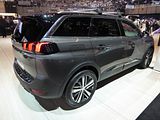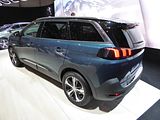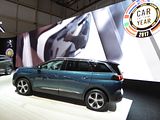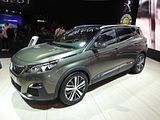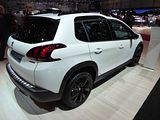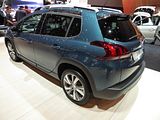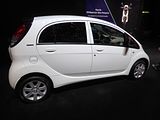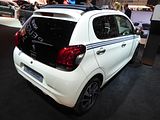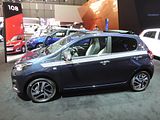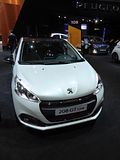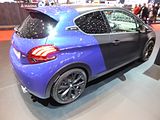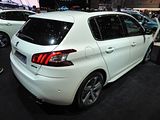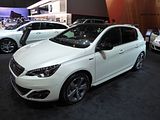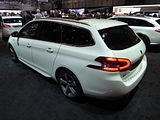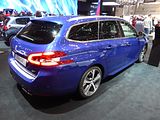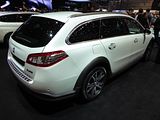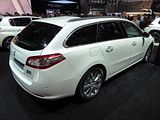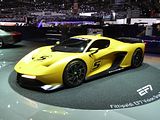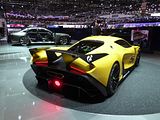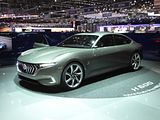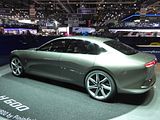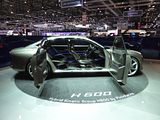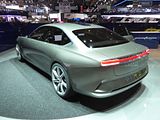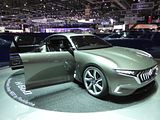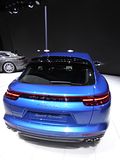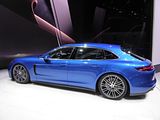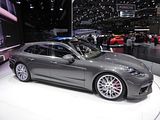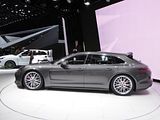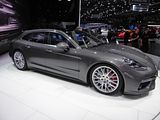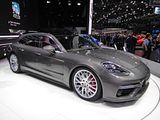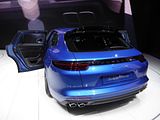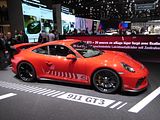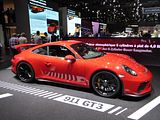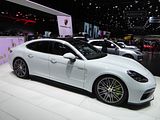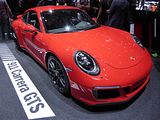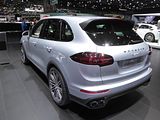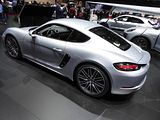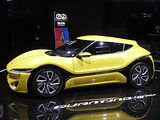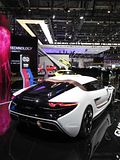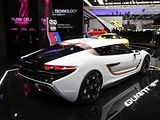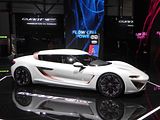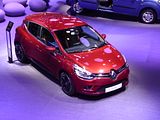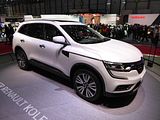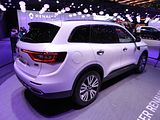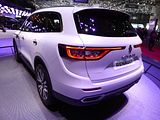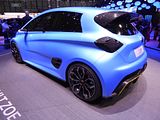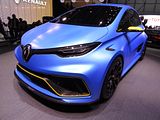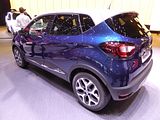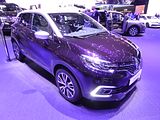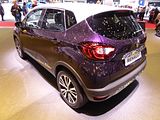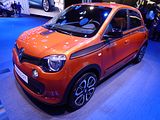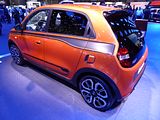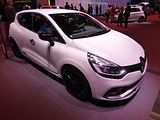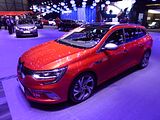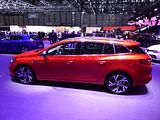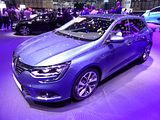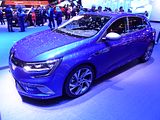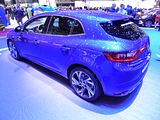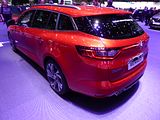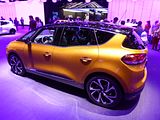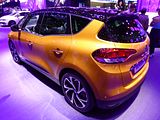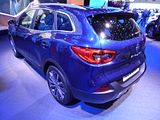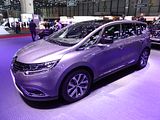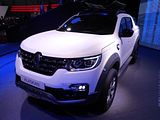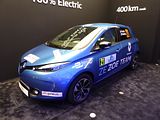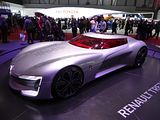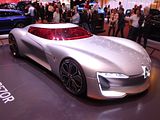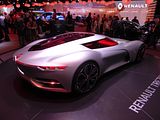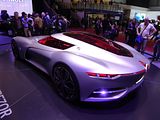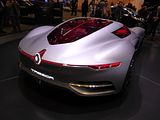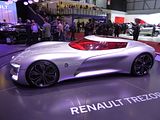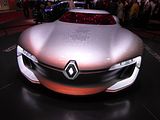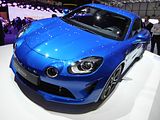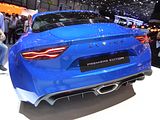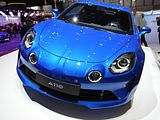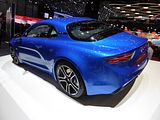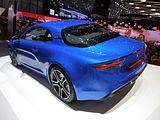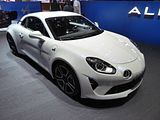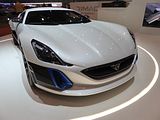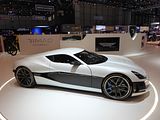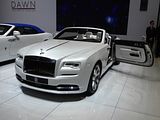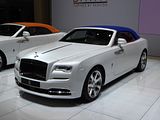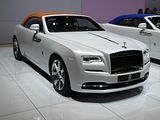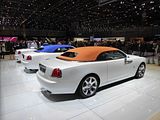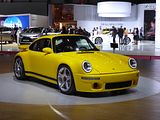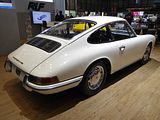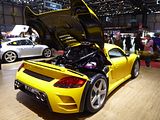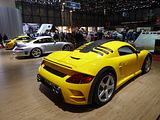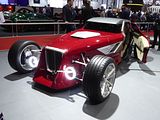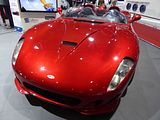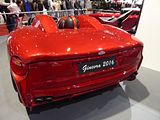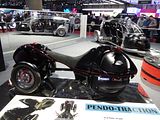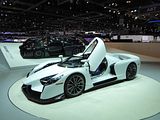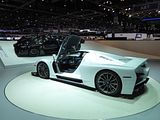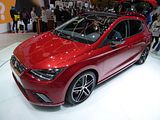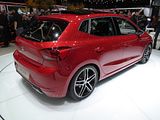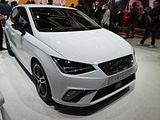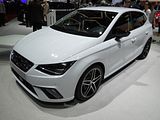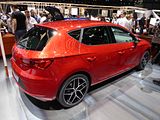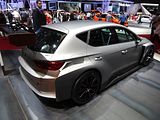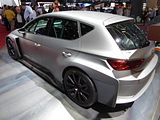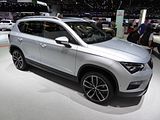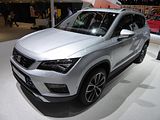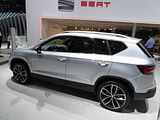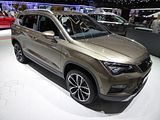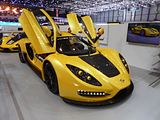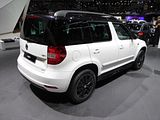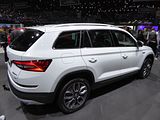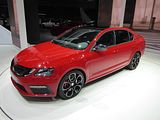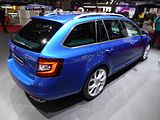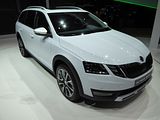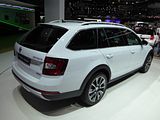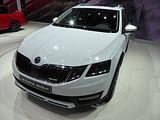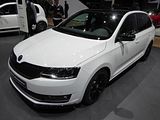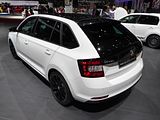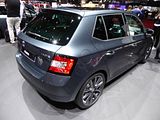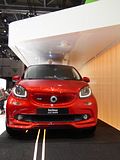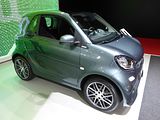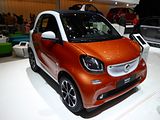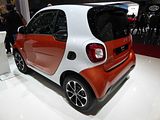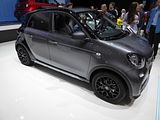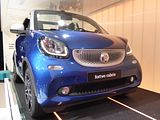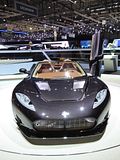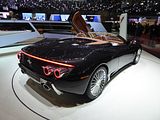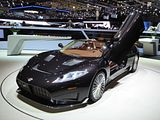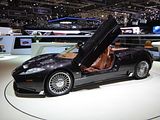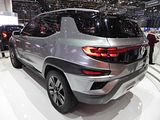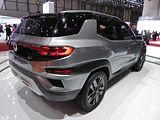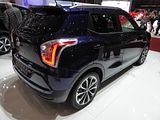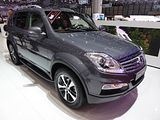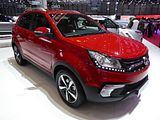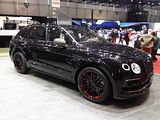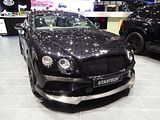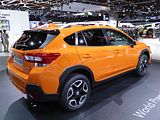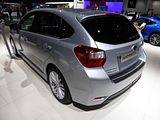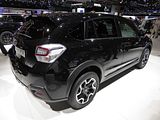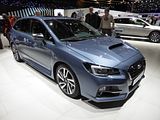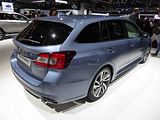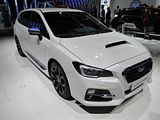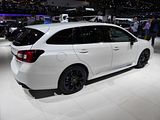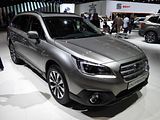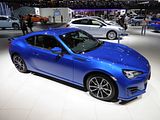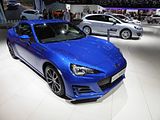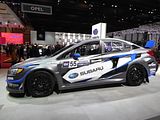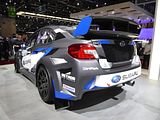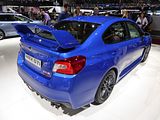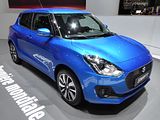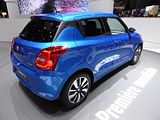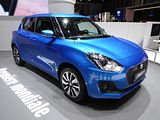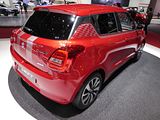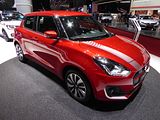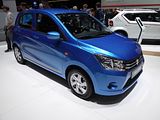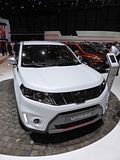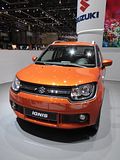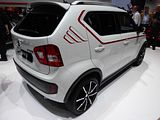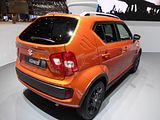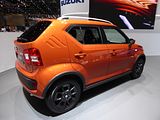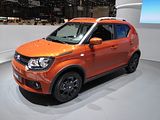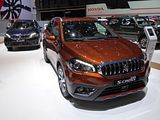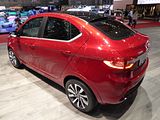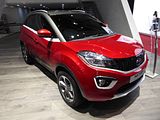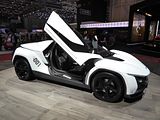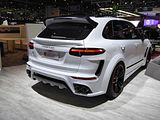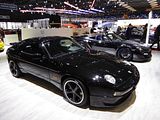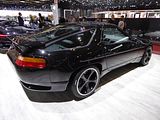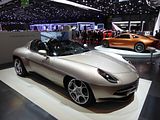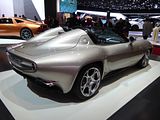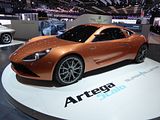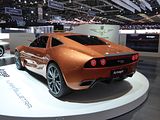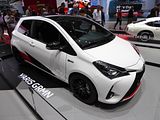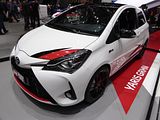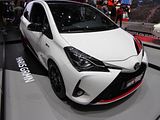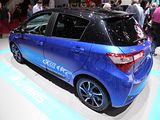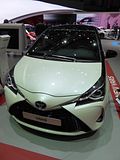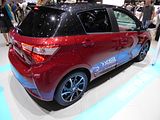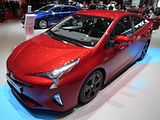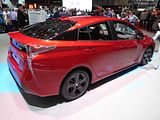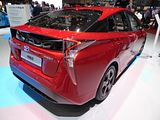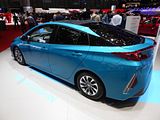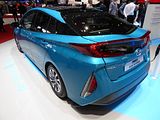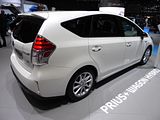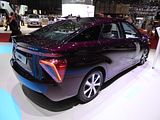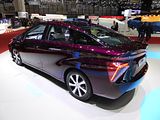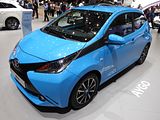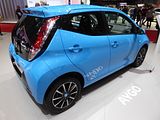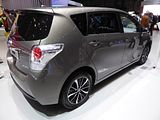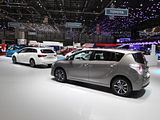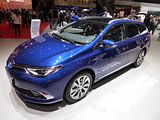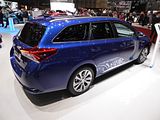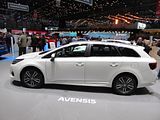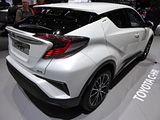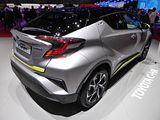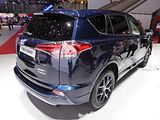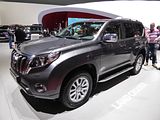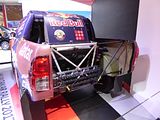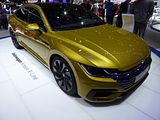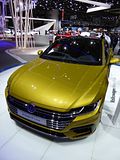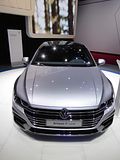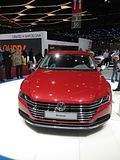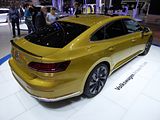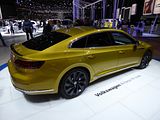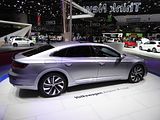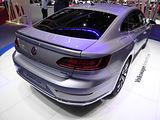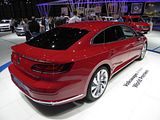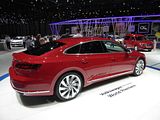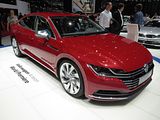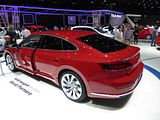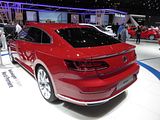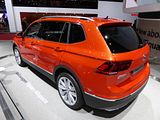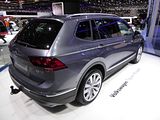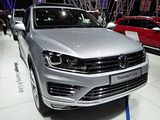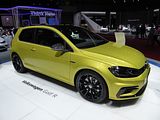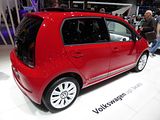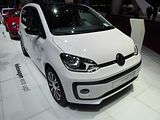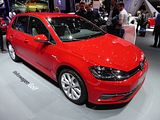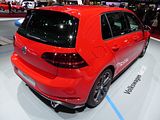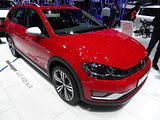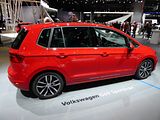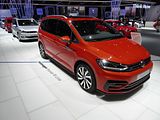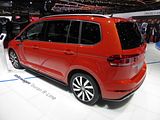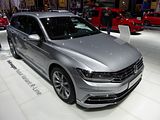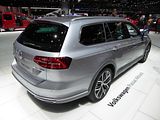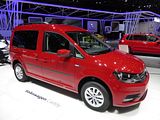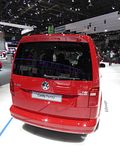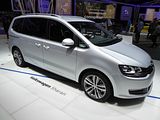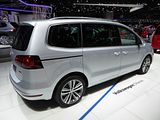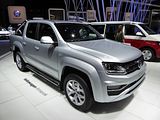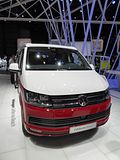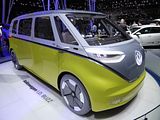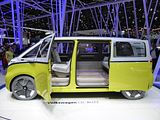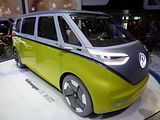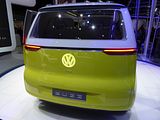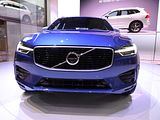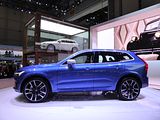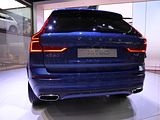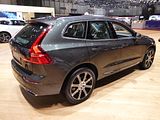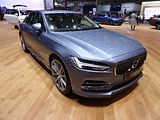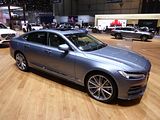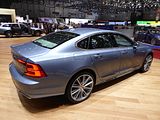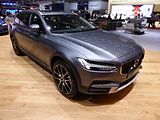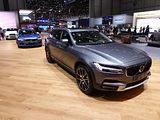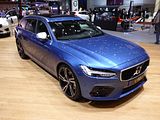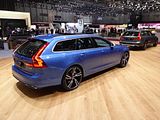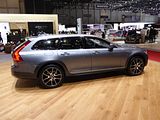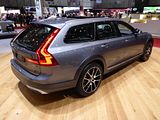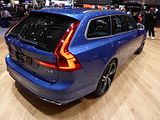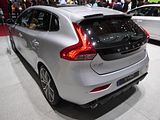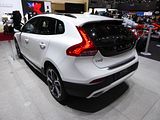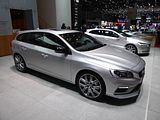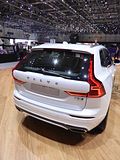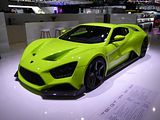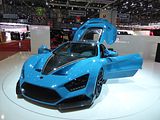I made my first visit to the Geneva Show back in 2000. Finding myself working in Switzerland, it was an easy train ride across the country from Zurich to Geneva, to go and visit my first foreign motor show, one I had read about since childhood in motoring magazines such as Autocar, but never really thought I would get to attend. Although my time working in the country came to an end at the conclusion of 2009, the era of the internet and low cost flights has made it easy to find viable and affordable ways of visiting, helped by the fact that the show is held in the PalExpo which is a 5 minute walk from the terminals of the airport., and so I have managed to maintain an annual visit every year with the exception of 2012 when a lengthy vacation in Australia clashed in my calendar. Whilst flights are easy to get, hotels are not so readily available, and certainly not at a budget-friendly price, and the only solution is to book early. So my 2017 trip was booked back in June 2016, and I thought that this level of forward planning would ensure I did not miss out on what is always one of the nest trips of the year. Roll forward to a few days before the 2017 event, just as the leaks and rumours turn into press releases, and a critical set of activities at work looked like I was going to have head off to the US several days earlier than a planned vacation 10 days after my Geneva trip. There was no way that I could fit everything in, and with great reluctance, I had to cancel the trip – much to the chagrin not just of me, but also the friends who I would travel with. And yet – here is a report. So yes, I did get to go. It is too complex a story to detail, but suffice to say that when it came to trying to book up the complex logistics of a work trip in Memphis that dove-tailed with a vacation in the US West Coast, the random number generators that airlines use on pricing their flights made the early departure to the US a complete non-starter. That meant that Geneva was back on, but not to the original schedule. Careful perusal of every carrier and departure airport I could reasonably get to revealed that I could make a day trip, from Heathrow, arriving around the time the show would open, and leaving after it closed. One full day is tough, to get to see it all, but it was all I was going to get – and thanks to Avios, it was still possible to rescue my plans to see the 2017 new metal. It was a long day. A really long day, but a great day, with a huge amount of new stuff to see, with over 150 global or European premieres, more than there were at Detroit, Los Angeles and Chicago combined. The Show did get very busy within minutes of arriving, but clearly a lot of people have less stamina than me, as by mid-afternoon, it started to empty out, and the last couple of hours were really quite calm, allowing the photographer to get all those pictures which were just too obscured earlier in the day. All told, there are 1350 photos here (yes, in one day!), and with the exception of Hall 7 (which contains the components, and after-market stuff that holds little interest for me), I think I got the chance to see most of what was on display. There was not time to linger on stands having lengthy conversations, as I have done in previous years, and certainly not to even try to blag my way into the champagne-fuelled hospitality of many of the higher-end brands (and experience suggests that most brands refuse, some more politely and firmly than others!). Here. then is a picture-heavy review of the (European) car market of 2017, with plenty of background information on the newer cars and concepts. There was lots that I liked, and plenty that I did not – some of the latest styling trends are an unpleasant combination of awkward, brash, clumsy, ugly and vulgar all in one go. There is a personal highlight from the displays – the identity of which may surprise you – which was perhaps the “car of the show” for me. To find out what that was, read on:
ABARTH
Like many brands, Abarth issued a series of teasers in the weeks leading up to the Show, leading to much speculation among Abarth Owners Club members as to what was coming. Popular guesses were that we might see the much rumoured Abarth 500X, or perhaps a Coupe version of the 124 Spider. Both guesses turned out to be wrong, with those cars perhaps destined for a reveal later in the year. Instead, they simply presented new versions of the established models. The one which will doubtless sell in the greatest quantity is the new 595 Pista. Available in both body types – hatch and convertible – and five body colours with contrasting details: Campovolo Grey, Gara White, Abarth Red, Record Grey and Scorpione Black, the Pista comes with the 1.4 T-jet 160 HP engine, which gives a top speed of 216 km/h and 0 to 100 km/h in 7.3 seconds. It has perforated and ventilated brake discs, Koni rear suspension with FSD technology and the Abarth Record Monza exhaust with Dual Mode and four tailpipes. As standard, the Pista has a five-speed manual transmission but it can be fitted with an Abarth robotised sequential transmission with shift paddles on demand. Standard are also the matt black 17″ “Formula” alloy rims with 205/45 tyres and fog lights. Owners can choose the colour of the front and rear bumper insert, the rear-view mirror caps and the brake callipers (black, red or yellow). Door handles and the specific “595 Pista” badge holder have a titanium finish. Standard on the convertible version is an electrically operated top and the rear parking sensors. Optional equipment includes the aerial concealed under the 595 aluminium cap on the roof, Xenon headlights, tinted rear windows and “Sky Dome” electric glass sunroof on the sedan version. Height-adjustable, fabric or – optionally – leather Abarth sporty seats, instrument panel with 7″ TFT colour display, matt grey dashboard fascia, manual climate control system and sporty leather steering wheel with viewfinder complement the interiors. Automatic climate control and electrochromic rear-view mirror are available on demand. Other equipment on Abarth 595 Pista includes the state-of-the-art UconnectTM infotainment system with 7″ HD touchscreen, DAB, six speakers, Bluetooth® with audio streaming, USB/AUX ports and Live services, which can be used to access a number of different applications. The system can be used to log into Facebook and Twitter directly, play over 35 million songs on Deezer and tune to 100,000 radio stations with Tuneln. Reuters News offers real time updates, while the TomTomLive services provide information on traffic, weather and speed cameras. The name of the special series – Pista, Italian for track – makes clear reference to the racing vocation of the model and to the one-of-a-kind features of the Abarth Telemetry system. More in detail, the next-generation capabilities of the infotainment system include the possibility of loading some of the most famous racing circuits in the world, like Monza, Spa-Francorchamps or the Red Bull Ring to name a few, selecting them during track sessions, viewing detailed maps and receiving real-time tips to improve lap times. In this way, Abarth 595 Pista drivers can access their recorded sessions and analyse their performance at any time. There is more: the Routes function can be used to create customised courses, access previously created ones, record GPS traces for each course and analyse then later.
Also new was the Abarth 695 XSR Yamaha Limited Edition and Yamaha XSR900 Abarth. For the third year running, Abarth will be Official Sponsor and Official Car Supplier of the Yamaha Factory Racing Team which will be competing in the 2017 FIM MotoGP World Championship. In the wake of the thrilling Abarth 595 Yamaha Factory Racing and the 695 biposto Yamaha Factory Racing Edition comes the new Abarth 695 XSR Yamaha Limited Edition special series, available exclusively with a Pista Grey livery: only 695 sedans and 695 convertibles will be made. The new car was created to celebrate the Yamaha XSR900 Abarth, which is the first exclusive motorcycle to spring from the collaboration between the two brands and which sports the same grey livery with red trim as the 695 XSR, as well as sharing many of its features. The special series makes extensive use of carbon fibre to demonstrate its affinity with the front fairing, front mudguard and saddle cover of the two-wheel Yamaha. The Abarth 695 XSR and the Yamaha XSR900 Abarth also share Akrapovič ultralight exhaust developed in the racing world to boost the personality, sound and performance of both vehicles. On the Abarth car, the carbon fibre tailpipes enhance the looks and technology of the exhaust system. The XSR logo on the tailgate distinguishes the Abarth 695 XSR, while an aluminium badge identifies the sequential number of 695 units for each body type. Other carbon fibre details, in addition to the mirror caps and Akrapovič tailpipes, are available as optional equipment, such as dashboard fascia, pedal covers, gear knob and kick plate. A 1.4 T-Jet engine delivering 165 HP sits beneath the bonnet. Equipment on this special series includes Koni rear suspension and Eibach springs, 17” Supersport alloy rims with Matt Black finish, Satin Chrome accents on handles and badge supports, red details on bumpers and mirrors, red brake callipers and a braking system with perforated discs. This version can be customised even further using the tuning kit to increase the power to 180 HP, improve handling by fitting a Koni front suspension with FSD (Frequency Selective Damping) valve and make braking even prompter with 305x28mm perforated and self-ventilating Brembo floating front discs with high-performance Ferodo HP 1000/1 front brake pads. It also features the new UconnectTM 7″ HD LIVE system integrated with Apple CarPlay allows iPhone users to access contents such as Apple Maps, Messages, telephone calls, Apple Music, also with Siri voice assistance.
There were two examples of the Abarth 124 Spider on show. The first, a “standard” car had pastel “Turini 1975 White” paintwork and a matt black bonnet that recalls the classic Abarth 124 Rally, on which this was adopted as a measure to prevent glare in the driver’s eyes. The other colours available in the range are pastel “Costa Brava 1972 Red” and the metallic “San Marino 1972 Black”, “Isola d’Elba 1974 Blue” and “Portogallo 1974 Grey”: these names are a homage to the prestigious Abarth rally wins. Interiors are characterised by red and black leather seats, while the dashboard and central tunnel are covered with Alcantara, a technical fabric used in the racing world to reduce reflections in the passenger compartment and increases the driver’s concentration on the task at hand. The second car is an example of the new Scorpione special series, a version designed for customers “seeking the essence of unadulterated driving pleasure”. The car on display sports a “San Marino 1972 Black” livery with “Forgiato Grey” details. A “Turini 1975 White” version is also available. The Scorpione maintains all the features of the 124 spider and is characterised by black microfibre and leather seats designed to maximise grip. Under the bonnet of both models is a 168bhp 1.4 litre four-cylinder turbocharged engine with MultiAir technology, which gives a top speed of 232 km/h and goes from 0 to 100 km/h in 6.8 seconds paired with a six-speed manual transmission. What is more, since the engine sound is a fundamental element of all Abarth cars, standard equipment includes Record Monza exhaust with Dual Mode system capable of modifying the path of the exhaust gas according to pressure, guaranteeing linear torque and power delivery and generating a satisfying, deep roar at the same time. In addition to the 6-speed manual transmission, the spider is also available with the Esseesse Sporty Sequential automatic transmission. The suspension on the Abarth 124 spider uses a double wishbone scheme at the front and a 5-arm multilink architecture at the rear. The set-up is calibrated specifically to increase stability on corners and enhance compression braking. Steering feedback is optimised by adopting a specific sports calibration of the power steering system. Both cars on show were equipped with the Sound Plus Pack, which includes radio 7″ touchscreen and a sophisticated Bose audio system with subwoofer and eight speakers, two of which integrated in the head restraints for a perfect listening experience. there is also the Visibility Plus Pack, which features full LED automatic self-levelling headlights, LED daytime running lights, rain sensor, dust sensor, headlight washer and rear parking sensors.
The stand itself was designed to be reminiscent of the feeling of Officine Abarth made of iron girders, rough concrete and metal floor plates polished by car tyres. For the public, it was intended to evoke the feeling of isiting the real workshop of a mechanic who is working with skilfully dedication on an engine. It is Carlo Abarth’s heritage, one made of hand-crafted care applied to constant technical progress and performance.
ABT
First of many after-market tuners that will feature, ABT specialise in VW Group products and they had 4 modified Audis and a Formula E racer on their stand. Revealed here was their own take on the Audi R8, for those who can’t live with the factory looks of the German supercar. Visually, ABT’s package adds new bumpers on both ends, along with carbon fibre front lip, front, side and rear blades, and mirror covers. Coming to complete its look are the forged 19-inch ABT High Performance ER-F wheels, finished ‘black magic’, or larger 20-inch GR, in ‘anodized black’. ABT Individual also gave the interior a few upgrades with leather and carbon trim, in addition to a set of special floor mats, and ‘ABT’ entrance lighting that greets whoever opens its doors. Technically, the tuner claims to have shed 50 kg (110 lbs) from its weight, while adding 20PS (20hp) to the sonorous 5.2-litre naturally aspirated V10 engine, bringing its total output to 630 PS (621 HP). The power boost comes from the optimized airflow and a new stainless steel exhaust system, with carbon double tailpipe trims. A new coilover suspension, springs and sports stabilisers on both axles, promise to improve handling.
After announcing a new power upgrade for the latest Audi SQ7 in December last year, ABT has now released a matching wide-body and interior styling kit for the diesel-powered SUV. ABT’s exterior makeover consists of a number of new parts, including a front apron, fender extensions, rear diffuser add-ons, roof spoiler, fender inserts and side sills, along with carbon fibre front grille and exhaust tips, and 22-inch wheels, which together, give the SQ7 a more masculine (but also, convoluted) appearance. The interior gets some love from ABT Sportsline as well, through available custom leather surfaces with contrasting seams, floor mats and carbon fiber trimmings covering everything from the dashboard to the consoles and steering wheel. Powering the regular SQ7 is a 4.0-litre V8 diesel producing 435PS (429HP) and 664 lb-ft of torque. ABT’s optimised computer brain gives the eight-cylinder TDI an 85PS and 70Nm boost to 520PS (513hp) and 970Nm (715 lb-ft) respectively, which reduces the 0-100km/h (62mph) sprint by 0.2 seconds over the standard model to 4.6 seconds.
ABT have also come up with a limited edition of the Audi TT RS. Baptised the TT RS-R, the German sports car will be produced in just 50 units, each of them having their 2.5-litre five-cylinder TFSI petrol engine massaged to deliver an impressive 500 PS (493 HP) and 570 Nm (420 lb-ft) of torque. This is a 100 PS (99 HP) and 120 Nm (89 lb-ft) of torque increase over the stock version of the TT RS, which was obtained by optimising the motor management. ABT have yet to release any performance numbers, but their blue-blooded vehicle will likely slash something off the standard car’s 3.7 second run 0 to 100 km/h (62 mph). Besides messing with its heart, the tuner updated the skin too, with a front spoiler, grille frame, side skirt add-ons with side blades, and a multi-part rear skirt, all made from carbon fibre. There’s also a stainless steel exhaust system, with double tailpipe trims, alongside a set of 20-inch ABT Sport GR wheels, finished in glossy black, while rounding up the visual drama are the suspension springs and sports stabilisers, fitted on both axles. As for the interior, it fell in the hands of ABT Individual to add a carbon coating to the side of the dashboard panel and seat panels.
Final car on show was based on the RS6 Avant. Christened the Audi RS6+, only 50 examples will be made, and all of them will come with 705 PS (695 HP) and 649 lb-ft of torque, courtesy of a power boost that uses an in-house developed control unit. This means that the super estate now has 100 PS (99 HP) and 96 lb-ft of torque more than the standard car. ABT have yet to release any acceleration numbers, but the standard model needs just 3.7 seconds from nought to 100 km/h (62 mph), and 12.1 seconds from 0 to 200 km/h (124 mph). Signalling the presence of the extra muscle are the new add-on parts that come with a dark carbon fiber look and include a set of skirts all around, along with a front lip, side mirror casings and wheel arch vents. Other features are the special badges, stainless steel exhaust system, carbon double tailpipe trim, and 22-inch alloy wheels with a glossy black or matte black look and different patterns. Inside, ABT’s Audi RS6+ comes with carbon fibre-made dashboard and seat panels, integrated entrance light that projects the ‘RS6+’ logo onto the asphalt, special floor mats, including the one in the boot, gearshift lever badge, and a steering wheel design in carbon and leather.
AC SCHNITZER
AC Schnitzer are renowned for their work on tuning BMWs, and this extends to the German carmaker’s flagship sports car, the i8, a new version of which it unveiled here. The latest tuning job sees the BMW i8 dropped closer to the pavement – by 25 mm (or nearly an inch) at the front and 20 mm at the rear – and fitted with a whole lot of extra carbon-fibre bits. The list of upgrades include a new front spoiler, winglets, split hood vent, rear wing, side skirts, and three-piece diffuser, all crafted from the lightweight woven material. The door handles and side mirrors are made from the same, joined by restyled front kidney grilles and a red chrome finish. Naturally the wheels have been upgraded as well with 21-inch split-spoke forged alloys that save nearly 10 pounds at each corner.
One year after unveiling its monstrous 570 hp ACL2 Concept, AC Schnitzer has released a more sane and approachable version dubbed the ACL2S.Based around the BMW M240i, just 30 units will be produced each priced at €35,900, for the entire upgrade package. Of course, that excludes the cost the base M240i itself. In creating the ACL2S, AC Schnitzer has reflashed the ECU of the turbocharged straight-six engine while also fitting a custom air intake, exhaust and downpipe. These modifications lift power from 340 hp to 400 hp and 442 lb-ft of torque, more than enough to scare BMW M2 and even M4 owners. To provide the sports car with even greater performance, the tuner has also installed adjustable suspension which allows the owner to tweak the height, compression and rebound. Visually, the ACL2S is easily distinguishable from the model around which it is based. In particular, it is adorned with a 10-piece widebody kit that includes flared wheel arches, revised bumpers, a bespoke carbon fibre front splitter, new diffuser and the availability of a large carbon rear wing or a smaller, trunk lid spoiler. There’s also some AC Schnitzer AC1 wheels to complete the exterior look. Interior changes are relatively minor but do include a three-spoke leather steering wheel, aluminium pedals and “One of Thirty” badges.
ALFA ROMEO
This was a busy stand, which is hardly a surprise, as Alfa have two new ranges of cars which have had a very positive set of reviews from the world’s press which lots of people clearly wanted to see. The model that most probably had not come across in the metal before was the Stelvio SUV, which was premiered at the Los Angeles Show and then had a European launch just a few weeks ago. A range of models will be available, with the “regular” Alfa Romeo Stelvio, arriving hot on the heels of its exclusive ‘First Edition’ counterpart, as well as the flagship Quadrifoglio version. Potential European suitors will be able to choose between three trim levels when purchasing the car, namely the Stelvio, Stelvio Super and Stelvio Tecnica. The engine range will initially consist of just two units, a 280 HP 2.0-litre turbocharged petrol and a 210 HP 2.2-litre diesel, both with an 8-speed automatic and Q4 all-wheel drive. In terms of trim levels, the UK version of the base Stelvio features 17″ alloys, an 8.8″ display, Alfa’s D.N.A Rotary selector, 8-speaker audio system, black fabric seats, Integrated Brake System, Lane Departure Warning and Forward Collision Warning with Autonomous Emergency Brake and pedestrian detection. This version also comes with parking sensors, cruise control, electric tailgate and dusk & rain sensors. Moving up in the range is the ‘Stelvio Super’ model, which adds 18″ wheels, techno-leather and fabric seats (black, black/brown & black/red), as well as three options for the dashboard and door panels in the same color combo as the seats. Customers looking for more can explore the additional Luxury Pack and Sports Pack, where the former adds full grain leather seats (black, brown, red or beige), with electrical adjustment and heating, and real wood inserts. The Sport Pack offers a heated sports steering wheel, racing-style leather seats (black, red or brown), aluminium inserts and steel pedals. Sitting atop the Stelvio’s UK range is the Tecnica version (called Business in other markets), available exclusively with the 2.2-litre diesel and boasting the 8.8″ Alfa Connect 3D Nav (also available without a GPS signal thanks to the Dead Reckoning technology), Bi-Xenon headlights with AFS and electric folding mirrors. Within the options list, buyers will find a 10 speaker system with four woofers, four tweeters, a mid-range and a subwoofer in the boot, but also a 14-speaker Harman Kardon system with four woofers, four tweeters, five mid-ranges and a subwoofer. In terms of performance, the previously mentioned diesel unit is capable of taking the Stelvio from 0 to 62 mph (100 km/h) in 6.6 seconds, whereas the 2.0-litre turbo petrol can do the sprint in just 5.7 seconds. In the handling department, Alfa Romeo made sure to give the Stelvio a 50/50 weight distribution in order to aid driving comfort, whereas the new double wishbone suspension with its semi-virtual steering axis is responsible for the SUV’s “rapid and accurate steering.” The Q4 all-wheel drive system turns the Stelvio into a rear-wheel drive vehicle with 100% of the torque sent to the rear axle during normal conditions. As grip fades, the system transfers up to 50% of torque to the front axle for best-in-class control in terms of traction and directional stability, according to Alfa Romeo. The Stelvio reaches the UK in the summer.
There were plenty of people pouring over the Giulia models here. The Quadrifoglio model may be getting all the headlines – and rightly so, as it is clearly a very worthy match for the BMW M3 and Mercedes-AMG C63 – but it is the less potent versions which must deliver in the showrooms. All the omens are good, but only time will tell if this car really can get customers out of their German premium saloons and into a stylish Italian.
All this interest in new models left the lone 4C Spider looks a bit forgotten about, which is a shame, as this characterful and elegant car still has lots to offer, even if the arrival of the Renault-Alpine A110 is about to give it another rival.
There were single examples of the established Giulietta and MiTo here. Both these were tweaked during 2016 in a bit to keep them fresh. All the signs are that they are going to have to continue for some time yet, whilst Alfa ponders whether to replace them or whether to vacate their respective sectors of the market in favour of more profitable SUVs.
ALPINA
Star of the Alpina stand was the new F30 5 Series-based B5 which made its world debut here. Both saloon and Touring versions of the hot 5 Series variant will use BMW’s 4.4-litre unit, which in twin turbo guise generates 600 bhp and 590lb ft of torque. The new car accelerates from 0-62mph in 4.2sec and tops out at 204mph. That performance will rank the new Alpina close to the next M5, which is predicted to produce around 600bhp. BMW won’t be producing an M5 Touring, so the B5 Touring will be the hottest estate on offer in the new BMW 5 Series range. The petrol V8-powered B5 will be joined by a more fuel-efficient diesel-engined equivalent called the D5, which is yet to be shown. This will also be available as a saloon or estate and will most likely have a turbocharged straight-six engine with around 400bhp and close to 600lb ft. The unit will be a developed version of the six-cylinder powerplant used in the new BMW 5 Series 550d, which produces 395bhp and 560lb ft. As a result, the Alpina D5 is expected to have a sub-five-second 0-62mph time as well as combined fuel economy of around 50mpg. Both the B5 and D5 have Alpina’s own exterior styling and familiar multi-spoke wheels. Performance-honed suspension and gearbox settings will also give the two hot estates sharper responses than those of BMW’s regular estate offerings. UK pricing is yet to be confirmed, but a starting figure close to £100,000 is expected for the B5 models. The D5 will likely be closer to £60,000 when it arrives.
Alpina also used the show to reveal revised B3 S and B4 S Biturbo models with more powerful 3.0-litre straight-six engines that produce 434bhp and 443lb ft of torque. That gives the models 9bhp and 37lb ft more output than BMW’s M3 and M4 models, and enables the B4 S to accelerate from 0-62mph in 4.2sec, with the B3 S taking a tenth longer. Top speed for both models is 190mph. The extra performance comes thanks to two new Alpina turbochargers and a new high-performance cooling system with an external water cooler and external oil cooler which have grown in capacity by more than 15 % and 35 % respectively. The new system helps torque arrive at 2000rpm; it remains at peak output until 6000rpm. The engine comes mated to a ZF eight-speed automatic gearbox in both variants, and breathes through an Akrapovič stainless steel exhaust system that weighs less than BMW’s equivalent. The B3 S and B4 S come in rear or all-wheel drive forms. The B3 S is available in saloon and Touring guises; the B4 S comes in coupé or convertible bodystyles.
Completing the Alpina display was an example of the B7, based on the latest G10 model 7 Series, which was revealed at the 2016 Show. This also boasts 600 bhp from its 4.4 litre twin turbo V8 engine, and is the nearest thing you can get to an M7, a car which BMW has never built.
ASTON MARTIN
Aston Martin have been talking about their latest hypercar that they were co-developing with Red Bull Advanced Technologies for a while, and now it has a name: Valkyrie, which stems from Norse mythology and translates to ‘chooser of the slain’. Previously the car had been referred to by its internal name AM-RB 001. Aston Martin chose Valkyrie, the name of a type of God that Nordics believed chose who lived or died, to signify the car’s role as being its most potent product yet. The Aston Martin Valkyrie hypercar will use a naturally aspirated Cosworth 6.5-litre V12 that’s expected to produce 900bhp. It uses a seven speed Riccardo transmission. Valkyrie will be built upon a carbonfibre MonoCell that is provided by longstanding Aston Martin partner Multimatic. Total kerb weight is therefore expected to be less than one tonne, and Aston Martin backs this up with claims for a 1:1 power-to-weight ratio. The car will use an F1-inspired energy recovery system (ERS) to harvest kinetic energy from braking, with electric car maker Rimac supplying lightweight hybrid batteries. Braking will be handled by Alcon and Surface Transforms calipers and carbon discs, while Bosch will supply the engine control unit, traction control unit and electronic stability programme systems. The tyres are Michelin Pilot Sport Cup 2s wrapped around 20 and 21in wheels. Aston Martin has also confirmed that Wipac, a British lighting manufacturer, has developed the car’s LED headlights and tail lights. Aston Martin will build a total of 150 units for the road and 25 track only versions. No pricing has been revealed but a figure of between £2-3 million is likely. First deliveries are due in 2019.
With the Rapide AMR and Vantage AMR Pro, Aston Martin launched a new, limited edition hardcore performance sub-brand that will be applied to all future model ranges, including its upcoming SUV. AMR models will draw on the firm’s racing past and present, offering enhanced performance, sharper dynamics and more extreme styling. Described by Aston Martin chief creative officer Marek Reichman as the “cherry on the cake” of every Aston model in its range, AMR cars will be road-legal, while AMR Pro cars will be track only and developed separately from other models by the Q by Aston Martin bespoke division. The Rapide AMR is described by its makers as “the world’s most thrilling four door”. It is powered by the 592bhp V12 from the Vantage GT12, running through a new quad exhaust system. It has a top speed of 210mph. It is finished in Stirling Green with lime green accents, has 21-inch wheels and a revised grille, front splitter, side sills, rear diffuser and aero spoiler on the rear. Inside there is extensive use of carbonfibre, including lightweight seats and trims. 210 cars will be made. The Vantage AMR Pro is powered by a 500bhp version of the championship-winning GT4’s V8 race engine. It also has race-spec adjustable suspension, engine and transmissions mounts and centre lock wheels and race tyres. Aston Martin says it offers “inspirational handling precision and exceptional levels of grip and traction”. Also painted Stirling Green with lime green accents, it also uses the bonnet and rear wing of the firm’s World Endurance Championship-winning racers. Other details include new front bumper, grille, splitter and rear diffuser designs. Inside, carbonfibre dominates again, as well as the roll cage. Just seven Vantage AMR Pro cars will be sold. Owners of AMR cars will be offered driving tuition, as Vulcan buyers were, but Reichmann stressed that they had not been designed to be intimidating. “We can help people experience the full potential of these cars,” he said. “Remember our heritage is in endurance racing, where the cars are designed to be driven on the edge for lap after lap all the way to the end of a 24-hour race, rather than being wrung out over a single lap.”
Final announcement from Aston Martin for the show was a significant expansion to its bespoke Q division, specifically the new Commission division. Similar to Ferrari’s Tailor Made setup, Q by Aston Martin – Commission will handle any wild customisation requests owners may have. Further to this, Q Commission will be able to create totally bespoke vehicles offering its clientele greater design freedom than ever before. The formation of Commission comes on the back of the successful one-off CC-100 Speedster Concept and Vantage GT12 Roadster models which were handled by Q by Aston Martin. Aston also presented an additional extension to Q by Aston Martin dubbed Collection. At the time of specification, customers will be given a greater choice of trim options and paint finishes. To mark the launch of this expansion, the company had an Aston Martin DB11 finished in Zaffre Blue with forged carbon fibre details on show.
There was also a Vanquish Volante S on the stand.
There were also three Aston Martins elsewhere in the show, where they seemed to be generating surprisingly little interest. There was a Vantage GT8 racer on the Goodyear stand, a DB11 on the Bridgestone stand and a Vulcan on the Castrol stand
AUDI
Most striking car on the vast, and very busy Audi stand was the Q8 Sport Concept, a sporting 469bhp variant of the brand’s forthcoming Q8 large SUV. This is the second Q8 concept – the first was revealed at the Detroit motor show in January – and it runs a newly developed petrol-electric hybrid driveline that is claimed to endow it with 0-62mph acceleration in 4.7sec along with an overall range of up to 746 miles, in combination with an 85-litre fuel tank and 0.9kWh lithium ion battery pack. The new Audi is expected to be placed into production in 2018, acting as a range-topping model in the new Q8 line-up. Although officials at Audi’s Ingolstadt headquarters in Germany initially hinted the new SUV would wear RS Q8 badges, it now appears it will be marketed under the SQ8 name. The Q8 Sport Concept is outwardly distinguished from the earlier Q8 Concept by a series of stylistic upgrades aimed at endowing it with a more sporting appearance than its milder powered sibling. Included is a restyled single frame grille featuring a black frame and honeycomb lattice insert. The new grille is set within a more heavily structured front bumper housing enlarged air ducts and a more prominent splitter element in the form of a black blade along its lower edge. The headlamps have also been modified with darkened inserts but retain the same distinctive x-shaped LED graphics as the earlier concept to give the new Audi a rather sinister look from front on. Further back, there are black exterior mirror housings and black sills underneath the doors. Compared to the Q8 Concept revealed at the Detroit motor show in January, the wheel houses have also been widened by a further 12mm. The rear end of the new SUV is dominated by a full width tail lamp graphic set within a black panel. On the Q8 Sport Concept, the lower section of the bumper adopts a black diffuser rather than the silver element used by the original Q8 Concept. It also eschews the earlier trapezoidal shaped tailpipes for oval shaped exhausts, typical of Audi’s more performance orientated models. Rounding out the visual upgrades are new 23-inch alloy wheels with intertwining spokes. Some 11-inches in width, they come shod with 305/35 profile tyres and hide sizeable 508mm carbon ceramic brake discs. The first official photographs of the new Audi also hint at a lowered ride height for the Q8 Sport Concept in keeping with its sporting pretensions. At 5020mm in length, the Q8 Sport Concept is 30mm shorter than the Q7, with which it shares its platform, quattro four-wheel drive running gear and air sprung suspension. The petrol-electric hybrid driveline previewed by the Q8 Sport Concept is planned to feature in a number of new Audi models, including future incarnations of the A6, A7 and Q8 as well as the Q7 and a production version of the Q8 due out later this year. It is based around a twin-turbo 3.0-litre V6 direct injection petrol engine which borrows engineering solutions used by the twin-turbo 4.0-litre V8 common rail diesel used by the SQ7, including a 48-volt electrical system and an electrically powered compressor that operates at up to 70,000rpm to boost air supply and help improve low-end flexibility. Alone, it delivers 444bhp and 391lb ft of torque. The combustion engine is allied to a disc-shaped electric motor mounted within the front section of the Q8 Sport Concept’s eight-speed torque converter equipped automatic gearbox, delivering 27bhp and 125lb ft of torque. Together, they provide a combined system output of 369bhp and 516lb ft. Energy used to power the electric motor is stowed in a 0.9kWh lithium ion battery pack mounted within the floor of the Q8’s luggage compartment. Audi says the operating strategy of its new petrol-electric hybrid system allows the big SUV to move slowly in stop/start traffic with the combustion engine idled, as well as enabling manoeuvring and parking exclusively under electric power. During braking, a newly developed energy regeneration system employs the electric motor as a generator to recharge the battery. “The drive system of the Q8 Sport Concept is a major step towards optimizing efficiency. The combination of mild hybrid technology and combustion engines sets a new benchmark, and will in the future be used in many Audi models. Audi claims the production version of the Q8 Sport Concept will deliver 0-62mph acceleration in 4.7sec and a top speed of 171mph. The German car maker also says it will deliver an overall range of up to 746 miles on an optional 85 litre fuel tank.
One you can buy, in a few weeks time, anyway, is the new second generation RS5, the first of the RS models from the still-growing B9 generation of A4 and A5 cars which was unveiled here. As well as a new twin-turbo 2.9-litre V6 petrol engine developing 444bhp (the same as the 4.2-litre V8 in its predecessor), the new performance coupé also gets a new badge, and will be sold under the Audi Sport banner. Set for UK sale in June, this RS5 has been engineered anew from the ground up. Together with the new engine, the RS5 Coupé also adopts a new platform that sees it grow in size over the seven-year-old model it replaces. Further developments include a new chassis featuring a five link front and rear suspension coupled to Audi Sport’s Dynamic Ride Control system offering variable damping control. Distinguishing the RS5 Coupe from other recently introduced second-generation A5 Coupe models are a series of traditional RS exterior styling cues. They include a wider single frame grille featuring a high gloss black honeycomb insert, a new front bumper sporting larger air ducts and an intricate splitter element and headlamps with tinted graphics for the standard LED projectors. Further back, the front fenders have been widened by 15mm and feature so-called quattro blisters together with additional vertical air ducts along the outer edges of the headlamps. The exterior mirrors get a carbon fibre optic and the side sills have been widened with high gloss black elements to reflect the added performance potential of Audi Sport’s latest two-door performance car. At the rear, the RS5 Coupé receives wider rear fenders extending out some 15mm more than on the standard A5 with more pronounced quattro blisters, a subtle boot deck lid spoiler, a uniquely styled bumper housing a prominent diffuser in high gloss black and two signature oval tailpipes. The latest RS model rides on standard 19-inch wheels, with 20-inch wheels offered as an option. Two additional styling packages in either high gloss black or matt aluminium are also available. As part of a weight saving initiative, Audi Sport also offers the new RS5 Coupé with a carbon fibre roof, which is claimed to contribute to a 60kg reduction in kerb weight over the old RS5 Coupé despite a 74mm increase in overall length for the new model. The twin-turbo 2.9-litre V6 was developed in an engineering cooperation between Audi and its Volkswagen Group sister company, Porsche. The 90-degree unit is already employed in the second-generation Porsche Panamera S, where it delivers 434bhp and 405lb ft of torque. With unspecified changes, it gains 10bhp and 37lb ft, producing 444bhp and 442lb ft of torque between 1900 and 5000rpm in the new Audi Sport model. By comparison, the naturally aspirated 4.2-litre V8 multi-point injected engine used by the old RS5 Coupe delivered the same 444bhp and 317lb ft at a much higher 4000rpm. The reduction in kerb weight helps to provide the new 1655kg 2017-model-year RS5 Coupe with a power-to-weight ratio of 268bhp per tonne, or some 9bhp per tonne more than the old 1715kg first-generation RS5 Coupe, on sale in the UK since 2010. In a further change to the new Audi’s driveline, the latest RS5 Coupe forgoes the seven-speed dual clutch gearbox of its predecessor for an eight-speed torque converter equipped automatic from German specialist, ZF. It is allied to the latest version of Audi’s quattro four-wheel drive system that apportions drive in a rear wheel biased 40:60 split and also comes with an optional sport differential offering a torque vectoring effect for the rear wheels. Audi claims a 0-62mph time of 3.9sec, which is 0.6sec faster than the old RS5. Top speed is nominally limited to 155mph, though buyers can extend with to 174mph by optioning the new Audi with a so-called dynamic package. Inside, the new Audi Sport model receives a full complement of traditional RS interior appointments, including a unique RS display for the digital instrument graphics, a flat bottom multi-function steering wheel, heavily contoured sport seats and stainless steel pedals. Prices for the Audi Sport RS5 Coupé are due to start from around £63,000.
Also show-cased on the raised platform across the back of the stand was the last body style of the B9 generation to appear, the Cabrio. This actually made its global debut at the Los Angeles Show back in November, but this was the first time the open-topped models were being seen in Europe. As before, what you get here is an elegant looking machine which adopts the elegant yet, oh-so familiar, lines from its other siblings, dropping the former’s fixed roof for a newly developed top with one-touch automatic operation that opens in 15 seconds and closes in 18 seconds at speeds of up to 50km/h (31mph). At 4,673mm (183.9 in.) long, the new A5 Cabriolet is 47mm (1.9 in) longer than the predecessor model, while riding on a 14mm (0.6 in.) extended wheelbase at 2,765mm (108.9 in). Together with the more compact design of the seats, this leads to an increase of 18mm (0.7 in.) in rear knee room, with Audi stating that the new model also offers 26mm (1.0 in) additional shoulder room at the front, and an extra 60 liters of boot space at 380 litres (13.4 cu ft) total. The rear seat has a 50:50 split, with all A5 Cabriolets now featuring an automatic boot lid as standard, with gesture control offered as an option. All the tech, comfort and safety features found on the other A5 models are available on the Convertible, including the optional 12.3 inch digital instrument display, but it does get new seat belt microphones for driver and front passenger that promise improve voice quality even with the roof open. As with the rest of the A5s, the Cabriolet is built on the MLB Evolution platform, with Audi boasting that it has the stiffest body in its class, yet is also one of the lightest in the segment, dropping up to 40 kg (88.2 lb) over the outgoing model. The front-wheel-drive A5 Cabriolet with the 190 hp 2.0 TDI weighs 1,690 kg (3725.8 lb). The Cabriolet will eventually employ the same range of powertrains as the other two A5s, with Europe getting a 252PS 2.0 TFSI, a 190PS 2.0 TDI and a 218PS 3.0 TDI at launch for the regular A5, and a 354PS 3.0 TFSI V6 for the S5 which can reach 100km/h (62mph) in 5.1 sec and top out at an electronically limited 250km/h (155mph). A 190PS 2.0 TFSI petrol and a 286PS 3.0 TDI V6 diesel will join the lineup shortly after. Audi says that compared with the previous model, the engines offer up to 17 percent more power while consuming as much as 22 percent less fuel. Transmission choices depend on the model, and include a six-speed manual, a seven-speed S tronic dual-clutch auto or eight-speed tiptronic auto. Aside from the S5 and the 286PS 3.0 TDI that come from the factory with Audi’s quattro permanent all-wheel drive, all other models are sold with front-wheel drive as standard and optionally with AWD. The car shown here was an S5.
Besides the show-stealing RS5 Coupe, Audi brought along its g-tron models to their stand. The fuel is said to be produced using renewable energy from water and CO2, or from organic residual materials such as straw and plant clippings, helping g-tron models to cut emissions by 8- percent, compared to a petrol-powered car in the same performance class. Moreover, those ordering the A3 Sportback g-tron by May 31, 2018, will get access to a supply of this fuel for three years, as part of the standard package, and instead of a fuel card used as the accounting tool, customers will get a document that affirms their vehicles will be supplied with e-gas. Created using several processes in a number of European countries, including Germany, by the automaker and its partners, the e-gas, which is basically a synthetic methane, is fed into the European natural gas grid, thus replacing the amount of natural gas that g-tron cars consume, in the NEDC. Audi’s g-tron family will expand this year with the addition of two new vehicles: the A4 Avant and A5 Sportback. Set to launch in early summer, both of them will be powered by a 2.0-litre TFSI engine, rated at 170 PS (168 HP) and 270 Nm (199 lb-ft) of torque, and will have four gas tanks, with a total capacity of 19 kg (41.9 lb), and a 25-litre petrol tank. Driving in pure CNG mode will allow for a range of up to 500 km (311 miles), while using both fuels will increase it up to 950 km (590 miles). There was an A5 Sportback g-tron here.
Final newcomer highlighted on the raised platform was the SQ5, the top model in the new Q5 range, and critically important, as this is the biggest selling model in Audi’s range in many markets now. As with other Audi products, the new one shows a cautious visual evolution from what went before, with plenty of worthwhile improvements under the skin.
The rest of the stand contained a representative selection of the rest of Audi’s huge and diverse range. I thought I had taken at least one photo of more or less everything, but when it came to assembling this report, I found that not to be the case. The baby of the range, the A1 family I recall was represented at least by an S1 (I know, because I sat in it!), and there is no picture of that. Nor do there seem to be pictures of lesser A3 models, but I did capture the top of the range cars, which were in fact newer in some regards then you might imagine. Following the step taken by the new RS3 saloon, the 2017 model year RS3 hatchback adopts a heavily re-engineered variant of Audi’s turbocharged five-cylinder direct-injection petrol engine, which is claimed to create even sharper acceleration without any detriment to fuel consumption. Billed as the world’s most powerful series production five-cylinder engine, the transversely-mounted 2.5-litre unit adopts a series of new developments, including a lighter but stiffer aluminium crankcase in place of its predecessor’s steel crankcase. It also receives a new dual injection process, Audi’s patented valve lift system and a new freer flowing exhaust among other changes. Power has increased by 33bhp over the previous RS3 hatchback engine to 394bhp, while torque is extended by 11lb ft to 354lb ft between 1700 and 5850rpm. This provides Ingolstadt’s revised hyperhatch with 59bhp but 15lb ft less than the turbocharged 3.0-litre in-line-cylinder powered M140i and 18bhp and 4lb ft more than the turbocharged 2.0-litre four-cylinder propelled A45 4Matic. The increased reserves are channelled through a revised version of Audi’s seven-speed double clutch S-Tronic gearbox with new software mapping and an electro-hydraulically actuated multi-plate clutch quattro four-wheel drive system, providing the upgraded RS3 with a claimed 0-62mph time that is 0.2sec less than its predecessor at 4.1sec. As before, top speed is limited to 155mph, though it can be increased to 174mph at the request of the customer. By comparison, the M140i xDrive and A45 4Matic run 0-62mph in a respective 4.6sec and 4.2sec, while both posses the same nominal limited 155mph top speed. At 34.0mpg, the new Audi Sport model’s claimed combined cycle fuel consumption remains the same as before, endowing it with average CO2 emissions of 189g/km. The reworked RS3 hatchback receives a 20mm wider front track and sits 25mm lower than the standard A3 hatchback. It also receives standard 310mm diameter steel brake discs front and rear, those at the front allied to eight piston calipers. Though as before, customers can specify optional carbon-ceramic front discs. The standard wheel and tyre package, meanwhile, combines 19-inch cast alloys with 235/35 rubber all round. The dynamic properties of RS3 can be altered via a standard Audi Drive Select system, which allows the driver’s to choose between three different modes: Comfort, Auto and Dynamic. It varies the properties of the steering, gearbox, throttle mapping and exhaust flaps. A firmer RS Sport suspension, featuring adaptive damper control, is available as an option. The new RS3 hatchback is visually distinguished from its predecessor by a redesigned front bumper. In incorporates a reworked six-corner grille featuring a restyled high gloss black honeycomb insert, a larger frame in brushed aluminium look – the lower second of which carries the lettring “quattro”, and larger RS3 badge. There are also larger air ducts and a more prominent splitter element. Further changes have been made to the headlamps, which are altered in shape in line with the rest of the facelifted A3 line-up. They come with LED projectors as standard, with Audi’s matrix LED units offered as an option. At the rear, the RS3 hatchback receives a reworked spoiler atop it tailgate at the rear together with altered tail lamp lenses and a restyled bumper featuring a new diffuser insert and large oval tailpipes. In line with the rest of the facelifted A3 hatchback line-up, the interior of the 2017 RS3 hatchback can be enhanced with Audi’s virtual cockpit display. It replaces the standard analogue instruments, featuring a model specific RS setting with a central tachometer along with torque, G-force and tyre pressure gauges. When the gearbox is switched to manual mode, it also the high resolution display also prompts the driver to upshift with a colour display. The closely related Saloon model was also on show.
There was quite an array of the ever-growing array of SUV type models here, with examples of all four models on show: Q2, Q3, Q5 and Q7.
Further representation of the mid-size Audi came from a very elegant and rather discrete looking S4 Avant as well as a less potent A4 Avant model.
The larger cars were all represent by high-end versions of their respective families. The S8 Plus seems also to have eluded the camera, but I did capture (and drool over!) the RS6 Performance and the S7.
Sports cars were covered by a couple of examples of the TT, of which this TT RS Roadster is the only of which I have pictures.
Completing the line-up were R8 Coupe and Spyder models. Time was when these would have been mobbed all day long, and whilst they were popular, it was not that hard to get unobstructed photos of them. The first generation R8 was a huge hit, and deservedly so, but the second generation does not really seem to have hit the mark in quite the same way, it would seem.
BENTLEY
For me, one of the stars of the show was Bentley’s latest concept, the EXP12 Speed 6e, an interesting two-seater that reinforces its maker’s growing interest in electric propulsion. I was pleased to see than unlike some Shows in the past when Bentley whisked their concept away as soon as the Press had departed, depriving the paying public of the chance to see it, on this occasion, it was the star of their stand. Having seen it in pictures, I was surprised that it is quite a bit smaller than I had realised, being around the size of an Aston Martin V8 Vantage. The new car develops many of the themes first expressed in the EXP10 coupé concept unveiled in Geneva two years ago. It also signals the direction of Bentley’s thinking about the shape of the fifth model line to which Bentley CEO Wolfgang Dürheimer has often referred. Whilst nothing has been signed off for production, a two seat sports car is a logical addition to the range, and you can be sure that Bentley would be taking careful note of everyone’s reaction to this concept. The EXP12 has been designed in Bentley’s Crewe studios under design director Stefan Sielaff. Its body mixes traditional Bentley design cues — such as the mesh grille and strong rear haunches — with new low-nose proportions for a Bentley that give the car a frontal grace and delicacy not usually possible in cars powered by (at least) a twin turbo 4.0-litre V8 mounted very far forward in the nose. Bentley isn’t keen to give much away about the powertrain, but evidence from the car’s impressive instrument graphics suggests a 300-mile range and a four-wheel drive powertrain, consisting of a pair of motors mounted between the wheels, one at the front, one at the rear. There’s no detail about battery location, but the low seating positions and the high centre console suggest it might be carried in a T- shape, running down the spine of the car and then across it, behind the occupants. In any case, its EXP10 sister car was proposed with a more conventional petrol-electric powertrain, a system that would doubtless fit this car and is already common in other cars from the Volkswagen Group. The familiar Bentley mesh grille has been revised and set low at the front of the car, with a wide air scoop below that, running right across. There are suggestions of an aerodynamic splitter, with a chin detail at its edges faintly reminiscent of a battery heat-sink, but the EXP12 is far from governed by aerodynamic gadgetry. It allows a relatively small frontal area and a notably clean shape across the bonnet — which features a familiar ‘sighting’ crease down the centre line — in order to keep aerodynamic drag under control. Close inspection reveals diamond-shaped pieces of copper, no more than 2-3mm across, mounted at every intersection of the grille’s mesh pieces. The detail is an allusion to the car’s electric powertrain, according to John Paul ‘JP’ Gregory, head of exterior design, and it was also used less prominently on Bentley’s Mulsanne hybrid. The EXP12 continues to explore the Bentley design elements of tomorrow, Bentley say, as this is a way of getting customers and Bentley’s top management used to what’s coming, which is vital because all future Bentleys will be made in aluminium, a material that can’t always be as easily shaped as steel. However, the EXP12’s flanks do not reflect any such difficulties. The car features a familiar but modernised ‘power line’ that starts low at the front, radiuses the front wheels, then flows, past a pair of elegant extractor vents, along the body sides, fading away just before it intersects the typically strong Bentley rear-wheel haunch, a feature that gives the car its classic, rear-wheel-drive roadster character. The rear deck is a flat bootlid whose shutline runs around the perimeter of the body just a couple of centimetres from its well-defined edge. The feature is reminiscent of old-time coachbuilding but is unlikely to survive into production, because owners might damage the car by lifting luggage over such a high lip. As well as its traditional grille, the EXP12 retains four round headlights in the Bentley style, with a designed-in ‘crystal glass’ effect that Bentley’s designers also used on the EXP10 and liked so much they adopted it again. Whereas many designers today struggle to use anything but traditional wood and leather, Bentley’s interior design chief, Brett Boydell, has revelled in the opportunity to cover the EXP12’s easily accessed cockpit richly in both materials, while concentrating on doing it differently. The seat patterns feature a style of diamond stitching known as ‘kilting’, which both echoes the grille shape and sets a theme for door inners, elegantly milled in a similar pattern from solid walnut — with small copper diamonds to define the intersections of the pattern’s lines. It may sound over the top but it isn’t. The fascia is a handsome, leathered, wing-shaped sculpture that surrounds the two occupants and gives an authentic cockpit feel. Every surface (apart from switch panels, console screens and two dials that magically move to attain the vertical as part of a commencement procedure) is covered in rich leather, an antique hide that “goes back a little”, as Boydell put it, from the perfect hides used in cars today. This stuff is beautiful, he said, but just like the car and its owner, its aging will be evident. The steering wheel is reminiscent of designs proposed decades ago for spaceships: it’s a round affair with the top 45deg missing. People with either love it or hate it, and Bentley were keen to discover what their customers think. Buttons atop each wheel stump have a rock symbol, proposing a race-style short-duration boost control. In the centre console, there’s a multi-function rotary switch that selects motion (forward, neutral, reverse) plus a neat little copper paddle above that determines the driving mode. Ahead of that, a black background blends into screens that carry anything from map directions to confirmation of a restaurant booking, while on the other side of the wing-shaped structure is a horizontal seam-shaped interface that allows a co-pilot to stay in touch with social media. The overall effect is of a comfortable, luxurious and surprisingly practical touring car with a decent boot and easy access, and which would very neatly fit the motoring environment of today. Bentley is remaining tight-lipped on whether the EXP12 will make production, confirming only that customers will help it decide.
Only available for just under a year, and the Bentayga, the most luxurious SUV currently on the market, has already enjoyed success way beyond its maker’s ambitions. For Geneva, Bentley decided to take things to the next level. Created by Bentley’s in-house personal commissioning division, Mulliner, this version of the SUV incorporates a custom exterior look and of course, some rather comprehensive interior alterations. From the outside, the most notable changes are special 22-inch alloy wheels with floating centres, chromed air intakes and two-tone paintwork. Inside the Bentayga Mulliner, opulence is the only word that comes to mind. There is new Ombré Burr Walnut Veneer throughout, including on the centre console. Elsewhere there are illuminated tread plates, a 20-speaker audio system with a 1,950-watt, 21-channel amplifier, and a bottle cooler in the rear seat console that includes Cumbria Crystal flutes. As with the ‘standard’ car, power continues to come from a 600 hp and 663 lb-ft twin-turbo 6.0-litre W12.
Also presented on the stand was the latest SuperSports version of the established GTC. This, the most potent road-going Bentley ever, is a sort of “last hurrah” for the current Continental range, which will be replaced by an all-new model in the new future. It’s been hugely successful for Bentley since the 2003 launch of the GT Coupe, with close on 60,000 cars sold. The SuperSpots label was last used in 2009, prior to the major facelift that created a sort of second generation of the car, when 1800 units were produced of a model with a tuned version of the familiar W12 engine under the bonnet. This one is going to be even more exclusive, with just 710 units to be made, shared between the Coupe and Convertible body styles. In keeping with its top of the range status, there are some visual changes, with a new front splitter and rear diffuser, both in carbon fibre. The rather ungainly looking rear spoiler can be deleted if you want. The 6 litre W12 has been reworked for this car, with new intake and exhaust systems, bigger turbos and strengthened main and conrod bearings. It results in 700 bhp and 750 lb/ft of torque, available from 2000 rpm, giving enormous straight-line performance with a 0 – 60 time of around 3.4 seconds being quoted and a top speed of 209 mph. despite the hefty 2280kg kerbwieght. There’s a raucous titanium exhaust system, which generate plenty of violent sounding pops and crackles on the downshifts that tell everyone just how much business the car means. With a list price of £212.500 for the Coupe, it is a wapping £43,600 more than the previous ranger topper, the W12 Speed, but those who can afford it are probably not going to care. They will simply know that they have got a high performance Bentley of the most unsubtle and effective order.
Final car that was visible to those viewing the stand from its perimeter was the latest Flying Spur saloon.
BMW
Joining the new BMW 5 Series that was launched late in 2016 was the latest Touring model, larger and more spacious than its predecessor, but around 100kg lighter. The Mercedes-Benz E-Class Estate, Audi A6 Avant and Volvo V90 rival is 36mm longer, 8mm wider and 10mm taller than the outgoing 5 Series Touring and sits on a 7mm longer wheelbase. The increased dimensions mean passengers benefit from more head, shoulder and leg room. BMW says the new model has enough space for three child seats to be fitted across the rear bench. The new 5 Series Touring’s boot has a 570-litre capacity with the rear seats up and 1700 litres with the seats folded, increases of 10 and 30 litres respectively over the outgoing model. The rear bench has a 40/20/40 split. The car also features a power-operated tailgate as standard, with ‘hands-free’ opening available as an option. Air suspension is now fitted as standard at the rear axle, a development that means the new 5 Series Touring can carry loads of up to 730kg, an increase of 120kg over its predecessor’s capability. At launch, the 5 Series Touring will be available with a choice of two diesel engines and two petrol units. A 2.0-litre four-cylinder 520d with 188bhp and 3.0-litre straight six 530d with 261bhp offer claimed fuel economy of 65.7mpg and 53.3mpg respectively. BMW’s xDrive four-wheel drive is an option on the 530d. The petrol line-up includes the 530i and 540i xDrive. The former uses a 2.0-litre four cylinder unit with 248bhp and the latter a 335bhp straight six. The 540i xDrive has xDrive as standard and is the quickest derivative at launch. According to BMW, it can dispatch the 0-62mph sprint in 5.1sec. The 520d comes with a six-speed manual gearbox as standard, but an eight speed Steptronic automatic is optional. All other models come with the automatic gearbox. The new 5 Series Touring is offered with the option of dynamic damper control, roll stabilisation and active steering, as well as M Sport suspension on xDrive models. The cabin will feature the same raft of kit as the 5 Series saloon, including an 8.8in infotainment touchscreen with BMW’s latest iDrive software. The system can be controlled via touch, gesture or voice commands. An inductive phone charging point, Apple CarPlay and a wi-fi hotspot also feature. Safety kit and driver assist features include collision warning and pedestrian warning with city braking, cross traffic warning, active side collision protection and lane control assistant, which can maintain the car’s path in a motorway or autobahn lane at speeds of up to 130mph. The new 5 Series Touring will go on sale in June, with prices starting from £38,385, £2360 more than the saloon. Like its predecessors, the Touring is expected to outsell the 5 Series saloon in the UK.
One of the new 5 Series Touring cars was used to showcase the latest M Performance accessories available for the car. The M Performance power kits provide an increase in power for versions such as the 540i xDrive Touring, which gains an extra 34 PS, producing a total of 360 PS and 500 Nm (368 lb-ft) of torque (an extra 50 Nm / 36.8 lb-ft there). The extra muscle also optimises the engine’s response and pulling power, while the M Performance exhaust system is there to add visual flair as well as to ensure a more delightful soundtrack. The exhaust system will be available for the 540i xDrive Touring, the 530i Touring, the 530d xDrive Touring and the 520d Touring, and depending on which you have, it will come with either round or trapezoidal tailpipes, in either chrome or carbon fibre. Other mods, such as the M Performance sports brake system, are there to ensure high levels of thermal resilience under braking, which is where the inner vented and perforated brake discs come in with their 4-piston fixed calipers. Also, the red calipers are meant to serve as a visual reminder that the design is derived from motor racing. In terms of aerodynamics, you’ve got attachment parts for the front bumper in carbon fibre and a dual-section diffuser insert for the rear apron. Visually, customers can opt for the M Performance carbon fibre exterior mirror caps, the black radiator grille, plus black bars for the brake air channels, side sill stickers and accent strips. Inside you’ll find the M Performance sports steering wheel, which comes with shift paddles for manual gear selection in vehicles with an 8-speed Steptronic gearbox. The wheel itself features an Alcantara rim with silver-gray cross-stitching and a red central marking at 12 o’clock. As for the wheels, the 20″ M Performance light alloys feature a dual-level double-spoke design and can be specified in either Orbit Gray or in a bi-colour finish. Not visually to my taste, but I am sure the options will have appeal to some.
Needless to say, there were also examples of the 5 Series Saloon here. There are differences between this and a G10 Series 7, or an F30 3 or for that matter the old F10 5, but you have to look quite long and hard to be sure that this is a new 5 that you are looking at.
Also new here was the facelifted 4 Series range, though like so many mid-life updates these days, it would take a brand specialist to spot the changes. The facelifted BMW 4 Series has been revealed, featuring design and engine updates, at the Geneva motor show. The facelifted first-generation 4 Series is set for UK deliveries in April, with prices starting at £32,525 – £680 more than the old model. It means the updated BMW’s starting price is higher than those of its closest rivals, with the Audi A5 starting at £30,700 and the Mercedes-Benz C-Class range opening at £28,295. The new 4 Series line-up, which encompasses the two-door coupé and Convertible, which starts from £37,315, and the four-door Gran Coupé, also priced from £32,525, receives a mildly altered front end, with lightly restyled air ducts in the lower bumper featuring on both the standard Luxury and higher-spec M-Sport variants. Further changes have been made to the headlights, which retain the same shape as before but receive a new internal graphic similar to that seen on the 2012 Concept 4 Series, with LEDs for both low and high beam together with an optional adaptive LED function. At the rear, the model also adopts styling tweaks to the lights and bumper, mimicking the changes to the front end. he new BMW also receives revised 18in and 19in alloy wheels and two new exterior colours: Snapper Rocks Blue and Sunset Orange. The changes inside are every bit as subtle as those made to the exterior. Included are a newly designed steering wheel and electroplated aluminium and chrome trim elements as well as high-gloss black panels and the choice of a number of different dashboard trim finishes, all mirroring the chances already brought to the 3 Series in 2016. BMW has also updated the navigation system for the 4 Series, with the top-of-the-line Professional unit receiving a new interface with six tile-like icons, as seen on the latest 5 Series. Having already received updated petrol and diesel engines as part of a running change last year, the 4 Series continues into the latter half of its planned seven-year model cycle without any significant drivetrain revisions. Included in the new line-up is a turbocharged 2.0-litre four-cylinder petrol unit delivering 181bhp in the 420i and 248bhp in the 430i. It is accompanied by a turbocharged 3.0-litre in-line six-cylinder engine, which produces 321bhp in the 440i. There is also a choice of three diesel engines: a turbocharged 2.0-litre four-cylinder offering 187bhp in the 420d and 221bhp in the 425d, as well as a turbocharged 3.0-litre in-line six-cylinder with 254bhp in the 430d and 309bhp in the four-wheel-drive 435d xDrive. The 4-Series Gran Coupé can also be ordered with the turbocharged 2.0-litre four-cylinder diesel engine developing 148bhp in the 418d. The most economical of the line-up is the 420d, which returns a claimed 70.6mpg combined, with average CO2 emissions of 106g/km. Depending on the engine, the 4 Series can be specified with the choice of either a six-speed manual or eight-speed torque converter-equipped automatic gearbox. Selected models can also be ordered with xDrive four-wheel drive in place of standard rear-wheel drive. Heading the new 4cSeries line-up is a reworked M4, which is sold in both coupé and Convertible bodystyles. Mirroring the changes brought to standard 4 Series models, it receives freshened LED headlights and tail-lights together with a number of subtle interior upgrades. Power for the M4 coupé and Convertible continues to hail from BMW M division’s twin-turbocharged 3.0-litre in-line six-cylinder engine, developing 425bhp in standard guise and 444bhp in combination with an optional Competition Package. Prices for the M4 coupé start at £57,817, rising to £61,910 for the M4 Convertible. The Competition Pack versions of those models are priced from £60,815 and £64,110 respectively. Since its introduction to the BMW line-up in 2013, the three-model-strong 4 Series has garnered more than 400,000 sales worldwide as a successor to the earlier 3-Series Coupe and Convertible.
Also making its debut was the latest limited edition version of the i8 supercar, the so called BMW i8 Protonic Frozen Black Edition. Set to be built in a limited run and to hit the market in April 2017, this special i8 is finished in a model-specific paint from BMW Individual and has been combined with Frozen Grey metallic accents. Inside, the model includes bright yellow contrast stitching across the seats and centre console. There’s also an anthracite-coloured headliner, grey seat belts and a number of ceramic accents. Later in 2017, the i8 Protonic Frozen Yellow Edition will be added to the range with the same interior but a yellow exterior paint scheme. It was shown with a model in one of the established regular colours.
BMW grouped some of their models together in different zones on their stand. At one side were the Hybrid models which have an “e” end to their naming, with the 330e, a 7 Series, an undepicted X5 and a 2 Active Tourer all coming in this category. These models have all proved popular with business users thanks to their low official emissions ratings and the consequent tax liabilities that they attract.
Also from the 3 series were examples of the 3 Touring and the slightly awkward looking 3GT which has not proved particularly popular to UK buyers, but I can’t help noticing how many of them I see every time I go to Paris.
The current 6 Series is reaching the end of its life, but that did not deter BMW from including the very elegant 6 Gran Coupe and and M6 Cabrio as part of their stand.
There were two further examples of the latest 7 Series, here an imposing luxury saloon that is still struggling to beat the S Class Mercedes at its own game, despite its considerable merit, and the long list of available options and pieces of technology for those really want them all.
The Crossovers and SUV families were represented by an X1 and X3, which I also did not photograph, as well as this X4. I don’t recall there being an X6 present, which is a bit of a surprise, but when you have such a huge range as BMW does, you cannot show everything and there is nothing new in recent months in that particular range.
From the entry level part of the range were a mix of 1 and 2 Series cars, an M2, an M140i Hatch and a 2 Series Cabrio.
BRABUS
Renowned Mercedes-Benz tuner Brabus had a vast stand, as they always seem to do, with a wide variety of cars on show. Some look more like Mercedes intended than others, of course, with the Brabus modifications largely being under the skin, whereas others positively drip in carbon fibre and other addenda. Having recently produced a modified version of the S Cabriolet, they have turned their attention in one of their latest creations to the smaller Mercedes-AMG C63 S Cabriolet, producing a conversion called the 650S which offers 641 bhp and 604 lb-ft of torque to go with it. The result? 0-62 in 3.7 seconds and an Autobahn-crunching top speed of 200 miles per hour. That headline figure is a handsome upgrade of 138 hp over the 502 horses and 516 torques with which the 4.0-litre twin-turbo V8 comes as standard from the factory. Brabus achieved the increased output by fitting new turbochargers and recalibrating the electronics, but naturally it didn’t ignore the rest of the car. The show car wore all manner of added carbon-fibre aero elements, as well as 20-inch forged alloys, and a completely redone interior. Buyers will even be able to spec a special stop-start system to keep fuel consumption in check and enjoy the sensation of the ignition through the stainless-steel exhaust system at every opportunity.
There were lots of other Brabus conversions here, where the numeric identifier tells you the claimed bhp of the end result. So yes, when you see 900, it really does have 900 PS. And that was the number attached to several of these modified machines.
Although the modern Brabus models all tend to show some level of customisation of the appearance, the firm also does good business taking classic Mercedes models and making mechanical and usability updates to them without changing the external look at all, and there were three examples of this sort of work on the stand, with a 300SL Gullwing, a W112 300SE Cabrio and a “pagoda” SL here, all looking at least as good as they did when they first left the factory, over 50 years ago.
None of these modifications come cheap. And that’s true even with a very small Brabus. Forget about anything else – the first, and possibly the only, thing you need to know about the new Smart Fortwo Brabus Ultimate 125 is just how much it costs: €49,980 for the Coupe and €52,800 for the Cabriolet in Germany. To put that into perspective, those are entry-level Porsche 718 Cayman (€51,623) and Boxster (€53,646) prices! And if you, like me, are wondering who in their right mind would spend so much money for so little fun, learn that, somehow, Brabus has been able to sell these very limited and comically expensive special editions since 2004 starting with the Ultimate 101 and continuing with the ULTIMATE 112, ULTIMATE R, ULTIMATE style and ULTIMATE 120. The number in the new Brabus Smart Fortwo’s name reflects both the upped output of the miniscule 0.9-litre three-cylinder engine at 125PS (123hp) and the number of cars that will be produced for the limited series. All Ultimate 125s are painted in a special bright turquoise hue called Blu Glauco and come fitted with a wide-body kit sporting flared fenders, front apron, rear diffuser and big 18-inch wheels shod in 205/35 R 18 high-performance tyres front and 235/30 R18 at the rear. Inside, beyond ticking every available extra on the ForTwo catalogue, the Ultimate 125 gets dressed in turquoise leather, including the dashboard and parts of the door panels and steering wheel, with the same color applied to various trimmings. Illuminated scuff-plates, stainless steel pedals and velour floor mats are also included. While Brabus says that the fastest Smart Fortwo of them all is “a supercar with an output of 125 PS, I suspect that it is going to struggle in the traffic light grand prix going up against anything faster than a standard Fiat 500, given the 0-100km/h (62mph) time of 9.2 seconds and the –ahem- electronically limited top speed of 175 km/h (109 mph).
BUGATTI
Twelve months ago, Bugatti unveiled the Chiron, a successor to the incomparable Veyron, and “production” is just getting underway, with the first cars due to reach their owners very shortly. A new special edition was shown here, in exposed carbon fibre coloured “Bleu Royal”. The car on show here has been produced for a customer from Switzerland, and if you want something similar, there are eight carbon colours available to choose from for the Chiron. Of the 250 orders placed for the Chiron so far, Europe accounts for 37% of sales – the most of any area, as with the Veyron – while North America accounts for 30% and the Middle East 26% So far all examples of the cars have been sold without any customers having driven the car, though Chiron buyers will be invited to an exclusive test drive event at the end of March. The Chiron is powered by a 1479bhp quad-turbocharged 8.0-litre W16 and can reach 62mph from a standstill in less than 2.5sec with a maximum top speed of 261mph. It costs almost £2million. There are still 250 units available and Bugatti says there will be a strict limit of 500 models in total.
CADILLAC
Making a return to the Show after an absence in 2016 was US maker Cadillac who shared a stand with Chevrolet, tucked away in one corner of Hall 1. Not that you could miss them, as at frequent intervals throughout the day, GM had stand staff standing around one of the cars, spouting PR words to whomever (if anyone) wanted to listen. This is common practice at US Shows, but is simply not done at European ones. You might have though that they would have spotted this by now, but it would seem not!
Star of the Cadillac stand was the Escala Concept, which was shown at Los Angeles in late 2016, following its first appearance at Pebble Beach back in August. This futuristic-looking study, which wears the Escala moniker – that’s Spanish for ‘scale’ looks quite unlike current production Cadillacs. The brand is not saying much about it (at least not facts, the girl on the stand had plenty of verbage to spout, but it was all PR fluff!), so it is not clear whether this is just another study and nothing more, but given that the GM-owned brand has been struggling in trying to challenge cars such as the Mercedes-Benz S-Class, BMW 7-Series, and Audi A8, it may actually be close to a future production vehicle. Even if this isn’t the case, then it could be giving us an early preview of Cadillac’s future design language, which actually looks pretty sharp. Meanwhile, in the cabin, most knobs and buttons have been replaced by generously sized screens and surfaces are covered in either wood, leather or textile material.
The stand was filled out with Cadillacs that you can buy right now, thought of course very few Europeans do, and Cadillac and GM still don’t seem to understand why. The ATS-V, CTS and CTS-V, CT6, XT5 and Escalade that they showed here may work fine in America, where petrol is (relatively cheap), where customers want 58 different textures and finishes inside a cabin, and where slightly brash rules the roost, but in conservative Europe, in a sector of the market where diesel is near universal, the cars are only ever going to have very minority appeal, Fair on them for trying, but they should not be surprised at the lack of success – despite yet another recent “re-offensive of the brand”. Of course for the UK, where right hand drive is not offered, they have even more of an uphill struggle.
CHEVROLET
There was a Concept model on the associated Chevrolet stand was well, this one being the Camaro Track Concept. Designed, so we are told, for those drivers who need a high-performance car for the track and a fast sports coupe for everyday road use, this model is created by using official Chevy performance parts solely offered in the US, with a plan for an “adequate” selection of them becoming available in Europe in the near future. Powering it is a 6.2-litre V8 engine, which produces 453 PS (446 HP) and 617 Nm (455 lb-ft) of torque, in conjunction with an 8-speed automatic transmission, with paddle shifters. The automaker is keeping performance numbers a secret for now. Other features that can be found on the new muscle car include the Magnetic Ride Suspension, which lowers the ride height by 30 mm (1.2 in), an electronic limited-slip differential that is said to be segment-exclusive, dual-mode performance exhaust, and Brembo performance brakes. Recognising the new Chevrolet Track Concept is easy, as it’s finished in a striking satin green, with unique gloss black hood and roof stripes. It also has an upgraded front splitter, side skirts, diffuser, and 3-piece rear spoiler, in addition to the black Chevrolet bowtie emblems, smoked taillights and 20-inch gloss black aluminium wheels, shod in 285/30 front and 305/30 rear tyres. Chevrolet’s engineers have also fiddled with the interior, adding Recaro bucket seats, a suede flat-bottomed steering wheel, suede knee pads and centre console arm rest, aluminium pedals, and special floor mats.
The stand contained another example of the Camaro, a couple of the latest Corvette models, one of which was a ZO6 and a Colorado ZR2 pickup.
Not in the show, but in the concourse en route to the show was this 3100 Pickup, advertising a well-known brand of Swiss chocolate, that seems to be in place every year.
CITROEN
Tucked away at the back of the Citroen stand was the C-Aircross concept, which previews a production model that is set to rival the Nissan Juke and indirectly replace the current C3 Picasso. The C-Aircross is expected to be seen in production form later this year, with UK sales set to begin early next year. Its styling eschews the MPV look of the C3 Picasso for more of an SUV shape. The concept’s dimensions are very similar to those of both the C3 Picasso and the Nissan Juke, and it has 18in wheels, a panoramic sunroof and rear-hinged rear doors for easy access. Citroën says aerodynamics have also been a focus, with the model featuring air inlets on the bumper and front door guards and a diffuser at the rear. The interior features a head-up ‘vision board’ display in place of conventional dials and a 12in touchscreen in the middle of the dashboard. There are also a number of storage spaces, including built-in storage bags concealed in the back of the seats as well an area for storing bags out of sight under the centre console. Two side cameras replace the exterior mirrors, and the concept also sports the on-board high-definition dash cam system that already features on the C3. It allows the sharing of photos and videos via social media. While the production C-Aircross won’t offer four-wheel drive, it will use Citroën’s electronic Grip Control system, which helps driving on difficult terrain. Engines will match those available in the current C3 and C4 Cactus and include a 1.2-litre Puretech petrol and a 1.5-litre HDi diesel.
Because the stand was split to separate out the DS products, this left Citroen with a thin and not that long a stand on which to display their production cars. They clearly had had to think carefully about what to show, as there was not space for an example of every model type. There were couple of the new C3 models, as well as the smaller C1, a C4 Cactus and C4 Grand Picasso as well as the Space Tourer, the large “people carrier” that has been produced as a joint venture with Toyota.
Final model on the stand was a reminder of Citroen’s continued participation in motorsport with the latest C4 Elysee WRC car.
DACIA
At first sight, there appeared to be nothing new on the Dacia stand, not that this was a reason to keep the crowds away, as this budget brand has proved extremely popular right across Western Europe. But in fact there was something new, the Logan MCV Stepway which boasts extra storage space, upgraded kit and new styling tweaks to give it an off-road look similar to the Dacia Sandero Stepway. The Logan Stepway has its ground clearance increased by 50mm to 174mm and it gets a two-tone bumper with a chrome skid plate, as well as fog lights and LED daytime running lights. At launch, it will be available in two colours – either Azurite Blue or Mink – and new 16in alloys. The Logan MCV Stepway comes with a rear parking sensors and hill start assist, while a reversing camera is available as an option. It has the same petrol and diesel engines as the standard Logan MCV, plus the new SCe 75 petrol engine. There’s no word on pricing, but the difference between a standard Sandero and a Sandero Stepway is around £1000. The standard Logan MCV, which is a rival to the likes of the Kia Cee’d Sportwagon, Seat Ibiza Estate and Skoda Fabia Estate costs from £6995.
Limited edition models based on the top-spec variants of all Dacia Stepway models were on show, which will all get climate control, Media Nav Evolution multimedia system, rear parking sensors and cruise control with a speed limiter. There were also some regular versions of the established Sandero and Duster on the stand.
DAVID BROWN
With only 100 examples to be made, and just five delivered to date, your chances of seeing a David Brown Speedback GT are pretty slim. But there were two at this Show. Revealed in 2014, the Speedback GT is the only product from David Brown Automotive, whose founder has nothing to do with the former Aston chief whose initials still adorn that company’s sports cars. It’s actually based on the discontinued Jaguar XK and powered by its 5.0-litre supercharged V8 engine. Only it’s completely rebodied by hand with styling reminiscent of the old Aston DB5. Updated for 2017, the Speedback GT is now further refined, but no less exclusive. Each example is made to order, and priced at £495,000 before taxes. Details of the latest enhancements remain scarce, but among them are some new wheel options. Each of the two examples on display feature “further refinements in design and engineering, including examples of unique bespoke features, as well as colour & trim personalisation.” According to the manufacturer, “the 2017 model year Speedback GT… has undergone a wide-range of significant engineering and design developments.” This niche automaker announced its move from its current base in Coventry to new headquarters at the Silverstone circuit. Set to open in May, the 18,000-square-foot facility is located right opposite the entrance to the track.
DENDROBIUM
The Vanda Dendrobium, the first in an upcoming range of electric road cars from Singapore-based Vanda Electronics, made its world debut here. If it goes on sale, the 200mph British-built electric supercar concept will command a seven-figure price tag. The two-seat ‘petal-roofed’ Dendrobium is the product of Grove-based Williams Advanced Engineering (WAE), whose engineers spent 2016 turning design sketches into the neatly finished concept. According to Larissa Tan, the boss of Vanda Electrics, the next step is to engineer the Dendrobium for limited production “in the tens, rather than the hundreds”. But before ploughing in investment, Vanda will gauge reaction to the car at Geneva. If it goes into production, it will be[in about two years. The car has built the show car to running standard. Full details of the electric powertrain have not been revealed, but to hit 200mph, the Dendrobium will need more than 700bhp, four-wheel drive, a two-speed gearbox and most likely three electric motors — one at the front and two at the rear. However, to turn the concept car into a ‘dynamic demonstrator’, it features a single motor and a lithium ion battery pack derived from the Formula E set-up that WAE designed for the race series. WAE has been set a number of tough challenges by the Dendrobium’s design which features a teardrop-shaped centre section, exposed rear suspension components and unique roof/door opening. The rear-hinging doors and roof lend the supercar its name, their ‘petal-like’ shape mimicking the Vanda orchid, Singapore’s national flower. Dendrobium is an orchid genus. Locking the doors and lightweight roof shut at 200mph will be a considerable engineering challenge for WAE. The Dendrobium hasn’t been in the wind tunnel yet, but Cluett said its behaviour has been computer modelled. The tapering rear bodywork also leaves little volume for a battery pack. WAE can’t package the battery between the wheels, Tesla-style, because that would push the centre of gravity too high. As a result, it is likely to feature a relatively small battery pack of 30- 50kWh, rather than the 80- 100kWh of the Tesla Model S. The powertrain will be tuned to deliver the project’s two main targets: 200mph and 0-60mph in 2.7sec. There is also work to be done on the interior packaging which places the occupants too far outboard and pinned against an intrusive door trim. Remarkably, the Dendrobium’s design dates to 1996 and was created by an unnamed designer. According to Tan, it was revised “in the mid-2000s”, but the designer wishes to remain anonymous. Vanda Electrics is a privately funded engineering company with investors in the United States and China.
DMC
One of the less commonly encountered after-market tuners is DMC and they had a couple of cars on show including their take on the Mercedes-AMG C63 S. They clothed it with their “AMG Extrem” pack. Visually, this means strapping on a carbon fibre rear wing, front lip and rear diffuser, plus custom badges front & back, as well as a set of forged alloys to go with that matte grey finish. In terms of performance, where the standard Mercedes-AMG C63 S Coupe will give you 510 PS and a 0 to 100 km/h (62 mph) sprint time of 3.9 seconds, DMC’s version is good for 580 PS and, presumably a slightly better 0-100 time though no official figures have been disclosed.
DMC showed their conversion of the Huracan last year and it was back on the stand this time. The focus is largely on appearance, with carbon fibre being added to the model, in some quantity (though there are far more excessive amounts applied by thers, as you will see later!).
DODGE
Along with three gargantuan RAM Pickups (1500 and 2500 Series monsters), there were a couple of Dodge cars representing this part of the FCA Group, a Charger and Challenger SRT8. Although of minority appeal to European buyers, thanks to their large petrol engines which are not exactly optimised for low CO2 output, these cars were creating lots of interest throughout the day, with constant queues of people waiting to jump in and test out the inside. I’ve driven less potent versions of both in recent months, and can attest to how good the cars are, even in 3.6 litre form., but put the potent Hemi V8 under the bonnet and there is a lot more oomph, and a much nicer soundtrack. To quote a phrase that we used to see on our tv screens and in the adverts, “naughty. but nice”.
DS
With DS now firmly established as a separate brand in the PSA empire, it now seems logical for it to have a separate stand, even if it was still one that adjoined Citroen. However, the two were very different, with the light and bright colours of the Citrroen stand contrasting with the dark and almost gloomy appearance at DS. Centrepiece was the new DS7 Crossback, the French brand’s first European-market SUV, The DS7 Crossback is the first of what will quickly become a slew of new models from DS. A small SUV and a large saloon will be among them. However, there are no plans to bring the slightly smaller, Chinese-market DS 6 crossover to Europe. It’s less than two years since the PSA Group split DS into a third separate brand positioned above Peugeot and Citroën. PSA is determined to portray its newest brand as a premium player, and the 7 Crossback’s styling takes on plenty of upmarket cues — especially in the resemblance at the rear to the Audi Q5. The 7 Crossback has a similar full-width tailgate with integral tail-lights. DS says all models will have upmarket materials in their interiors, as well as potential for customisation that’s unprecedented for a PSA car. Prototypes seen by Autocar had a 12.0in central touchscreen and a digital instrument display. The amount of passenger space in the 7 Crossback is generous in both the front and rear, and plusher versions are set to get electrically tilting rear seats. At launch, most of the 7 Crossback’s mechanical make-up is familiar. The car, which was developed under the codename X74, is built upon the mid-sized version of PSA’s EMP2 modular platform. It will be available with three petrol powerplants: a 128bhp 1.2-litre three-cylinder and the 1.6-litre turbocharged four-cylinder in both 178bhp and 227bhp varieties. The two diesels will be a 2.0-litre with 178bhp and a new ultra-frugal 1.5-litre engine, named DVR. The 1.5 diesel and 1.2 petrol will have a six-speed manual gearbox. All other engines will come with a new eight-speed automatic, which will also be an option on the 1.5 diesel. All of the launch models will be front-wheel-drive only. PSA engineers have confirmed that there are no plans for a four-wheel-drive 7 Crossback with a mechanical system. The only model with a powered rear end will be the range-topping hybrid version, which is due to arrive a year after the rest of the range, in 2019. This hybrid model will have two 107bhp electric motors working in conjunction with a 197bhp version of the 1.6-litre turbo petrol, giving a total output of 296bhp. DS is keen to portray the 7 Crossback as a technology leader, and all but the entry-level version will get active LED headlights with three powered moving elements. These turn to give a ‘welcoming animation’ as the car is unlocked and allow different lighting modes, with longer-range beam projection at higher speeds and corner illumination (something Citroën effectively invented on its DS saloon in 1967). Elaborate tail-lights, each with 42 LEDs, will also be standard and an infrared-based night vision system capable of identifying pedestrians and animals will be offered as an option. DS has also confirmed plans to offer the 7 Crossback with a semi-autonomous Connected Pilot driving system. A state-of-the-art Focal Electra audio system will be on offer, too. Although PSA no longer produces cars with hydraulic suspension — which caused the ride of the original Citroën DS to be compared with a magic carpet — the DS 7 will be available with an Active Scan suspension system. This uses a high-mounted camera near the top of the car’s windscreen to ‘read’ the surface of the road as it approaches, pre-setting the stiffness of the electronically variable dampers (which will be standard on more expensive versions) to prepare for larger bumps and compressions as they arrive. DS claims Active Scan will be a segment first, although Mercedes does already offers a similar Magic Body Control system on its pricier models. Production of the DS7 Crossback will start towards the end of the year at PSA’s Mulhouse plant in France, with first UK customer deliveries due in early 2018. Pricing and final specifications won’t be confirmed until closer to the car’s launch, but a fully laden range-topper is expected to cost less than £40,000 and the entry-level model less than £30,000, giving the 7 Crossback a notable price advantage against German rivals, such as the Q5 and the BMW X3.
Also on display were a couple of examples of the established models in the range, a DS3 Performance, and a DS5.
EADON GREEN
One of few cars that looked backwards rather than forwards, styling wise, was this dramatically styled machine from Eadon Green, a new British start-up that has conceived a model with a mix of classic looks and modern features. It mixes a vintage-looking design contrasted by modern cabin features, and has apparently been inspired by the design of the Alfa Romeo 8C 2900 from the 1930s. The car uses a twelve-cylinder engine that has a 7000rpm redline and top speed approaching 170mph although no performance figures have been released as of yet. Called the Black Cuillin, it is named after a mountain range on the Isle of Skye, off the Scottish coast. The company’s logo comprises a coat of arms with the word ‘integrity’ underneath, surrounded by a grey ring containing the company’s name and race flags, suggesting that performance will be a focus.
FAB DESIGN
FAB Design came to the Show this year with not one, not two, but five modified cars – taking on everything from sports cars and supercars, to off-roaders and EVs.First up was dubbed Vyala, and aims to take McLaren’s entry-level 570S to new levels of customisation. Available for the 540C as well, the Vyala package includes aerodynamic upgrades and ultralight alloys (measuring 20 inches at the front and 21 at the back). It even has a snorkel intake on the roof, and as McLaren itself has demonstrated, the 3.8-litre twin-turbo V8 engine is capable of producing a lot more, so FAB upgraded it to 640 horsepower.
Moving on from the McLarens, FAB Design had a Mercedes SLR McLaren as well. Celebrating the tuner’s double-decade birthday, the Desire 20th Anniversary is rebodied entirely in bare lacquered carbon fibre. The whole thing rides on 20-inch wheels and features a refitted interior, a retuned suspension, and a 5.4-litre supercharged V8 kicking out 750 hp – a good hundred horses over the 722 edition.
More intrigued by the SLR’s modern successor? FAB has a Mercedes-AMG GT on offer as well. Called the Areion, it wears a matt steel finish, full body kit, and improved engine breathing to produce 700 hp – far eclipsing even the factory GT R’s 577 horses.
Also, not to confine itself to two-seat sports cars alone, FAB Design teamed up with StretchCars to outfit a G63 AMG limousine. It extended the wheelbase by two and a half feet (and the doors along with it) to the benefit of interior space. Inside there’s a divider between the chauffeur and passenger compartments and an interior that looks worthy of a private jet. Just the thing for the drive up to Aspen or St. Moritz next winter.
And finally, FAB Design has tackled the Tesla Model X for the first time, enhancing the electric crossover with giant 23-inch wheels and a full body kit. It calls the finished product the Virium. Hmm.
FERRARI
Star of the Ferrari stand was the new 812 Superfast, two examples of which were on show. This is the most powerful series production model to leave Maranello in the company’s 70-year history. The two-door model is essentially a significantly upgraded version of the F12 Berlinetta but it uses a larger, naturally aspirated 6.5-litre V12 engine and introduces new chassis technology to the range. The car’s engine is 234cc larger than that of the F12 and it produces 789bhp at 8500rpm and 530lb ft of torque at 7000rpm. This trumps even the hardcore F12tdf, which offered a maximum of 770bhp and 520lb ft of torque. It is officially the most potent front-mounted engine fitted to a production car and is expected to be the marque’s final pure V12 engine, with hybrid assistance or turbocharged expected in its successor. Paired to a seven-speed dual-clutch gearbox and driving the rear wheels, the powertrain is capable of accelerating the 812 Superfast from 0-62mph in 2.9sec and onto a top speed of more than 211mph. These figures are identical to the F12tdf, despite the 812 Superfast’s 110kg heavier dry weight of 1525kg. Another significant change in the 812 Superfast is the addition of electric power steering. It is the first Ferrari to use such a system, and has been developed to work with Ferrari’s Slide Slip Control technology, which has proven to enhance agility in other models such as the 488 GTB. Also new is the second generation of Virtual Short Wheelbase. An evolution of the first-gen system used on the F12tdf, it sharpens the car’s handling to give quicker steering response times. The 812 Superfast’s exterior design is more aggressive than the F12, with new LED lights, a new grille and more prominent aerodynamic features the most noticeable changes. Active aerodynamic flaps are fitted at front to boost downforce or reduce drag, depending on the scenario. Inside, the car gets a more angular dash with an updated instrument cluster display. The car is on sale now. Pricing is expected to increase slightly from the F12, which starts at £241,073.
The stand also contained examples of the rest of the range: a 488 GTB, and a Spider at the back, a GTC4 Lusso and the “entry level” California T. As ever, access was restricted, though by all accounts, more people were actually being allowed entry than has been the case. Maybe if I had queued up long enough, I would have been among them, but I did not have the time to wait. For sure, the area surrounding the stand was probably the most congested place in the show throughout the whole day, confirming just how much interest there is in the brand as it celebrates its 70th anniversary.
FIAT
There was nothing that was completely new on the Fiat stand this year, but plenty of limited edition and new trim options were shown to create some interest. Fiat is wishing a happy 60th birthday to the 500 by launching a limited edition of the iconic model. Dubbed the Fiat 500 Sessantesimo, which is Italian for ‘sixtieth’, it comes as a convertible only and will go on sale from March 9, with deliveries kicking off from July 4. Fiat will produce just 560 (500+60) units, and all of them feature a new dual-colour paintwork named Dolcevita, with a three-layer white for the lower body, and pastel Ivory for the upper part. The city car is also adorned with grey and burgundy waist-rail, chrome side mirror caps, dedicated ‘560’ logo, exclusive badge on the pillars, numbered limited edition nameplate, and 16″ alloys, with an unique pattern. Ivory leather with contrasting burgundy seams, and dual-colour floor mats have been applied inside, but even if the 500 Sessantesimo is paying tribute to the original 500, that doesn’t mean that it has to go back to basics. In fact, it features standard 7-inch Uconnect Radio Live touchscreen with Bluetooth, USB, AUX, and sat-nav, automatic climate control, cruise control with speed limiter, leather-wrapped steering wheel and gear stick knob, and others. On demand, Fiat can also throw in Apple CarPlay and Android Auto smartphone connectivity. Other cool features that equip the limited edition Italian vehicle are the Beats Audio system, tinted rear windows, bi-xenon headlights, and rain & dusk sensors. Fiat will offer the 500 Sessantesimo with a selection of two petrol engines: the 69 PS (68 HP) 1.2-litre and 85 PS (84 HP) 0.9-litre, alongside the 95 PS (94 HP) 1.3-litre MultiJet II diesel.
The second example of the 500 on show was also a special edition. Christened the 500 Mirror, this car is available in two configurations: hatch and convertible. According to Fiat It targets millennials “who love new technologies and want to drive a car that is always connected and packed with contents”. As a result, it’s equipped with a new smartphone integration system. Added for the first time on a Fiat model, it lets users access the main applications of their intelligent devices on the 7-inch screen Uconnect system that is integrated into the central console, which brings Apple CarPlay and Android Auto support. Moreover, the city car is also enhanced with other tech and safety features that include the cruise control, speed limiter and rain & dusk sensors, some of which come as standard, whereas others are available on demand. Fiat will offer the 500 Mirror Special Edition with 1.2-litre and 0.9-litre TwinAir petrol engines, producing 69 HP and 85 HP respectively, alongside the 1.3-liter MultiJet II diesel, rated at 95 HP.
Along with a standard example of the 124 Spider, Fiat had their new limited edition Europa version here. Developed to celebrate the launch of the original version by Pininfarina at the same event 36 years ago, this is a limited edition series that builds upon the Italian roadster. Finished in Passione Red, the 124 Spider Europa sits on a set of 17-inch four-spoke alloy wheels that have Mopar’s name written all over, and is adorned with silver side mirror caps, and the ‘124’ logo on the front grille. Open the door and you will see the black leather seats, a celebratory numbered plaque, 7-inch infotainment system with navigation and USB, plus a premium Bose Hi-Fi audio system with 9 speakers, including a dual speaker in the headrest of both seats and a subwoofer. Other equipment includes the leather-wrapped steering wheel, cruise control, keyless entry, and reversing camera, in addition to the full-led headlights with cornering function. Fiat have yet to announce how many examples will see the light of day, and how much they will cost.
As well as the special editions of the 500 and 124 Spider, there were also some for the 500X and Tipo models as well. Available in City Look and Off-Road, the new Fiat 500X S-Design goes on sale this June with a number of exclusive features. The one shown, a 500X S-Design City Look was finished in a new matt Alpi Green shade, featuring polished steel details such as the front spoiler, mirror caps, side mouldings, door and boot handles, and taillight surroundings. It sits on 18-inch wheels, with a bi-colour finish and also features tinted rear windows. Fiat have replicated the dark details inside as well, where they can be seen on the dashboard panels and in the mouldings of the central tunnel and door panels. Specific S-Design seats round up the list of updates. Powering the Fiat 500X S-Design on display is the 1.4-litre MultiJet engine, producing 140 PS (138 HP), which is mated to an automatic DCT dual-clutch transmission. Pricing and availability have yet to be announced.
Visitors here could also see the new Tipo Hatch S-Design, featuring a Piano Black trim grille, bi-xenon headlights, new 18-inch alloy wheels, tinted rear windows, and a selection of four exterior colours. Leather and fabric trim with double stitching for the seats, steering wheel and gear stick knob, tactile finishes, Piano Black trim inserts, and upholstered door panels can be found in the cabin. Those interested in the special edition Tipo will get to choose between the 120 PS (118 HP) 1.4-litre T-Jet engine, 120 PS (118 HP) 1.6-litre MultiJet diesel, 110 PS (108 HP) 1.6-litre E-Torq petrol, and 120 PS (118 HP) 1.4-litre T-Jet LPG-petrol. The latest addition to the Tipo family is to be joined by a similar version of the Estate. On show here were a trio of Tipo models, showing the three bodystyles of Hatch, Saloon and Station Wagon.
The practical if rather gawky 500L was shown with an S-Pack option fitted to it.
Also on the stand were a couple of the evergreen Panda models, a Cross and a special car to mark the production of the 300,000th one powered by CNG (Compressed Natural Gas) – not something we really see in the UK. but which is popular in some European markets.
FORD
This was the first chance to see the next generation Fiesta in the metal, with several examples of show, all of them locked, with the exception of the cut-away car, which you could sit in. The Fiesta’s styling has changed dramatically over the years, but Ford has taken an evolutionary approach with this seventh-generation model. Eight years into its life, the current Fiesta remains the UK’s best-selling car. Referring to the less than dramatic departure in design for the new model, Ford have said “It works for Volkswagen with the Golf.” As such, the new car is instantly recognisable as a Fiesta, although it does have a broader grille and slimmer headlights than the current model, along with horizontal rather than vertical tail-lights, in an effort to make it appear wider and more grown-up. The new Fiesta uses a development of the outgoing model’s platform, complete with retuned MacPherson strut front suspension, rack and pinion steering and a torsion beam rear end. The front track width has been increased by 30mm and the rear by 10mm, so the suspension geometry can be optimised for larger, 18in wheels. There’s also a lighter, stiffer front anti-roll bar that’s said to contribute to better roll control and more steering feel, and torsional stiffness has been increased by 15%. Overall, the aim was to retain the current handling balance and improve the ride of what is already one of the most comfortable cars of its kind and the benchmark for driving fun in the supermini class. Only the sportier models feel firm, particularly the ST hot hatch. Until the arrival of the full-blown ST model, the new Fiesta’s engines will all be small, frugal units, including a more efficient take on today’s 1.0-litre Ecoboost, which will be offered with 99bhp, 123bhp and 138bhp outputs, and a new, entry-level normally aspirated 1.1-litre three-cylinder petrol, available with 69bhp or 84bhp. In its most frugal form, this new engine is expected to emit just 98g/km of CO2, although the 94bhp 1.5-litre diesel will remain the most efficient engine in the range, with CO2 emissions as low as 82g/km. Inside the new Fiesta, Ford has opted for a complete overhaul. Gone is the button-heavy dashboard of today’s model, replaced instead by simple rotary temperature controls and a ‘floating’ touchscreen infotainment display (6.5in on lesser trims and 8.0in on Titanium and Vignale models). The screen features big, clearly marked icons and is placed high up on the dash and in line with the instruments in order to minimise time spent looking away from the road when changing radio stations or adjusting the car’s settings. In addition, the screen allows the sort of pinch and swipe gestures used to operate a smartphone. Alternatively, the infotainment system can be operated using simple, conversational voice commands, although this is likely to be a cost option on most models. Perceived interior quality is much improved, too. The plastics are now as plush as those in a Mini or a Volkswagen Polo, while a semi-translucent piano black insert stretches all the way from the instrument binnacle to the centre console and is made in one piece so there are no unsightly shut lines. The new Fiesta isn’t much bigger than today’s car. The rear seats flop down onto the bases when folded and there’s no adjustable boot floor to making loading and unloading easier. But the dashboard has been reshaped to free up more knee room, so four adults will be able to fit more comfortably inside the car. Buyers will also be offered 15 driver assistance technologies, including automatic high beam assist, traffic sign recognition, adaptive cruise control, lane keeping assist and an automatic parking system. The new Fiesta will also be the first Ford available with the latest version of the company’s autonomous city braking system, which can not only prevent a collision with the car in front but also detect pedestrians on or near the road, even at night. Additionally, the outer rear seats now feature seatbelt load limiters and pre-tensioners — previously fitted only to the front seats — to help prevent injuries in an accident. Along with the upgraded safety kit, there’s the option of a B&O Play premium stereo system with 10 speakers, including a boot-mounted subwoofer and a central mid-range speaker sited on top of the dashboard. There won’t be any budget versions of the new Fiesta, because Ford wants to leave room below it for the cheaper Ka+ model, which was introduced earlier this year. Ford have just announced pricing, which will start at £12,715 when it goes on sale in July. For that price, you get a three-door Style model, while best-selling Zetec trim starts at £14,215 and top-spec Vignale gets a £19,345 pricetag. Those prices keeps the Fiesta – which is the best selling car in the UK – competitive with its supermini rivals. The Volkswagen Polo starts at just under £12,000 but is about to be replaced while the Vauxhall Corsa remains a budget alternative to the Fiesta, with prices starting from £10,500. Luxurious Vignale trim pushes the Fiesta against high-spec versions of premium rivals like the Audi A1 and the Mini hatchback, which both start around the £14,500 mark for entry-level models. The Fiesta will also be available with a new Fiesta Active model that tackles the current crossover trend, and pricing will be announced at a later date. The jacked-up, SUV-like trim is claimed to combine “rugged SUV styling with hatchback practicality and true Fiesta driving dynamics”. Luxurious Vignale trim joins the range, complete with quilted leather seats and an extensive range of kit, in order to address the growing popularity of higher-end trim levels. Alongside the Active and Vignale specifications, those who want a sportier look will still be able to specify an ST Line trim, which brings bespoke alloy wheels, a more aggressive grille and side skirts, sports seats, a flat-bottomed steering wheel and sports suspension.
Announced more recently was the new ST version, though with sales not starting until early next year, there’s going to be a long wait to find out what the car is like on the road. It is claimed that it will match the performance of the brand’s current range-topping ST200 model. The new ST hits 62mph from rest in 6.7sec — 0.2sec faster than the outgoing Fiesta ST. The third-generation Fiesta ST features Ford’s new, 197bhp three-cylinder 1.5-litre Ecoboost petrol engine. Sitting alongside the well-received 1.0-litre Ecoboost used across the Ford range, the 1.5-litre engine has 214lb ft and uses turbocharging, high-pressure fuel injection and twin independent variable cam timing, all of which delivers “optimised performance and fuel efficiency”, according to Ford. A new turbocharger features an optimised turbine design to build boost pressure more quickly and to minimise lag. The engine also features cylinder deactivation technology, a world first for a three-cylinder engine but increasingly common on bigger engines and used frequently on Volkswagen Group TSI petrol units. The move will help improve fuel efficiency by shutting down one cylinder when full capacity power isn’t needed, such as when cruising with little demand on the engine. Efficiency is a big part of this car. A major new addition for the Fiesta ST is the introduction of three drive modes: Normal, Sport and Track. Normal mode is the default setting, where all systems, including the traction control and electronic stability control (ESC), are configured to give a natural driving feel. In Sport mode, engine mapping and throttle pedal response are sharpened and there’s more “driving feedback”, says Ford. Sport mode also creates more noise, through Ford’s Electronic Sound Enhancement technology and the opening of the active exhaust noise control valve, both of which heighten the exhaust note and engine noise within the cabin. In Track mode, Ford says all of the vehicle’s dynamics are tuned for the fastest possible lap times, traction control is disabled and electronic stability control is set to wide-slip mode for circuit driving. ESC offers drivers a choice of three modes — full system intervention, wide-slip mode with limited intervention and full system deactivation. The ST’s chassis also uses torque vectoring to improve roadholding and reduce understeer by applying braking force to the inside front wheel when cornering. Available in three-door and five-door versions, echoing the current ST, the car’s exterior design includes a “race car-inspired” mesh grille, large rear wing and exclusive 18in alloy wheels, as well as a new Liquid Blue paint colour. Inside, there are Recaro seats and a flat-bottomed steering wheel. Customers can choose from a range of trims for the gearlever, steering wheel and door pulls, as well as a number of styling packs. Ford’s latest infotainment system, Sync3, also features. It uses a tablet-like touchscreen up to 8.0in in size that can be operated with pinch and swipe gestures. The ST will also offer a high-end B&O Play sound system, first announced on the standard Fiesta late last year. The new Fiesta ST goes on sale early next year and is expected to be priced slightly higher than the outgoing model, which starts at £18,145.
2017 is the year that the first customers should take delivery of the latest Ford GT, and there were several examples on show. The “regular” model was upstairs backing onto the area where Ford were very kindly serving cups of coffee and tea and glasses of water. Watching over proceedings was a fantastic Lego incarnation of The Stig.
For those for whom the regular car is not special enough, Ford have an answer, called the ’66 Heritage Edition Ford GT, which is aimed at those who want something that’s even more exclusive. This car was built in honour of the classic GT40 Mark II driven by Bruce McLaren and Chris Amon during the 1966 Le Mans race over 50 years ago, which was also on show. Visually, what separates it from its regular-production sibling is the Shadow Black exterior finish, for starters. You can get it in both gloss or matte, with the latter being what was shown here. Other features include the silver stripes, exposed carbon fibre package, the Frozen White #2 bonnet and door graphics, and the one-piece forged 20″ aluminium wheels. As for the cabin, it’s got even more #2 graphics (on the doors), exposed matte carbon here and there, Ebony leather-wrapped carbon fibre seats, pillars and headliner, unique blue webbing seat belts and gold appliqués on the instrument panel. Only a limited number of Ford GT ’66 Heritage Edition models will be available this year, and this year alone.
Final GT model was the 2016 Le Mans GTE-Pro Class-winning car, which I had also seen on the Ford stand at the LA Show. Look closely at this plinth-mounted exhibit and you can see that the car is still wearing its battle scars, which it picked up during a battle that saw it edge out a Ferrari 488, taking the lead in the 20th hour of the race. The car raced under the Chip Ganassi umbrella, which is the only team owner in history to have won the Indy 500, Daytona 500, Brickyard 400, Rolex 24 at Daytona, 12 Hours of Sebring and more recently the Le Mans 24 Hours. Powering the GT race car is a 3.5-liter EcoBoost V6 engine that made its debut in the TUDOR United SportsCar Championship back in 2014, though there are plenty of other mods that deliver high levels of downforce and improved stability.
There were a number of Focus models on show, emphasising the sporting end of this practical and big-selling model’s line-up. Customer deliveries of the RS started mid last year, and the car is becoming a familiar sight on our roads, especially when painted in the bright blue as was the plinth-mounted show car here. It was matched with the ST and a couple of example of the new-for-last-year ST-Line trim applied to both the Hatch and the Estate bodystyles.
As promised, Ford are now rolling out the Vignale label across their entire range, so following its initial release on a top-spec version of the Mondeo, it can now be seen on a far wider range of the models, and there were several here, in a neat line across one end of the stand with the up-market aspirations of this moniker, also show-casing the still expanding number of Cross-over and SUV type vehicles that the Blue Oval can offer. These include the latest Kuga, the Edge and the versatile S-Max.
One model where the more exclusive trim and dealership experience is not yet offered is the diminutive EcoSport, the smallest of the SUV Fords. The first models to reach Europe were widely condemned for being way below market demands in many ways, but in typically thorough ford fashion, changes were pushed through to make the interior less obviously low rent, the spare wheel was moved to inside the car and the suspension and steering were retuned to make the car steer, ride and handle better. Sales have increased as a consequence and this car is now quite familiar on our roads.
Also quite a common sight, though in nowhere near the volume of its forebears is the Mondeo, and there were a couple of examples from the extensive model range on show here. Although its sister model, the US market Fusion, received a mid-life refresh during 2016, there is no sign of similar changes coming to the European cars, yet.
Ford also had a couple of Mustang models on show, a Coupe and a Convertible, and these proved very popular with people queuing up to sit in them. Despite what Ford might have thought, the 5.0 V8 model has sold strongly in the UK, capturing a far greater percentage of sales than its relatively thirsty and costly to tax engine would have suggested.
GEMBALLA
Russian firm Gemballa was back at Geneva this year, doing what it does best: tuning Porsches. And it did not bring just one, or focus on one model, either. The tuner’s lineup included custom takes on the 911, Panamera, and even the Carrera GT. The biggest news is what Gemballa calls the Avalanche. It’s based on the latest 911 Turbo, but upgrades in the most outlandish of style. Decked out in purple, the Gemballa Avalanche wears new wide bodywork made entirely out of carbon fibre, broadening the Turbo’s track by nearly two and a half inches at the front and four inches at the rear to house 21-inch wheels. Enhanced aerodynamics come along with those beefy fenders, but the real magic can be found in the engine bay, where Gemball’s technicians have extracted 820 horsepower from the 3.8-liter twin-turbo flat-six. Performance figures, however, have not yet been released.
Mistrale is what Gemballa calls its take on the Panamera, which features a comprehensive new aero kit and a suspension dropped by an inch and a half, hooked up to 22-inch forged alloys jam-packed with brake discs. The tuner even found time to extract more juice from the 4.8-litre twin-turbo V8 – almost 50 percent more, in fact – to produce 745 hp for a 3.2-second 0-62 time and a 210-mph top speed.
Last but certainly not least is the Mirage GT Carbon Edition. Based on the Porsche Carrera GT, it’s cloaked (as its name suggests) entirely in carbon fibre. But the modifications go much further than that. The 5.7-litre V10 has been retuned to deliver 670 hp, the suspension has been upgraded with height-adjustable coil-over shocks, and the wheels replaced with fresh forged units. Lacking the Panamera’s all-wheel traction, it takes this latest Mirage 3.7 seconds to reach 62 as it rockets to 208 mph.
Naturally all three feature extensively upgraded interiors as well, and the sight of the three of them together on Gemballa’s show stand was certainly eye-catching, though whether you liked them or not, will be down to personal taste. They certainly were not for me!
HAMANN
It was only a matter of time before one of the world’s most noted tuning companies, Hamann, got its hands on the Jaguar F-Pace. Their changes include ECU tuning for both the F-Pace S and F-Pace 30d models. In the petrol model, the firm’s upgrades lift power from 380 hp to 410 hp while torque rises by 11 per cent to 510 Nm (376 lb-ft). As for the diesel, power jumps by 40 hp to 340 hp and torque swells from 700 Nm (516 lb-ft) to 780 Nm (575 lb-ft). Alongside the ECU tuning, Hamann has also developed a multi-flow exhaust system specifically for the F-Pace, which incorporates four oval-shaped tailpipes. Additionally, the appearance has been changed with new front and rear bumpers, a custom diffuser and 23×11 inch Anniversary Evo II wheels, available in Hyper Silver, Black and Graphite Grey.
Other Hamann modified cars on the stand – none of which you would exactly call subtle – included a BMW X6, Mercedes GLE Coupe, an Evoque Cabrio and a BMW M240i Coupe.
HONDA
Opinions are bound to be divided on this, the latest Civic Type R, which was seen here in production form, looking little different from the concept that was shown at last year’s show. Personally, I think it looks truly awful. The basic Civic is bad enough, but the styling changes to this are everything that a fast Audi or Golf R is not – bold, brash, and, quit frankly, a mess. Others, I know, will not agree. Despite the bold looks, Honda claim that a key consideration when they were creating the car was to find an appropriate balance between extreme performance and comfort direction. Their intent was to find a middle-way position, as the current Type R has been criticised for being too performance-focused, so this move is an acknowledgement that a more middle-of-the-road approach is needed in order to attract a broader audience, not least in the US, where the Type R will be sold for the first time. Despite this intention, Honda have confirmed that the new Type R will make an attempt on the Nürburgring Nordschleife front-wheel-drive lap record this spring. A pre-production version of the previous-generation model held the Nürburgring record of 7min 49.21sec until last May, when Volkswagen’s Golf GTI Clubsport S recorded a lap time 1.4sec faster. Honda subsequently responded by setting new front-wheel-drive lap records at five European racing circuits. The new Civic Type R features a revised version of the turbocharged 2.0-litre VTEC petrol engine used by the outgoing model. The flow rate of the exhaust gases has been increased and the ECU’s mapping has been updated which, Honda claims, improves throttle response and driveability at peak. Torque remains the same, with 295lb ft from 2500rpm to 4500rpm, but peak power is up by 10bhp to 316bhp at 6500rpm. The car’s kerb weight is about the same as the existing Type R’s 1382kg. Given a similar weight and only a small increase in power, the new model’s 0-62mph time is set to slightly undercut the current car’s time of 5.7secs. The Type R also retains the six-speed manual gearbox of the current car. Kakinuma said: “We want to offer customers the joy of shifting for themselves.” It also introduces a new rev-match control system which promises to give smoother gearshifts and negates heel-and-toe driving. The outgoing Type R required the standard Civic’s platform to be significantly re-engineered, so the model launched a long time after the regular hatchback. However, for this generation, the Civic platform was designed for the Type R from the beginning. The new model is longer, lower and wider than before, with a centre of gravity that is 34mm lower and a 50mm lower driver’s hip point, while further use of adhesive in the standard Civic bodyshell has increased torsional rigidity by 39% compared with the previous Type R, Honda claims. The MacPherson strut suspension of the standard model has also been revised, with new geometry intended to minimise torque steer and improve handling. It also uses the same multi-link rear axle as the regular Civic but adds high-rigidity suspension arms. Aerodynamics are also improved thanks to a smoother underbody, a front air curtain, a lightweight rear wing and vortex generators along the roofline. Honda claims the result is a best-in-class balance between lift and drag. In a bid to offer a more comfortable ride than before, the Type R will have three driving modes: Comfort, default Sport and, for the track. Comfort mode is described as being “in line with the standard model”, while R is “a bit harder” than before. Honda have extended the spectrum of the modes. Despite targeting American buyers, growing in size and developing some new refined character facets, the new Honda Civic Type R hasn’t gone soft, as Honda say that whilst the new ‘comfort’ driving mode certainly makes the ride more civil, in ‘R+’ mode it is apparently even firmer-riding and more exciting than before. Work has been done to improve the exhaust note., as the former model suffered from something of a a booming sound. The Civic Type R, which will be built at Honda’s plant in Swindon and exported around the world, will go on sale in the UK this autumn, with prices expected to rise slightly over the £30,000 entry point for the current model.
As well as a couple of Type R models, there were several examples of the regular model, which is poised to go on sale. It is an important car for Honda, whose sales in Europe have collapsed in recent years. Now unified with the model sold in the US again – indeed the 5 door hatches which will be the only body-style that Europe will get – are being offered to US customers for the first time, and they are all built in Swindon. The car is now significantly bigger than all its class rivals, so although clever tricks like the “magic seats” may have gone, it is still roomy inside. Much is going to come down to whether customers like the new styling. I really don’t, I think it is one of the fussiest and clumsiest new designs of recent times, but I am sure there are plenty who will disagree with me.
Honda have said that they have no plans to build an estate version of the latest Civic, so there was an example of the outgoing Civic Tourer also on show.
The all-new Civic may have dominated Honda’s stand, butt there was plenty more to see. One of the more interesting debuts was the NeuV Concept, pronounced ‘new-vee’ and which stands for ‘New Electric Urban Vehicle’. It’s making its European debut after being introduced at the CES in Las Vegas, earlier this year. It’s a city car study that was created “to take advantage of the fact that privately-owned vehicles sit idle of 96% of the time”, as Honda explains, and could actually be a moneymaker, as it functions as an automated ride sharing service when the owner is not using it. Moreover, it could also sell energy back to the grid during times of high demand. However, these aren’t the only interesting functions of the NeuV, as it also features an AI assistant that uses an ’emotion engine’ named HANA (Honda Automated Network Assistant). This learns from the driver by detecting emotions behind judgments and can apply what it picked up to make new choices and recommendations. Other cool features that are found on Honda’s small study are the scissor-like doors that provide easy access to the cabin, panoramic windscreen, and a ‘Kick ‘n Go’ electric scooter concept, stored in the luggage space behind the two seats, which was designed for ‘last mile’ transit.
Reminding us that Honda were actually first to market with a Hydrogen-powered car, the latest version of their offering, the FCV Clarity, was on the stand. This is another rather gawky looking car. I do have to wonder what is going on in Honda’s styling department at present.
The same comment about visual awkwardness also applies, to some extent, to the Jazz, the smallest Honda sold in Europe, which has found a loyal following among its owners, over three generations, many of them the superannuated. As a car to enjoy, it offers even less fun than ever before in its latest incarnation, but as an ownership proposition, it has considerable appeal, which is why it has been so successful.
It is the SUV models which have kept Honda’s sales alive in Europe in recent years, and there were a couple of examples of both their offerings, the HR-V and CR-V. The latter will be updated later in the year (a new design was shown at the Los Angeles Show last November), enlarged a little to make more of a difference in size between it and the smaller HR-V which was added to the range in mid 2015 and which is now finding some favour in the market.
The final piece of the Honda jigsaw is the most sporting bit, with a grouping together of the latest NS-X – that eagerly awaited second generation Honda supercar that has taken what seems like for ever to reach us – and the new Formula 1 car that Honda hope will do some image building and remind us of the glory days when the brand was known for its engineering and for being the most fun of all the Japanese cars, something it lost when it decided to try to be a wannabe Toyota, with a range of inspid appliance-like models. Will it work? With styling like there is on some of the cars, I would not bet on it, but the signs are that at least the brand is moving in the right direction.
HYUNDAI
There seems to be a never-ending supply of new Hyundai models these days, and sure enough there was a new car making its world debut here, the estate version of the new generation i30, a rival to the Ford Focus estate and Volkswagen Golf estate. It enters the market with one of the most spacious cabins in its class. With the rear seats up, it can swallow 602 litres of luggage and with them down that number grows to 1650 litres. This beats the Focus and Golf estates by 134 and 30 litres respectively. It’s also 309 litres more than the five-door hatch offers. The i30 Wagon has been designed with a slanting roof to create a coupé-like silhouette. The car’s nose remains unchanged from its hatch sibling but the rear, which extends back an extra 245mm, gets a slightly different design with the number plate located on the tailgate as opposed to the bumper. Inside, the dashboard and seats are identical to the hatch, meaning there’s either a 5in or 8in touchscreen, which comes available with Apple Carplay, Android Auto connectivity, as well as optional wireless charging for smartphones and Bluetooth. Powering the estate will be a choice of turbocharged engines. The entry unit is a 1.0-litre T-GDI three-cylinder petrol that produces 118bhp and above this is a 1.4-litre four-pot that produces 138bhp. The diesel line-up consists of three versions of the same 1.6-litre unit that produce 94bhp, 108bhp or 131bhp. Hyundai claims that the i30 Wagon comes with the most driver assist safety programmes in its class. It gets adaptive cruise control that can brake or accelerate the vehicle at speeds of up to 112mph, autonomous emergency braking and lane-keeping assist technology. There’s also rear cross traffic alert, blind spot detection and Hyundai’s first driver attention monitoring system, which alerts the driver to take a break if lane crossing is noticed. Cars with optional full LED headlights get high beam assist technology to dip and raise beams around oncoming traffic too. The i30 Wagon’s structure is more rigid due to 53% of it being made of advanced high-strength steel. Hyundai has sharpened the new i30’s steering by 10% in a bid to make the car more responsive, and the car’s development was focused in Europe with high-speed testing taking place on the Nürburgring. Sales for the i30 five-door hatch have just started in the UK, and the Estate will follow later in the year, with prices expected to start close to £2000 higher than the hatch, which will sell from £16,995.
One you can’t buy (yet) is this, the FE Fuel Cell Concept, but there is a promise it’ll influence a production model due for release next year. The FE, or Future Eco, concept uses new fourth-generation fuel-cell technology, which Hyundai claims is 20% lighter and 10% more efficient than the system in the ix35 Fuel Cell. The power density is also 30% higher than the ix35’s, helping to give the concept a 497-mile range. The SUV’s design is inspired by nature and water – with the latter being the car’s only emission. It has a smooth body that’s been crafted for aerodynamic efficiency and features a slim upper section. Door handles are located in the middle of the car, suggesting the rear doors open in a suicide fashion to improve access to the back. Inside, there’s a widescreen display that stretches from behind the steering wheel to the dashboard’s centre, showing powertrain and journey information. There’s also a screen on the car’s centre console, with a touchpad behind for control. A removable battery is provided with the car to charge external devices, and an electric scooter is stored in the boot, showing that the car is targeting those with active lifestyles. Vice chairman of Hyundai Woong Chul Yang said “Hyundai Motor has a heritage of building innovative, fuel-efficient vehicles that advance the automotive industry’s environmental progress. Our FE Fuel Cell Concept is an important evolution of our pioneering hydrogen leadership, and moves us closer to our vision for a ‘Hydrogen Society’, where transportation is clean, efficient and enhances the lives of our customers.”
Hyundai said its FE Fuel Cell Concept emphasises its intentions to produce 14 more low-emission vehicles between now and 2020. This point was furthered by the launch of the plug-in Ioniq, which joins the hybrid and electric variants already on sale. The Ioniq plug-in (PHEV) is Hyundai’s first dedicated hybrid and full-electric model and this addition to the range makes it the first car from any manufacturer to be offered with three electric powertrain options within a single body type. The Ioniq PHEV combines a 104bhp 1.6 GDI direct-injection petrol engine that’s mated to a 55bhp electric motor. The motor is powered by a 8.9kWh lithium ion polymer battery to enable 39 miles of pure electric driving. The car produces CO2 emissions of 26g/km and offers up to 257mpg, according to the New European Driving Cycle. It joins the hybrid comprised of a 1.6-litre Kappa GDi engine that produces a peak of 103bhp and 108.5lb ft of torque, and a lithium ion battery-powered, permanent magnetic electric motor which contributes a maximum of 43bhp and 125lb ft of torque. The Ioniq hybrid is claimed to have a thermal efficiency of 40% – which conveniently matches its arch-rival, the Toyota Prius. This efficiency is possible thanks to the combustion engine’s use of optimised cooling and a 200 bar six-point direct fuel injection system, while the electric motor benefits from declination coils that allow it to work with a claimed 95% efficiency. Drive is sent to the front wheels via a six-speed DCT dual clutch transmission that’s been optimised to offer as much as 97.5% efficiency – another class leading feature, according to Hyundai. The Ioniq Electric features an uprated lithium-ion battery pack, and is good for an estimated 155 miles of pure electric driving. Its electric motor produces 118bhp and 218lb ft of torque, with drive channelled through a single-speed transmission. In this form, the Ioniq has a top speed of 103mph. A key standard feature of the electric model is rapid charge compatibility: it can be charged to 80% capability in 33min from a 50kW CCS Combo Rapid public charger. Owners can also plug their car into a conventional domestic charger. To help boost energy when on the move, the Ioniq Electric features regenerative braking which can be adjusted via steering column-mounted paddles. The model is built on a brand new platform, which is shared with sister brand Kia for the Niro. Hyundai says the new model’s chassis has been optimised to deliver “responsive handling while remaining efficient in each of its three powertrain configurations”. It’s made up of a mix of Advanced High Strength Steel – the material contributes a significant 53% to the structure – and aluminium, which is used for the bonnet, boot and suspension components and shaves 12.6kg off the car’s weight. Hyundai’s handling claims appear to be backed up by the fitment of dual-lower arm multi-link suspension at the rear, while the batteries have been located in the car’s floor to lower the centre of gravity. The new alternatively fuelled Ioniq will also offer “class-leading aerodynamics”, according to the Korean manufacturer. The vehicle’s exterior styling is said to make it very slippery through the air, reducing drag and enhancing fuel economy. At the front Hyundai’s hexagonal grille incorporates moving ‘flaps’ that can direct airflow over the car. Hyundai has gone for a clutter-free approach, combining “efficient use of interior space and a clear, logical approach is applied to the layout of control functions”. The interior is said to be constructed with eco-friendly materials – though the manufacturer hasn’t elaborated on what those materials are yet, the latest interior picture shows soft-touch plastics, leather with contrasting stitching and chrome-coloured trim. Android Auto and Apple CarPlay feature on the Ioniq, plus satellite navigation provided by TomTom’s Live service. A wireless charging mat for mobile phones is also available. The dashboard’s shape and layout appear very similar to the Hyundai Tucson’s – there’s even the same digital touchscreen display housed between the two central air vents, and the heating controls look nearly identical. In terms of safety technology, the Ioniq features autonomous emergency braking, lane keeping assistance, blind spot detection, rear traffic alert and adaptive cruise control. While all three models of the Ioniq look broadly similar, the two hybrid versions have blue trim accent colours, and the electric model gets copper accents.
There were a lot of the more familiar Hyundai models on the stand too, though given the size of the current range, it was largely a case of only example per model. The small i10 was recently given a minor update, and one of these was on one corner of the stand, and behind it were examples of the super-mini sized i20. Whilst the former has done well in its market segment, the i20, despite being an excellent car, available in a variety of versions with both 5 and 3 doors (Hyundai call the latter a Coupe), has struggled to fend off the challengers from all other volume makers.
Larger Hyundai models included the i40 Touring and from the SUV part of the range, the Tucson and its antecedent the ix35 which lives on in Fuel Cell (Hydrogen-powered) guise as well as the larger Santa Fe.
One side of the stand contained a couple of reminders of Hyundai’s motor-sport activities with the latest i20 WRC Car with which Hyundai intends to do battle with Citroen and others in the 2017 World Rally Championship, as well as the more ambitious RN30. This latter previews Hyundai’s first high-performance N model, the i30 N – a car nurtured on the Nurburging and rumoured to enter production sometime in 2017. The production-spec i30 N will be a four-door hot-hatch pushing roughly 260 hp through its front wheels via a 2.0-litre turbocharged four-pot, and not a hybrid between a WRC racer and supercar like the RN30, so the outlandish styling features are out, but it will probably use some of the tech available on the concept. As a no-compromise showcase of the company’s resources and expertise gathered from years of rallying, the RN30 sports incredible performance stats and solutions, as well as an army of driving-aiding systems. It’s powered by a slightly upgraded 2.0-litre four, which sends 380 PS (374 hp) and 451 Nm of torque to all for wheels. It also sports a wet-type dual-clutch transmission (DCT) with paddle shifters, which may or may not be available on the i30 N as an optional extra.
INFINITI
Positioned on one side of the stand rather than in the most prominent place of centre and back, was this Q60 Black S, an ultra-high performance hybrid coupe concept. The model, which has been designed to celebrate Infiniti’s new technical partnership with Renault’s grand prix team, will use an engine augmented by an authentic F1-style KERS system tipped to boost its total power to around 500bhp. The new car, not guaranteed for production, has a unique powertrain being developed by Renault and Infiniti engineers in partnership at Renault’s F1 engine HQ at Viry-Chatillon, south of Paris. The car also gets an accompanying set of super-performance body mods designed at Infiniti’s Paddington studio under the supervision of European design director Mat Weaver. The Black S is based on the top-spec, 4wd version of Infiniti’s recently launched two-door Q60 coupe, whose 3.0-litre twin turbo V6 engine already produces 400bhp and gives the car 0-60mph acceleration of 5.0 seconds. With even more power and torque the Black S will be quicker still, offering “instant, lag-free acceleration”. In Renault’s F1 car, separate motor generator units gather energy from braking and exhaust gas heat and re-deploy it, via a lithium ion battery pack, to power both the engine’s crankshaft and turbo compressor. The Black S engineering team want to replicate as much of this system as possible, a large and costly exercise in a road car application. Since the top-spec Q60 already costs £46,700 already, any production Black S would probably command a price well beyond £60,000. Infiniti remain very serious about their involvement in F1 and want the Black S to be seen as the road-going embodiment of their technical partnership with Renault. They are developing the power unit now, a big challenge because the car is already tightly packaged, but indications of success are good. The partners’ confidence in the Black S project is underscored by the powerful presence of Mat Weaver’s body redesign, which completely replaces the Q60’s front and rear bumpers with more aggressive, downforce generating designs, plus neat side-skirts, working air-vents in the bonnet and front wings and massive “blued” titanium tailpipes. The Black S wheels are special design 21-inch alloys.
The Q60 that you can now buy was also on show. Initial press reports suggest that this is a worthy enough car, but that it is not likely to dent the sales of its German rivals by more than a very small amount, as despite a range of engines at least some of which are clearly more tailored to the needs of the European buyer (Long Infiniti’s biggest challenge in Europe), and a few more dealers (long their other big difficulty), it lacks any really compelling advantage over a 4 Series or an A5 Coupe.
Pride of place, on the large raised display at the back of the stand was given over to the very latest version of the Q50 sports saloon. Nissan’s luxury division revealed the Q50 at the 2014 Detroit Auto Show, replacing the G37 as the brand’s entry-level luxury sedan. Four years later and with over 200,000 units sold, the updated model arrives with refreshed styling inside and out and new technologies to keep it in step with its rivals. The refreshed Q50 announces its presence with an restyled double-arch grille, filled with three-dimensional mesh and leading to a stronger character line along the vehicle’s flank. The lights are new, as are the front and rear bumpers (on sportier trim levels at least). Inside, buyers can expect to find more high-quality materials and a stylistic similarity to the Q60 coupe’s cockpit. There’s a new steering wheel, gearlever, and “spinal support” seats, and new technologies. Infiniti’s InTouch system incorporates a pair of colour touchscreens, and there’s a 16-speaker Bose surround sound system as well. Meanwhile the ProPilot Assist package incorporates the latest safety systems, and – with a steer-by-wire system – paves the way for the future implementation of autonomous drive technology. With the updates, Infiniti has also reworked the trim levels, which vary by market but centre around the powertrain options. Buyers will be able to choose from a 2.0-litre turbo four (rated at 208 bhp), a 2.2-litre turbodiesel (168 hp), 3.5-litre V6 hybrid (302 hp), or the top-of-the-line Red Sport 400 with a 3.0-litre twin-turbo V6 pumping out 400 horses. In addition to the steer-by-wire system, buyers can spec a digital suspension with electronic adaptive dampers, and choose between rear- or all-wheel drive. Expect deliveries to begin in the next few months.
Also on the stand were examples of the rest of the range: the Q30 and QX30 promised much but have yet to set the sales charts on fire, the Q70 has always been very much an unknown competitor in the Executive saloon class, leaving the QX70, now quite an elderly design as the Infiniti which has historically sold “best” in Europe.
There was also a Formula 1 Red Bull car here, reminding us of the partnership between the two organisations.
ISUZU
There is a steady market for the Isuzu D-Max pickup, which remains the only-offering from this Japanese brand, who abandoned building SUVs (and cars, if you go back further in their back catalogue) some time ago. Although the D-Max does not appear to have changed much over many years, there have been updates and the latest ones, for 2017 were showcased in the models on the stand here. The key change is a new 1.9 litre turbodiesel engine, which is good for 162 bhp and 266 lb-ft of torque, and will work together with either a 6-speed manual or an automatic gearbox – both of which are new. There are some subtle visual changes. At the front, there are new LEDs, and the rear has received a reshaped tailgate with a spoiler design moulded into the top section which now features a newly designed handle. Inside, the D-Max gets an updated central display boasting a clearer font. Isuzu have even added additional USB ports to the lower centre dash as well as at the rear of the centre console, across the range (except for the Utility spec models). Eiger and Yukon models get a new embossed woven seat fabric, whereas Utah versions come with textured leather. The range-topping Blade model gets an upgraded premium leather trim with orange contrast stitching. Furthermore, buyers will be able to enjoy new soft pads for the front centre and side armrests across the premium range, while Extended and Double Cab variants come with flexible rear seats featuring a folding base, but will also fold flat and split 60/40. Those looking for more on-board features, but most of all, increased connectivity, need to turn their attention towards the Utah spec, which has Apple CarPlay and Android Auto, sat-nav, DAB digital radio, plus roof bars, leather upholstery with heated front seats, rear parking sensors and automatic air conditioning. The range-topping Blade model adds tinted windows, 9″ multi-function touchscreen, remote locking lower tailgate, Blade puddle lamps, front & rear parking sensors and a colour-coded Aeroklas canopy or sports bar with roller cover.
ITALDESIGN
One of a number of striking low-volume supercars making it debut here was the Italdesign Zerouno, produced by the famous Turin-based design house.Italdesign, founded by Giorgetto Giugiaro in the late 1960s and now part of the Volkswagen Group, used the car to launch a super-exclusive ‘own-brand’. The new marque is called Italdesign Automobili Speciali, and their first car will have a starting price of more than £1.3 million but is tipped to cost close to £2m by the time it hits the streets, with individual owners set to be offered a wide variety of trim, equipment and performance personalisation options. Just five cars will be made, aimed at “collectors and visionary enthusiasts”, and Italdesign expects to deliver the first finished model from its works near Turin before the end of the year. The plan is that every year from now on, the company will develop a new car bearing its own badge, always in a very exclusive number of examples. The new supercar uses a 5.2-litre V10 engine shared with the top-end versions of the Audi R8. It also adopts Audi’s quattro permanent four-wheel drive system. Top speed is estimated at 205mph and the 0-62mph acceleration time will be just 3.2sec. The company’s engineers promise “racing car performance with type approval”, so the car can be used on normal roads. Sophisticated aerodynamics and lightweight construction will be major themes in Italdesign’s new supercar. The body features a prominent front splitter, louvres over the wheel arches to relieve air pressure, side-mounted fins and a racing-style rear spoiler that works in conjunction with a large under-body diffuser to tune the car’s high-speed aerodynamics. The body panels are made entirely of carbonfibre, and the car is expected to have a kerb weight which will undercut the Volkswagen Group’s other V10-engined supercar models — the R8 and the Lamborghini Aventador — which weigh 1595kg and 1575kg respectively. The overall impression of the styling is of a modernised Lancia Stratos, although Italdesign’s supercar is more than a metre longer. It is similar in footprint to the Lamborghini Aventador, at 4.87 metres in overall length. The relationship with Lamborghini is far from coincidental, given that it was Audi-owned Lamborghini that completed a purchase of Italdesign in 2015, having bought a 90% interest from the Giugiaro family five years earlier. The new car’s engineers are revealing little about the provenance of their new car’s underpinnings, confirming only that it uses “a modular chassis in carbonfibre and aluminium”. There’s no suggestion that anyone but Italdesign created this car, however. Company insiders say it is the work of a 60-strong band of designers, engineers, technicians and composite experts, brought together under Perini.
Also on the stand was a rather more radical concept. It’s not often that the aerospace and automotive industries come together, though when they do, things tend to take flight, both literally and figuratively. Meet the Pop.Up, a concept for multi-modal transportation that makes use of both ground as well as airspace, consisting of three main layers. First, you have an Artificial Intelligence platform able to manage the travel complexity, offering alternative usage scenarios for a seamless travel experience. Then there’s the passenger capsule that can be coupled with two different electric propelled modules (for ground and air), and finally you have the interface module that interacts with users virtually. The Pop.Up concept combines the flexibility of a small two-seater road car, with the freedom and speed of a vertical take-off and landing (VTOL) air vehicle, bridging the previously-mentioned automotive and aerospace domains. From an operational standpoint, the system would have passengers plan their journey and book their trip via an easy-to-use app. Then the system would automatically suggest the best transportation method, while taking into account timing, traffic congestion, costs, ride-sharing demands and so on. If the trip is to be done by air, once completed, the air and ground modules will autonomously return to dedicated recharge stations in order to wait for their next customers. In terms of dimensions, the concept’s carbon fibre cocoon measures 2.6 meters (8.5 ft) long, 1.4 meters (4.6 ft) high and 1.5 meters (4.9 ft) wide. Once coupled to the ground module, the vehicle becomes a battery-powered city car, however for air travel, it works via a 5 by 4.4 metre (16 by 14 ft) air module propelled by eight counter-rotating rotors. If you’re curious about performance and driving/flying range, know that the ground module is powered by two motors with a total output of 60 kW (80 HP), needs 15 min to charge, will do 100 km/h (62 mph) and has a range of 130 km (80 miles). The air module on the other hand packs 136 kW (182 HP), will also charge in 15 min, has the same top speed as the ground module, yet its maximum range is shorter at 100 km (without payload).
JAGUAR
Centrepiece of the Jaguar part of a stand shared with Land-Rover was the I-Pace concept. This was first seen at the LA Show last November, but it was silver then and now it is a bright and very attractive red which made it stand out well. This is a direct preview of a production car which we will see in around 12 months time. There will inevitably be some changes, so it is unclear if the production version will boast the same performance specs as this concept, but if it does, that means looking forward to a combined 400 horses and 700 Nm (516 lb-ft) of torque. The I-Pace is also said to be good for an all-electric driving range of 500 km (310 miles), as well as hitting 60 mph (96 km/h) in just 4 seconds.
There were a couple of examples of the much-praised F Type here. The closed car was the SVR, the top of the range model which debuted last year and is now on sale, whilst the open model was one of the recently released versions that came as part of a mild model update, a 400 Cabrio.
There were two F-Pace cars here, but these were by far the most popular models on stand, and even late in the day, I could not get that close to them let alone get a photo, which shows just how right for the times is this SUV, which kept its concept car looks pretty much intact. Saloon cars were represented by a pair of XEs, the latest XF and – undepicted – an XJ.
JEEP
Newcomer here was the second generation Compass, and there were several examples of the model on show, including a special Opening edition of the Compass to celebrate the European launch, with pre-orders already opened. The American company claims that the new Compass features the best-in-class off-road capability, offering a choice between two intelligent all-wheel drive systems, the Active Drive and the Active Drive Low which comes with a 20:1 crawl ratio. Both systems also provide up to five modes to choose from: Auto, Snow, Sand and Mud, plus an exclusive Rock mode on Trailhawk models. Under normal driving conditions, the new Compass sends its power to the front axle alone for better fuel efficiency. For the European engine range, Jeep is offering the Compass with the 1.4-litre MultiAir turbo petrol in 140hp and 170hp versions, with the former being 2WD with a six-speed manual and the latter being 4WD with the company’s nine-speed automatic gearbox. The diesel range will be comprised by the entry-level 120hp 1.6-litre Multijet with a six-speed manual and 2WD as well as the 2.0-litre Multijet in 140hp and 170hp versions. The lower output 2.0-litre diesel model will be offered with both manual and automatic transmissions and the 4WD system, while the range-topping 170hp version is offered as a 4WD with the nine-speed automatic only. Models in Russia, Africa and the Middle East will also get the 2.4-litre Tigershark petrol engine in two different power outputs -150hp and 184hp-, both paired with the nine-speed automatic and the 4WD system. Customers will be offered the choice between three Uconnect infotainment systems with 5.0-, 7.0-, and 8.4-inch touchscreen displays, with the last two getting a high-definition screen, Apple CarPlay and Android Auto. As for the all-important active safety features, the new Jeep Compass will come with a wide range of systems, including Forward Collision Warning-Plus, LaneSense Departure Warning-Plus (both offered as standard across the whole range), Blind-spot Monitoring and Rear Cross Path detection, ParkView rear backup camera with dynamic grid lines, Fully Automated Parallel and Perpendicular Park assist and Adaptive Cruise Control. The new Jeep Compass will arrive at the European dealerships this summer, with a starting price of around €25,000 in select markets.
On an extensive stand, there were plenty of examples of the rest of the range. The small Renegade has been a huge success for Jeep, and constitutes the majority of European brand sales, so accordingly there were several of them on display.
Joining it were the latest Cherokee, Grand Cherokee and Wrangler models. Included among them were additions to their Night Eagle range, which now sees both the Grand Cherokee as well as the Wrangler transformed. In a nutshell, both models get gloss black accents and exterior finishes that allow for a more aggressive stance and a sportier appeal. For the Grand Cherokee, the Night Eagle special edition model is rocking a “blacked-out” theme, starting with the gloss black grille surround as well as the platinum chrome mesh grille texture, and ending with the black headlight bezels, front lower fascia applique, badges and 20″ gloss black aluminium wheels. The interior features premium Capri Black leather-wrapped seats with perforated suede inserts and black accent stitching. Furthermore, the anodised gun metal accents are integrated into the instrument panel and door trim panels. Powering the Grand Cherokee Night Eagle is a 3.0-litre Multijet II 250 HP diesel engine, as well as a 3.6-litre V6 286 HP petrol unit, both matched with an 8-speed automatic transmission. Future customers can already place their order and choose between six exterior colours, including Diamond Black, White, Billet Silver, Granite Crystal, Velvet Red and Rhino. The model Jeep brought to Geneva sported the Billet Silver exterior and was packed full of standard equipment such as Bi-Xenon headlights, Uconnect radio with sat-nav, 8.4″ touchscreen & Uconnect Live, 506-watt Alpine audio system with 9 speakers and subwoofer, Parkview rear backup camera with dynamic grid, Park Sense front & rear parking assist and a power tailgate. As for the Wrangler Night Eagle, it’s also enhanced by gloss black finishes around the exterior, which include the 18″ aluminium wheels and rock rails. Buyers will also enjoy a body colour dual top, as well as a new low gloss black “Wrangler” decal to go with specific hood and rear quarter decals. Inside, it features standard Black McKinley leather seats with Black Sport mesh fabric inserts and a leather-wrapped steering wheel, both with Diesel Gray accent stitching. The black vinyl-wrapped console lid and front door armrest and piano black grab handle and vent ring bezels complete the interior appearance of this special edition model. Full standard equipment includes the Alpine premium audio system with subwoofer, as well as the Uconnect sat-nav system with CD/DVD/MP3, and the 6.5″ touchscreen with AUX & USB ports. In order to conquer any terrain, the Wrangler Night Eagle comes standard with the Trac-Lok limited-spin rear differential, helping it maintain traction on slippery or rough surfaces such as sand, gravel, snow and ice. Buyers will eventually choose between a 200 HP 2.8-litre turbo diesel unit and a 284 HP 3.6-litre V6 petrol, both working alongside an automatic five-speed gearbox. As for body colours, there is a total of eight to choose from, including Black, Firecracker Red, Billet Silver, Bright White, Granite Crystal, Rhino, Extreme Purple and Chief.
KAHN
The Vengeance Volante is a new drop-top sports car produced by Kahn Design that’s based on the Aston Martin DB9. The Bradford-based company revealed its latest model here one year after the coupé version was launched. It gets similar design changes to its exterior, including a wide-mouthed front grille and a DB7 Zagato-inspired rear end. The Vengeance Volante’s drivetrain is identical to that of the now discontinued DB9, so it uses a naturally aspirated Aston Martin V12 engine. Inside, the seats and dashboard are covered in black leather, with black trim and contrasting silver accents elsewhere around the interior. Khan founder and boss Afzal Kahn said that creating a convertible version of the Vengeance posed some challenges, given the unique coachbuilt nature of the vehicle, but they’ve been overcome in true British fashion. At the car’s launch a Khan spokesman said the Volante would cost £480,000, but has since said each model’s bespoke specification means prices will vary from car to car.
KIA
One of the most intriguing new cars of the show was this, the Kia Stinger. Following its global reveal at the Detroit Auto Show in January, Kia has now confirmed European specifications. The big news here is the addition of a diesel powertrain on top of the two petrol units shared with the North American specification model. The entry-level engine is a 2.2-litre turbodiesel capable of delivering 200PS (197hp) at 3,800 rpm and peak torque of 325 lb-ft available between 1,750 and 2,750 rpm. With the diesel, the 2017 Stinger accelerates from 0-100km/h (62mph) in 8.5 sec and tops out at 225km/h (139mph). If you prefer to fill up with petrol, the Stinger can be had with either a 2.0-litre turbocharged four producing 255PS (251hp) and 260 lb-ft, or a range-topping 3.3-litre turbo V6 punching out 370PS (365hp) and 376 lb-ft. While no straight-line performance figures have been released for the 2.0 litre model, it will sit between the diesel and the V6, which can hit 100km/h (62mph) in 5.1 sec and reach 270km/h (167mph). Kia will offer both rear- and all-wheel drive versions of the Stinger in Europe, with all models fitted with the brand’s second-generation, electronic eight-speed automatic transmission as standard. While closer in dimensions to mid-size luxury cars at 4,830mm long and 1,870mm wide with a 2,905mm wheelbase, the Stinger is actually positioned against both regular premium compact sedans like the BMW 3-Series and Mercedes-Benz C-Class, and four-door coupe flavoured models such as the BMW 4-Series Gran Coupe and Audi A5 Sportback. Kia have yet to announce pricing for the Stinger which will enter production in the second half of 2017, and go on sale across Europe during the fourth quarter of the year.
A new Kia you will be able to buy before that will be the latest Picanto, which was revealed here. For the first time in the Picanto’s lifespan, the city car will gain sportily styled GT-Line and GT-Line S trims, which get more equipment, a muscular body kit, bespoke paintwork and a new steering wheel. The third-generation Picanto will only be offered as a five-door model, following in the footsteps of its Rio supermini sibling, as the slow selling three-door struggled to find customers in the current generation car. Despite a longer wheelbase and shorter front overhang, though, the new car is no larger than its predecessor – but does offer more head and legroom as well as a larger boot inside. As you’d expect, the Picanto’s engine range is based around frugal petrol engines. Both the current options – a three-cylinder 1.0-litre petrol with 66bhp and 71lb/ft of torque and a four-cylinder 1.2-litre petrol with 83bhp – are carried over to this new car, but joining the range is a new turbocharged 1.0-litre petrol. With 99bhp, it’s the most powerful option in the range, and can propel the Picanto to 60mph in 10.1sec. It’s likely to also be the most economical option, although official MPG and CO2 figures have yet to be revealed. The default gearbox choice is a five-speed manual, but a four-speed automatic is available as an option on the 1.25-litre petrol. The Picanto’s brakes, steering and engine refinement have left us cold in the past, with the car far more ideally suited to tight urban streets than wider country roads or motorways. Kia claims to have addressed this with more soundproofing materials applied throughout to reduce engine vibrations and noise, and lowering the windscreen wipers by 6mm to eliminate wind noise at speed. Kia says it has also improved the Picanto’s ride and handling through the use of modified suspension and a revised steering rack, both of which are said to give the new car ‘agile’ driving dynamics. Torque vectoring by braking also features for the first time, helping to reduce understeer during hard cornering. Although the addition of sporty GT-Line models and the new turbocharged 1.0-litre engine would seem to leave the door open for a fully fledged performance version of the new Picanto, Kia officials say no such car is planned, as the company is instead putting its hot hatch ambitions into the new Rio GT, which is due in 2018. The new Picanto’s cabin is dominated by a new 7.0in touchscreen infotainment system, which will be standard-fit in the UK. Drivers will be able to control their smartphones using the Apple Carplay and Android Auto services, while the options list includes a reversing camera, wireless smartphone charger and USB port. When it comes to luggage space, the Picanto’s boot can now carry up to 255 litres – more than Hyundai’s i10 – and up to 1010 litres with the rear seats folded flat. While exact specifications for the UK have yet to be confirmed, we do know the Picanto will be offered in 1,2, and 3 trim levels, plus the new GT-Line and GT-Line S specifications. Personalisation also plays a big part in the new Picanto. Drivers will be able to specify one of five so-called ‘colour packs’ in the UK, allowing them to choose colours for the seats and stitching, as well as interior door panels. Kia says the new Picanto is the safest A-segment car it has ever made, and the new car includes a greater proportion of advanced high-strength steel compared to the outgoing model, which has also reduced its body-in-white weight by 23kg. Six airbags come as standard, while optional extras include a knee airbag and automatic emergency braking (AEB), which will be a crucial factor in the new Picanto achieving a maximum Euro NCAP safety score under the body’s dual ratings system – and increasingly UK buyers are paying attention to those safety scores. COO of Kia Motors Europe Michael Cole expects the UK to be the biggest market for the new Picanto, and says the new GT-Line versions have been developed to attract younger customers to the brand. “We want the cars to appeal to a young customer, but we also have to recognise that we’re very much targeting the ‘young at heart’ too. The demands are not that different between a 25-year-old and a 55-year-old.” Exact prices for the UK won’t be announced until closer to the car’s launch, but a small rise on today’s starting price of £8695 is expected. The Picanto is already more expensive than its Hyundai i10 sister car, and only slightly cheaper than more upmarket rivals like the Volkswagen Up, so Kia won’t want to increase its price too much and risk being seen as uncompetitive – indeed, a starting figure of just less than £9000 seems likely. As ever, though, it’s in monthly PCP finance deals where the new Picanto can make its biggest gains, and many buyers are likely to be swayed by Kia’s 100,000-mile, seven-year warranty.
Two recent additions to the range were the latest iteration of the Rio supermini and the Niro, the first petrol-electric Hybrid SUV in its class, and a car which is already clambering up the sales charts.
More familiar were all the following: Venga, Cee’d, Carens, Sportage, Sorento, Optima SW and Soul, shown in an array across the stand, with a reminder that Kia has been leading the way with alternative fuel technologies, so the EV version of the Soul had some prominence in a special display at the back of the stand along with the new Niro. There is not a bad-looking Kia on offer, and with much better quality interiors in the latest cars, it is no wonder that sales continue to grow, making this a brand to watch as they now move to enter the enthusiast market as well as those more interest in practical and consumer values.
KOENIGSEGG
There were three cars on the Koenigsegg stand, among the first two production examples of the Regera hybrid hypercar. Powered by an innovative hybrid powertrain, the Koenigsegg Regera produces a combined output of 1,500hp thanks to a clever combination of the twin-turbo 5.0-litre V8 with three (yes, three) electric motors. The whole powertrain is cooperating with a 800-volt electrical system and uses what Koenigsegg calls Direct Drive, which basically allows the engine and the motors drive directly the rear axle with a fixed final ratio, rendering obsolete the use of a traditional gearbox. Koenigsegg quotes 10 seconds for the 0-300km/h (186mph) run, with 400km/h (248mph) achieved in less than 20 seconds, making the Regera a literally breathtaking device for its occupants. As for the specs, one example is finished in green on a brown leather interior and the carbon Tresex wheels featuring the company’s latest gold option. The other Regera is finished in candy apple red with a clear carbon centre section and candy apple red hood stripe. As with all Koenigseggs, the Regera also comes with a detachable hardtop that can be stored under the front hood as standard.
The third car on the stand was this one-off Agera RS Gryphon, which was produced for an unnamed customer. The model is based on the Agera RS and has the optional one-megawatt engine, a 1341bhp twin-turbocharged 5.0-litre V8. The Gryphon retains the regular car’s 1395kg dry weight, giving it a power-to-weight ratio of 1:1 when it’s converted into European horsepower. What sets the Gryphon apart from its siblings is 24-carat-gold leaf accents, stripes and badging, which are contrasted by an exposed carbonfibre body. Inside, it has black alcantara, polished carbonfibre and black anodised aluminium, with gold piping for the seats and Gryphon badging. The buyer has also been giving a matching carbonfibre race helmet with gold leaf decoration, applied by hand at Koenigsegg’s Ängelholm factory by Italian craftsman Ettore ‘Blaster’ Callegaro. The Agera RS Gryphon also has a removable hardtop that can be stowed under the bonnet of the car, carbon ceramic brakes and a front/rear hydraulic lifting system. Koenigsegg ended production of its regular Agera RS range last year, so the Gryphon could be the last ever model to be revealed. The Agera RS is the Swedish brand’s fastest selling model, with all 25 regular examples having found buyers in less than a year.
LAMBORGHINI
Star of the Lamborghini stand was the track-focused Huracán Performante which was revealed a week after a camouflaged version smashed the Nürburgring production car lap record, beating the Porsche 918 Spyder’s time by 5.0sec. Driven by Lamborghini test driver Marco Mapelli, the Performante recorded a lap time of a 6min 52.01sec. The Huracán Performante uses a 631bhp, 443lb ft mid-mounted 5.2-litre V10, which is the most powerful engine of its type yet produced by Lamborghini. The model can hit 62mph from rest in 2.9sec, 0.3sec faster than the regular Huracán, and top speed is 202mph. With a dry weight of 1382kg, it has a power-to-weight ratio of 464bhp per tonne. Lamborghini said the engine has an “optimised” torque curve, with 70% of torque available at just 1000rpm. The car’s seven-speed dual-clutch automatic transmission has also been “optimised in order to match the increased performance”. The Performante features a new, ultra-lightweight forged carbonfibre composite material, which has been patented by Lamborghini and allows complex moulded shapes to be made in one piece. Use of the new material is focused on active aerodynamic elements. The Performante’s fixed rear wing, including its air ducts and flaps, is made from a single piece of forged carbonfibre. The flaps close for maximum downforce and open for maximum air flow using an electro-actuator system, which gives an 80% reduction in weight compared with a hydraulic system, the supercar brand claims. The rear wing also features an inner air channel, which splits to the left and the right to allow aero vectoring for high-speed cornering. The duct can be closed on either side depending on which way the car is cornering, in order to generate low drag on the exterior wheel and high downforce on the inner wheel, all of which improves the cornering performance. According to Lamborghini, the wing gives the Performante 750% more downforce than a standard Huracán with no wing. At the front of the car, flaps inside the spoiler close when the active aerodynamic system is off and then open when it is on, reducing frontal air pressure and directing it through a channel under the car in order to reduce drag for optimum acceleration and top speed. The Performante uses a Haldex permanent four-wheel drive system, with full electronic control and a mechanical self-locking rear differential. Specially developed Pirelli P Zero Corsa tyres have been designed perform with or without the car’s active aerodynamic systems applied, for both road and track conditions. A high-performance track tyre, the Pirelli Trofeo R, with street homologation is also an option. The design of the model heavily reflects that of the Lamborghini Super Trofeo racer. The redesigned front end is “much more aggressive and aligned to a race car”, according to Lamborghini. Other bespoke touches include a bronze engine manifold cover, which has been used on past Lamborghini special editions such as the Diablo 30th Anniversary. The car goes on sale in the summer. It will cost £213,000 and there will be no limits on production volume.
Available sooner than that is the new Aventador S which was announced a few weeks ago. With a new, more aggressive front bumper that’s been designed to work the air harder, the 2017 car produces 130% more downforce on its nose. At the back a rear wing that can be moved into three positions increases downforce by up to 50%, while reducing drag by 400% in its slipperiest setting. The car’s 6.5-litre V12 supercar now produces 730bhp, 40bhp more than before, and 509lb ft of torque, and can accelerate from 0-62mph in 2.9sec. Top speed is 217mph. To achieve these gains Lamborghini has adjusted the naturally aspirated engine’s variable valve timing and intake system, while raising maximum engine revs from 8350rpm to 8500rpm. The engine drives all four wheels via Lamborghini’s Independent Shifting Rod seven-speed gearbox, and breathes through a new exhaust that’s 20% lighter than before. The car weighs 1575kg – the same as the outgoing model – but improves its power-to-weight ratio to 463bhp/ton, an increase of 25bhp. It’s built around the same carbonfibre monocoque as before, but makes use of new four-wheel steering – the first time a series production Lamborghini has used such a system. The system is said to improve agility and high-speed stability, while also improving low speed manoeuvrability. Updated pushrod and Magneto-rheological suspension settings offer quicker response rates, and the car’s real-time variable damping system and rear springs have been adjusted for the rear-wheel steering. Additionally, the car’s electronic stability control system features updated software that’s claimed to react faster, and Lamborghini has retuned the car’s all-wheel drive system to enable up to 90% of the engine’s torque to be send rearwards. The results, it says, makes for a more agile car that allows for more oversteer if the driver so wants it. Added the existing three driving modes – Strada (Street), Sport and Corsa (race) – is a new Ego setting. This customisable mode enables drivers to individually tweak the car’s drivetrain and suspension settings. The cabin also gains a new TFT touchscreen with Apple Carplay included as standard. The new Aventador S replaces the Aventador and its starting price is £271,146, which is £11,106 more than the outgoing car. First UK deliveries are expected in April 2017.
Final car on the stand was a Huracan Spider, in rear wheel drive format. The Spider was launched last year and is already proving a popular body-style in this model.
LAND ROVER
The most important car in the Land-Rover part of the JLR stand was the new Velar, an addition to the range and the fourth member of the Range Rover family that was teased about a month ago and finally officially unveiled the day before the show opened. The Velar is underpinned by the same technology as the similarly sized Jaguar F-Pace. It will slot between the Evoque and Range Rover Sport in Land Rover’s range, priced from £44,830 and going on sale this summer. Land Rover’s new Porsche Macan rival is called “the most car-like Range Rover we’ve done so far, but just as capable” by Land Rover design director Gerry McGovern, a new type of Range Rover for a new type of customer. ” Since releasing a so-called teaser image one week before the official launch – a picture of the Velar from above with a panoramic sunroof showing some of the dashboard and screen set-up – 40,000 customers have registered interest in the model with 12,000 of those in the UK. The Velar ushers in a new, more high-tech Land Rover interior design that is expected to be rolled out across the rest of the range as the next generation of models is introduced. The Velar shares its 2874mm wheelbase and aluminium architecture with the F-Pace, alongside which it will be built at the Solihull plant. Unlike the F-Pace, the Velar is all-wheel drive only and comes with Land Rover’s full suite of off-road technology, including Terrain Response 2. Wade depth is 650mm. The Velar is also a touch longer than the F-Pace, at 4.8m. While the model is fully capable for off-roading, it has been developed as the most road-biased model yet in the Range Rover line-up. “As a mid-sized SUV, it has less inertia [than larger models in the line-up],” said David Doody, vehicle programme director. “It’s a lot more agile. The intention is that it’s a lot more sporty than a full Range Rover.” Buyers will be able to choose from six engines, each driving through an eight-speed automatic gearbox. There’s a base 2.0-litre four-cylinder Ingenium diesel unit in 178bhp and 237bhp guises. The entry-level petrol engine is a new 2.0-litre Ingenium unit with 247bhp. A more potent 296bhp version of this engine will follow by the end of this year. The V6 range-toppers are 296bhp diesel and 375bhp petrol engines. The petrol V6 is supercharged — the only non-turbo engine in the range — and will power the Velar from zero to 60mph in 5.3sec. At the other end of the scale, the entry-level diesel is the most efficient, with CO2 emissions of 142g/km. In time, JLR’s Special Vehicle Operations (SVO) arm is expected to turn out its own versions of the Velar. McGovern said SVO would typically create one special model per range, as seen with the potent SVR version of the Range Rover Sport and the more luxurious SVAutobiography version of the Range Rover. The Velar is the most aerodynamic Land Rover yet and its design has changed little in the three years since it was first presented internally. Among the Velar’s various trims, two distinct flavours stand out: a sportier-looking R Dynamic model and a plusher, more luxurious HSE. For the first year of production, Land Rover will offer an £85,450 First Edition that’s even more luxurious than the HSE. The cost of that model, almost double the price of the entry-level version, shows how broad the Velar’s market coverage is. The typical purchase price is expected to be about £61,000. The key feature of the Velar’s interior is a new Touch Pro Duo infotainment system with two 10in touchscreens, described as “secret till lit”. Between them, these configurable displays reduce switchgear to an absolute minimum, while the lower part of the centre console ahead of the gear and Terrain Response selectors is turned into a screen itself. The car’s chief engineer, Kevin Stride, said the interior had been designed around these screens. The brief was to get rid of as much switchgear as possible while still making it usable and engaging. Stride said the more conventional upper touchscreen housed less frequently changed information, which is the opposite of the lower screen. However, the system is fully configurable, with the lower screen given “lightning-fast responses” to ensure there is no lag in functions traditionally controlled by a button. Integrating all of the screens into the design has created a far more modern look, and it’s backed up with technology such as a wi-fi hotspot for up to eight devices. Land Rover also claims the Velar is the most practical car in its class, with a set of key rivals across the range’s price band identified as BMW’s X4 and X6, the Macan and Mercedes-Benz’s GLE. The boot capacity is a claimed 673 litres and the rear seats split 40/20/40. Stride said there is plenty of leg- and head-room in the back “even with the sliding roofline”. There are also powered reclining rear seats. A wide range of trims and colour schemes is offered on the Velar, including a new Premium Textile one, which removes all leather from the cabin in response to a growing number of customers wanting a premium alternative to leather for greater sustainability. Other tech highlights include laser spotlights, touchpads on the steering wheel to control certain key interior and driving functions, an active rear locking e-differential and gesture control to open the tailgate. A Torque Vectoring by Braking system is standard on the Velar, which has double-wishbone front and integral-link rear suspension. Air springs are standard on V6 cars and optional on the more powerful four-cylinder models. Key to the Velar’s dynamic credentials is a system called Configurable Dynamics, which allows for stiffer suspension, improved throttle response and reduced assistance for the power steering. It’s standard on the First Edition and optional across the rest of the range.
The stand is not really big enough now to showcase the rest of the range, but Land-Rover, tried with examples of all the various models in their growing set of offerings on show. Oldest model in the range, and logically the next due for replacement is the Evoque and there were regular and Convertible versions of this on show.
Joining it were the Discovery cars, with the Sport, now a familiar car on our roads joined by several example of the brand new Discovery 5, which will doubtless also become a common sighting, at least in country and more affluent areas.
Representing the top of the range were the Range-Rover models, with the car just called Range-Rover joined by the Sport including the rather mad-cap SVR version.
LEXUS
The latest LS luxury Lexus saloon was unveiled at the Detroit Show a couple of months ago, and this was a chance for Europeans to see it for themselves, with the display on a turntable of a LS 500h, a hybrid version of the brand’s latest flagship. Lexus has confirmed that the electrified Mercedes-Benz S-Class rival will make use of its Multi Stage Hybrid System, which mates a 295bhp 3.5-litre V6 petrol engine and four-speed automatic gearbox to two electric motors that drive a CVT transmission. The CVT has been engineered to replicate a six-speed gearbox, meaning the car drives like it has a 10-speed. The two-part system, which was introduced in the LC 500h, is said to have gearchange times that are comparable to a dual-clutch gearbox, but the Lexus system is lighter and more compact. The LC 500h gets a total of 354bhp, and that same figure is expected of the LS model. Technical illustrations show the system’s layout in the car, with the powerplant located at the front and the battery pack at the back. The motors drive one front wheel each, and it can run in full electric mode at speeds of up to 87mph. The petrol engine remains focused on powering the rear. The car’s 0-62mph sprint time is placed at 5.4 seconds. Pictures released before the car’s physical debut show that no styling changes will be made to signify the hybrid’s different powertrain. That said, the LS 500h is slightly longer than the regular car, with a wheelbase stretched to 3125mm compared to the LS’s 3090mm. Multi-link suspension will be standard, with air suspension featuring on high-end models. Compared with the outgoing LS, the new model is about 15mm lower, and its bonnet and boot are 30 and 41mm lower respectively, with Lexus’s designers striving for a ‘four-door coupé’ bodystyle. Interestingly, while the regular LS will only be available with all-wheel drive, the LS 500h will be offered with both rear-wheel drive and all-wheel drive. Among the new car’s safety features is a function which not only applies the car’s brakes if a pedestrian is detected, but which can also steer around obstacles. Inside, the LS comes with heated, cooled and massaging front and rear seats, and an optional rear seat arrangement can be specified which includes an extending leg rest. Sales of the new LS range will start at the end of this year, with pricing set to be released nearer to that time. The outgoing LS costs from £71,995, but a small price increase is expected for this replacement.
The new LC has yet to go on sale, despite some rather prominent advertising of it on the billboards on the A4 that I see every time I head into central London. Very different from the high-end Lexus coupe models of yore, this one is apparently good to drive, so if you like the styling (and it is growing on me, but I still find some of the detailing awkward), then it could be the boulevard cruiser/GT that you were looking for.
Mind you, buyers have not exactly been rushing to the RC range. The top of the range RC-F was first on sale, and priced to compete with the M3 and C63 AMG Coupe., it found some interest for those who wanted something different, but the less potent regular RC cars which were made available around a year ago, seem to be struggling. You may not like the looks – I don’t – but the real problem is that the cars are very heavy which blunts the performance, and factor in Lexus’ still rather antiseptic driving characteristics and it is perhaps not hard to see why the default choice is in the class is German. To drum up a bit more interest in the range, the 2017 RC F GT3 racing car, making its European debut., was shown alongside the road cars This model will compete in Japan’s Super GT series and the US’s IMSA Weathertech Sportscar Championship from the start of the 2017 season.
The rest of the stand contained examples of the other products in the range. Lone examples of the CT hatch, the recently updated, but you won’t notice, IS and the GS. All sell strongly in the US, but as the cars get larger, they increasingly struggle in Europe as they are not really aimed at the taste’s of mainstream European buyers in their respective classes. Having sampled a GS 450h F-Sport – the so-called sporty version of the range – last year, I can see why. It was fast but terminally soggy to drive, and it was also surprisingly costly (the lease cost was higher than for my Ghibli).
More successful in Europe are the SUVs and there were a number of examples of the NX and larger RX on show here. The styling here will also not be to everyone’s taste, but you cannot argue with the build quality or the practicality, and as an ownership proposition, these models are on target for what many buyers seek.
MANSORY
With new models such as the Panamera and the Levante receiving “specialised” treatment from Mansory, walking past this stand without taking a peek at their work seems like an impossible task. You may not agree with their designs, but to some customers, a luxury tuner car is not unlike a luxury wrist watch – as lots of watch brands share similar and even identical mechanisms, yet the brand name and craftsmanship remains the deciding factor. There were lots of their creations on show, almost all of them new and very, erm distinctive, ranging from their take on the new Panamera, to the Levante, the Bentayga, the Dawn, S-Class Convertible and so on.
Perhaps the most standout design belongs to the 4XX Siracusa Spider. The mid-engined supercar has been heavily modified both technically and aesthetically, with drastic changes to the car’s exterior including a wider lower grille and deeper side intakes. There are also two fixed wings and gold wheels. The car’s twin-turbocharged 3.9-litre V8 has received a new engine control unit to extract a further 109bhp, bringing peak output to 779bhp and trimming a tenth from the 488’s 3sec 0-62mph time. Top speed also grows by 7mph to 212mph.
No fewer than three of the Mansory models on show started off life as Mercedes-Benz vehicles. The most visually imposing of the three is called the Gronos Black Desert, based on the high-riding G500 4×4² – as if the portal-axle truck needed any help in that department. Still, Mansory has given it the full wide-body treatment, somewhat incongruously bridging those giant fenders with enhanced aerodynamic elements – all made in-house out of carbon fibre. It has also massaged the 4.0-litre twin-turbo V8 for an extra 62 horsepower, and fitted a set of forged alloys.
Along with it, Mansory is getting in on the action in customising the V-Class into a “first class lounge for on-the-road.” The show van features a two-tone paintjob with additional aero components, as well as an enhanced powertrain. But the real difference here is felt inside, where the van has been fitted with a pair of recliners, a mini-fridge, and full on-board entertainment suite – all decked out in leather, Alcantara, and wood trim.
Finally there’s an enhanced S63 AMG convertible dubbed the Black Edition, which follows the limited-edition Platinum Edition before it. As you might have guessed, Benz’s flagship drop-top has been visually enhanced with a full carbon-fibre aero kit, including a NACA duct in the bonnet, and bodywork that’s been widened by two inches. The suspension has been dropped as well, and to go with the stance, Mansory has mustered some extra muscle. A whole lot extra, as it turns out, with 828 bhp easily trumping the standard 577 and aiming straight for Brabus territory. With all that power channelled to the 22-inch alloys, the Mansory S63 cabrio will rocket to 62 in 3.5 seconds and top out at 186 miles per hour.
Of course, the most luxurious convertible of the bunch is without a doubt the 740 HP Rolls-Royce Dawn. The German tuner says it will do 0-100 in 4.5 seconds and max out at an impressive 177 mph (284 km/h) – impressive for its weight that is.
In terms of luxury SUVs that can also get you from A to B a lot quicker than you’d normally expect, Mansory has put together some wild tuning packages for the Maserati Levante and Bentley Bentayga. The former is changed to try to make it looks more like an MC Stradale Gran Turismo, or so we are told. That means a bulging black bonnet with that big air scoop in the middle, which contrasts so starkly with the bright orange bodywork, a theme which continues inside but would probably look more at home on a McLaren. That’s hardly the extend of it, though – “extent” being the operative word. Mansory has extended the wheel arches and added all manner of aerodynamic appendages: front lip spoiler, side skirts, diffuser, roof spoiler… the works, all done up in carbon fibre and built in-house. Those widened fenders house bigger wheels, measuring 22 inches at each corner, and driven by a modestly enhanced powertrain. With a new air filter, exhaust, and remapped ECU, the 3.0-litre twin-turbo V6 produces 465 metric horsepower – 35 more than the standard Levante S. That may not yield a very substantial gain, but at least it can look the part.
……and as for the Bentley………… well, it was almost inevitable that the new Bentayga was bound to be the object of many a customiser’s attention, and indeed in the few months since the first cars went on sale, tuners have been popping up left and right to offer their own take on this British SUV. We’ve already seen “enhancements” from the likes of DMC, Startech, Lumma Design, and even Bentley’s own Mulliner department, and the latest comes from Mansory, which revealed its modifications for the big Flying B here. Called the Black Edition, Mansory’s customised Bentayga announces its presence with a reformed front end, including bumper, grille, and bonnet – along with new side sills, two-part roof spoiler, and rear skirt. It’s all crafted from carbon fibre – along with the vents, door mirror housings, and other trim pieces – in a random arrangement the tuner calls its Collage Edition, ostensibly similar to the process that Lamborghini developed. The tuner also managed to extract more power from the 6.0-litre twin-turbo W12 engine, now producing nearly 700 horsepower to raise the top speed by about 6 miles per hour. It rides on a new lightweight cast-alloy wheel design with diamond-polished rims measuring 23 inches across. And the interior has been thoroughly reworked as well, though individual configurations will naturally come down to the well-heeled customer’s taste. You can, and no doubt will, form your own conclusions, I think it is one of the most crass and vulgar offerings (and there was plenty of competition for the title) of the Show.
Last but not least is the all-new Porsche Panamera, which does feature a somewhat questionable wide-body aero kit, at least according to some people. For the Panamera, Mansory went with a red chrome exterior, yellow accents, 22″ wheels and carbon fibre on pretty much ever dark surface on the body. Performance-wise, the remapped ECU adds 34 HP and 30 lb-ft (40 Nm) of torque, though unfortunately, the tuner has yet to mention which Panamera version they used as a basis for this show car.
MASERATI
I don’t believe there was anything new for the Show from Maserati. The L-shaped stand contained examples of the current range, with a couple of the Levante SUVs at one end, and the recently updated Quattroporte and Ghibli joined by a GranTurismo across the front part of the stand.
MAZDA
Highlight here, following its global debut at the 2016 LA Auto Show, was the all-new Mazda CX-5, being seen on European soil for the first time, in advance of its on-sale date some time in the summer. Its engine line-up is expected to differ between markets, and so it’s currently unknown what units will be adopted by the European version. Its North American and Japanese twins get two petrol engines, the SkyActiv-G 2.0 and SkyActiv-G 2.5-litre, along with a SkyActiv-D 2.2-litre diesel.
Also shown on a plinth at the back of the stand, along with a car you could actually sit in, was the new RF version of the MX5 Sports car which has just gone on sale.
In recent years, Mazda have painted most of their show cars in an attractive shade of red. This time, all the established models were grey, which did them no favours, I thought. Among them were mildly updated variants of the CX-3 and Mazda2. Both of them will hit European dealers this spring, with enhanced i-ActivSense active safety technology, improved ride comfort, less noise, full-colour head-up displays, and redesigned steering wheels, among other changes. They were joined by several examples of the Mazda 3 and Mazda 6.
McLAREN
Star attraction here was the new 720S, a faster, lighter, roomier, more aerodynamic Super Series model than its predecessor, the 650S, with the brand promising it will “redefine expectations of supercar excellence”. The car’s debut happened just weeks after the Woking firm, which is increasingly seen as a serious threat to Ferrari’s supercar supremacy, announced a doubling of its 2016 volume and that its total sales in five years had passed 10,000 units. The 720S will replace the 650S as McLaren’s new core model and is the first of 15 new-generation McLarens, half of which will be hybrids, promised by 2022 under CEO Mike Flewitt’s ambitious Track 22 development plan. The new model is McLaren Automotive’s first replacement for an existing model since opening for business in 2011 and putting its first car, the 12C (which became the 650S), into production in 2012. The 720S obeys all existing McLaren design rules. It is a two-seat supercar based on an all-carbonfibre tub, with aluminium space frames carrying the front and rear suspension, and it is powered by a twin turbo V8. However, within that envelope, it has been redesigned and updated in every detail. The exterior introduces a new ‘double skin’ door construction that eliminates the need for the prominent side air scoops previously thought essential in supercar design, while the engine grows to 4.0 litres, up from 3.8-litres, and now produces 710bhp. McLaren has further developed its carbonfibre chassis tub and upper structure, taking lessons from previous models, including the P1. Now dubbed Monocage II, the structure is cited as the key to the 720S’s 1283kg dry weight, which undercuts all competitors and beats that of its predecessor by 18kg. Monocage II’s stiffness has allowed McLaren’s designers to give the 720S remarkably thin A-pillars, a deep windscreen, B-pillars set well back and slim, glazed C-pillars, all of which contribute to first-class all-round visibility for the driver. The body panels are made either of carbonfibre or superformed aluminium, and their novel shape plays a key role in the 720S’s impressive aerodynamic performance. Low down at the front there are anti-lift aero blades reminiscent of those on the P1, while ultra-compact LED headlights fit into frontal ‘eye sockets’ that allow room for vents to feed the air conditioning and oil cooler. The body sides incorporate channels, formed by two skins and flowing past the dihedral doors, so cooling air can be directed along the body into the engine bay, uninterrupted by turbulence and resulting in a 15% improvement in cooling airflow. On the outer, lower part of the doors, there are F1-inspired blades that direct air away from the front wheel arches, assisting downforce and cutting drag. A big under-body diffuser at the rear sweeps up from the 720S’s flat floor almost to its rear wing, where the two elements frame the ultra-thin LED tail-lights. Because the top of the 720S’s engine is a remarkable 120mm lower than that of the 650S, the car also has a low, teardrop-shaped engine cover that allows an uninterrupted flow of air over the roof to the hydraulically actuated rear wing, which has a DRS drag reduction setting for optimal straight-line performance, an Aero setting for downforce in corners and a Brake setting (which sets the wing a steep 56deg from the horizontal) to increase drag and improve chassis balance under heavy braking. The result, says McLaren, is that the wing has 30% more downforce and its aero efficiency (the ratio of downforce to drag) is doubled. McLaren claims “new heights of performance” from its expanded turbo V8, now re-engineered for a capacity of 3994cc, thanks to a 3.6mm lengthening of its stroke. The engine also has lighter pistons and conrods and a stiffer, lightened crank, plus twin-scroll turbochargers with faster-spooling turbines, capable of spinning at 145,000rpm, and electronically controlled wastegates. In total, 41% of the engine’s components are new. A cast aluminium air intake system, visible through the mesh engine cover, feeds extra air to the more potent engine that now uses two injectors per cylinder. But rather than simply pumping in more fuel, the improved injection system gives more accurate metering, which helps to cut CO2 emissions by around 10%, to a class-leading 249g/km. Combined economy falls by a similar percentage to 26.4mpg. The 720S’s peak output of 710bhp is produced at 7000rpm, while maximum torque of 568lb ft is delivered at 5500rpm. The engine, longitudinally mounted behind the occupants, drives as before through a seven-speed dual-clutch automatic gearbox mounted end-on to the engine, but McLaren says further refinement of its control software brings smoother gearchanges at low speeds and faster, sharper shifts at higher speeds. The launch control has also been improved, and as before, there are three driving modes — Comfort, Sport and Track — that govern both engine and dynamics. The chassis weight savings, allied to other reductions in mass, including 2kg from the brakes, 3kg from the electrics and 1.5kg from the airboxes, contribute as much to the 720S’s enhanced performance as its 11% power increase. The power-to-weight ratio is now 553bhp per tonne (up 15%) and, according to McLaren, beats the best in the segment. As a result, McLaren claims a “crushing” 0-60mph time of just 2.8sec, 0-124mph in 7.8sec and a top speed of 212mph. The 720S will also dispatch a standing quarter-mile in 10.3sec, representing a blistering performance for a pure road car. To accompany the performance, the 720S has a carefully engineered engine note which can be further enhanced with an optional, louder, sports exhaust system. Despite its performance potential, McLaren is adamant that its new car is as easily handled by ordinary drivers as it is by experts, with throttle response calibrated to provide “the optimum blend of immediate reaction and progressive comfort”. Although only five years old, McLaren’s all-independent system of front and rear double wishbones has been completely re-engineered, both to allow wheel geometry changes and, thanks to a redesign of the uprights and wishbones, to cut unsprung mass by 16kg. The 720S has an updated version of the Proactive chassis control electronics used by the 650S. The system features hydraulically interlinked dampers at each corner that remove the need for anti-roll bars, but the big improvement for the 720S’s system, which is dubbed PCCII, results from new software developed during a six-year collaboration with the University of Cambridge and using sophisticated information gathered by 12 new sensors and accelerometers. The result is even better contact between the tyres and the road surface. The system can assess conditions and adjust the suspension every five milliseconds. It also includes a Variable Drift function, which allows you to slide the car without losing control, and McLaren Brake Steer, pioneered in F1, which enhances agility in corners and traction out of them by braking separate wheels. McLaren engineers have retained electro-hydraulic steering for the 720S, despite rivals’ adoption of electric only systems, because they still feel it gives superior “clarity of feel”. Brakes are large, ventilated carbon-ceramic discs and the tyres are specially developed Pirelli P Zeros, 245/35 ZR19s at the front (up from the 650S’s 235s) and 305/30 ZR20s at the rear. McLaren claims a 6% increase in mechanical grip, which is about the same advantage as fitting track-focused Pirelli Corsas to a 650S. Although the 720S closely follows the outgoing 650S in its major dimensions, there are differences between them. The thin pillars, the depth of the windscreen and the all-round glass give a commanding view to all points that modern supercar drivers will find surprising. The redesigned interior surfaces have been ‘pushed away’ from the occupants as much as possible, to further enhance the feeling of space. Unlock the door and various instrument and courtesy lights go through a welcome sequence as the mirrors unfold. Opening the door also triggers an elaborate sequence on the upright TFT screen which changes its configuration according to driving mode. The driver can also ‘declutter’ the instruments, for example when on a track, via a special Slim mode. There’s a central 8.0in infotainment screen on the centre console, with ventilation settings carried along the bottom. The layout of switches, most of which are machined from aluminium, is simple. Standard cabin trim and seats are plush but, as with previous models, colour and trim material upgrades are available. McLaren has already begun taking orders, with the first cars due to be delivered in May. The entry price in the UK will be £207,900. All 400 units of the Launch Edition version have already been sold. McLaren expects to sell 1200 720S models this year including the 400 Launch Edition version and 1500 units from next year.
McLaren Special Operations (MSO) has released a bespoke 720S Velocity model to showcase the amount of personalisation available to its customers. The MSO model gets new paint options, lightweight alloys finished in bronze, and exterior carbon fibre parts. Inside, it has gets a Carbon Black Alcantara trim. The 720S Velocity has no mechanical differences and costs around £335,000 as an MSO commission, which is more than £100,000 more expensive than the entry-level 720S. Around 20 per cent of Super Series buyers opt for MSO kit, and typically spend 30 per cent above the asking price. Sources suggest that the MSO model shown in Geneva has already been sold.
Also on the stand were examples of the “entry level” model, the 570S and GT.
With production of the P1 long since complete, there wasn’t one on McLaren’s own stand, but there was a GTR version elsewhere in the show.
MERCEDES-BENZ
MercedesBenz had a vast stand, and even so were only generally able to accommodate one example of the many models that make up their range. Completely new for the Show was the latest E Class Convertible If you think telling the latest Saloon models Mercedes-Benz cars apart at a glance is hard, then look at an E-Class, a C-Class and even an S Cabriolet and try and distinguish them. They really do all look exactly the same! Sister model to the recently unveiled 2017 E-Class Coupé, the new four-seat drop-top will go on sale in Britain later this year. The 2017-model-year E-Class Cabriolet has been thoroughly re-engineered and shares little with the seven-year-old model it replaces. Among its key developments is a new high strength steel and cast aluminium body structure featuring stiffening measures aimed at providing it with a level of rigidity on par with the E-Class Coupé. To keep weight in check, its outer body also receives fenders, bonnet and bootlid made of aluminium. There are no surprises with the styling of Mercedes-Benz’s latest cabriolet model, with the E-Class Cabriolet leaning heavily on the appearance of the latest E-Class Coupé. The mechanical identical duo are the first models to feature a new restrained design lineage introduced by Mercedes-Benz design boss Gorden Wagener. It does away with the heavily structured look that characterised its predecessor for a more cohesive look that does away with deeply etched side feature lines in favour of smoother forms aimed at providing a more ‘timeless visual’. The automatically operated fabric roof of the new E-Class Cabriolet is similar in design to the closely related structures used by the smaller C-Class Cabriolet and larger S-Class Cabriolet and comes in four colours: brown, blue, red and black. The multi-layer roof, produced by Austrian based engineering specialist Magna, can be opened and closed in 20sec while the car is travelling at speeds up to 50km/h via a button on the centre console, stowing in a dedicated space underneath a tonneau cover at the rear of the cabin to preserve the new convertible’s svelte lines. The nominal boot capacity of 385 litres is reduced to 310 litres when the roof is stowed. This is 10 litres more than that offered by the old E-Class Cabriolet, while new 50/50 split-folding rear seat backrests allow the stowage of lengthy items such as skis and golf bags when the rear seats are unoccupied. At 4826mm in length, 1860mm in width and 1428mm in height, the new E-Class Cabriolet is 123mm longer, 74mm wider and 30mm higher than its predecessor. Based on Mercedes-Benz’s MRA (modular rear architecture) platform, it also receives a wheelbase which is 113mm longer than before at 2873mm. The track widths are also increased by 67mm at the front at 1605mm and 68mm at the rear at 1609mm. The new E-Class Cabriolet has the same interior as the latest E-Class Coupé. While heavily based on that used by the E-Class Saloon, it receives a number of exclusive touches, including newly designed turbine style air vents within the dashboard facia, automatically extending feeder arms for the front seatbelts, exclusive open pore wood trims and what Mercedes-Benz describes as special heat-reflecting leather in five different colours. The new open top comes as standard with analogue instruments and an 8.4in infotainment monitor, although buyers can choose two optional 12.3in digital displays like those already offered on the E-Class Saloon. The operating control for the optional digital displays is via small touchpads on the horizontal spokes of the steering wheel or a rotary controller and larger touchpad within the centre console and, as a further option, speech commands. As with its predecessor, the new open top can also be optioned with Mercedes-Benz’s Aircap draught-mitigating system incorporated within the upper section of the windscreen header rail and the Airscarf neck heating ventilation system integrated into the front seat backs. The larger footprint translates to increased interior accommodation, making the new E-Class Cabriolet a proper four-seater; headroom is up by 15mm up front and 6mm at the rear, shoulder room is increased by 50mm at the front and 14mm at the rear and elbow room grows by 38mm front and 20mm rear. The largest increase in interior space, though, is reserved for rear seat legroom, which is up by 102mm at a claimed 866mm. Among the occupant safety measures offered by the new Mercedes-Benz model are five standard fit airbags, including a knee airbag for the driver, as well as four optional airbags, including side airbags in the rear. Further protection is provided by two sturdy beams integrated into the rear bulkhead. They are pyrotechnically fired out through the rear trim panel when sensors detect a possible rollover to create added survival space. The E-Class Cabriolet is planned to be offered with the same engine line-up as the latest E-Class Coupé, alongside which it is produced at Mercedes-Benz’s plant in Bremen, Germany, with three petrols and a single diesel powerplant ranging in power from 181bhp to 328bhp. The petrol line-up starts with E 200 Cabriolet powered by a turbocharged 2.0-litre four-cylinder engine with 181bhp. It is joined by the E 300 Cabriolet running the same turbocharged 2.0-litre four-cylinder as the E 200 Cabriolet tuned to a 242bhp. Above it sits the E 400 4Matic Cabriolet, which uses a twin-turbocharged 3.0-litre V6 engine delivering 328bhp. The sole diesel in the initial UK line-up, the E 220 d Cabriolet, runs Mercedes-Benz‘s newly developed turbocharged 2.0-litre four-cylinder diesel engine with 191bhp. All models come fitted as standard with Mercedes-Benz’s nine-speed automatic gearbox. The E 220 d Cabriolet and E 300 Cabriolet are rear-wheel drive, while the E400 4Matic, as its name suggests, comes as standard with Mercedes’ four-wheel drive system, which provides a nominal 45% front, 55% rear apportioning of drive. As with the latest E-Class Coupé, the E-Class Cabriolet’s suspension is lowered by 15mm over that of the E-Class Saloon and comes in combination with wheels range in size from 17 to 20in depending on the engine and styling package. Buyers can choose between three different suspension set-ups: a base steel-sprung Direct Control system, a steel-sprung Dynamic Body Control system with adaptive damping and an Air Body Control system with multi-chamber air springs. In combination with the Dynamic Body Control and Air Body Control suspension, the E-Class Cabriolet also gets Mercedes-Benz’s Dynamic Select system, which allows the driver to alter the characteristics of the car between five modes: Eco, Comfort, Sport, Sport Plus and Individual. In celebration of the 25th anniversary of the first E-Class Cabriolet, Mercedes-Benz has announced a special 25th Anniversary Edition of the new model with either a red metallic or silver exterior paint scheme in combination with a red roof, 20in wheels and a beige and red interior, among other high-end features.
One you can’t buy yet, but keep waiting and a production version looking not unlike this is rumoured to be coming was the AMG GT Concept. Arriving in what is AMG’s 50th year, the 600bhp-plus four-door saloon concept will provide clear hints to a production version that’s due on roads in 2019. Designed with a coupé-like roofline and four door body, the GT concept sports a large rear diffuser that hints at hardcore performance capabilities for the future production car. It will use a twin-turbocharged 4.0-litre V8 engine, and will replace the CLS Shooting Brake in Mercedes’ line-up. As AMG’s third dedicated series production model line, the GT four-door will follow on from the SLS and the existing GT, and arrive after AMG’s recently announced limited-volume, F1-inspired hypercar. Targeted at the the Porsche Panamera, BMW 6 Series Gran Coupé and Audi A7/RS7, the new saloon, codenamed X290, is the brainchild of AMG boss Tobias Moers. Original plans for a model in the mould of the GT four-door were first aired in a series of patent applications filed by AMG in 2012. At the time, plans centred around a long-wheelbase version of the SLS featuring two gullwing doors and a pair of small, rear-hinged rear doors. More recent plans for the performance saloon subsequently became more closely linked to the GT. But while the latest addition to AMG’s line-up will share key styling cues and elements of its mechanical package with the company’s headlining sports car, sources say it will be based on a different platform from the bespoke aluminium structure used by the GT. The basis for the GT four-door is parent company Mercedes-Benz’s modular rear architecture (MRA), as used on the C 63, E 63 and S 63. It has been specially modified for the four-door GT, with what AMG insiders describe as ‘unique’ wheelbase and track width measurements. Other dedicated features include the greater use of lightweight materials within the floorpan and body structure, most notably aluminium and hot-formed high-strength steel, the adoption of which is aimed at lowering the weight of the new model to below that of Mercedes-AMG’s existing MRA-based models in the search of greater performance potential and enhanced handling characteristics. Power for the 2019 model will come from the latest evolution of AMG’s twin-turbocharged 4.0-litre V8, already confirmed for the new E 63. Among its developments is the adoption of new twin-scroll turbochargers mounted between the cylinder banks. These new units are claimed to provide improved induction qualities over the more conventional ones used in the existing version of the M177-designated engine. The new engine is tipped to be offered in two states of tune from the start of sales, with both standard 4Matic+ and S 4Matic+ models. In initial range-topping S 4Matic+ guise, the GT4’s engine output is expected to top the 603bhp of the new E 63 S 4Matic+. It is also understood that AMG is considering coupling the engine with a newly developed integrated starter generator (ISG). The move would not only provide it with the ability to deliver short periods of added performance via a 20bhp electric motor mounted within the gearbox, but also to offer instant start-up, with what one engineer with knowledge of the new system described as ‘seamless’ stop-starting. The ISG operates via a 48V electrical system, suggesting the GT4 could adopt a moderate-sized lithium ion battery as part of its arsenal of high-tech developments. The engine will also feature dynamic mounts designed to suppress load changes during hard cornering and be combined with the latest version of AMG’s Speedshift MCT automatic gearbox. This transmission will be coupled to the latest version of the 4Matic four-wheel drive system, which features a fully variable apportioning of power between the front and rear wheels. It will also incorporate a ‘drift’ feature that allows the driver to channel power exclusively to the rear wheels, in a move aimed at promoting oversteer. Also likely is a less powerful six-cylinder variant of the GT four-door powered by Mercedes-Benz’s new turbocharged 3.0-litre in-line engine, likely in combination with the aforementioned ISG. The Panamera rival will have a largely bespoke suspension system that is being developed to provide unique dynamic characteristics, with greater camber adjustment and wheel control than those delivered by the suspension used on other MRA-based AMG models, along with revised steering rates. It is not yet clear whether the GT four-door will include the three-chamber Air Body Control air springs used on the latest E 63. AMG is on a roll at the moment, with booming global sales. Moers, who was made chairman in 2013, said the Mercedes performance division is approaching the size that Stuttgart neighbour Porsche was in 2010 before the Macan SUV was launched. In recent years, AMG sales have boomed, with sources suggesting that the launch of models such as the turbo 3.0-litre V6-powered C 43, E 43 and GLC 43 will help to push AMG volumes to well over 80,000 units this year. The AMG line-up currently comprises 31 models, with plans to expand to 48 models.
The Mercedes-AMG GT C Roadster Edition 50 is one of three new limited-edition models from the performance division set for imminent production. The rear-wheel drive GT C Roadster Edition 50, like the earlier GT C Edition 50, will be produced in a limited run of 500 in celebration of AMG’s 50th anniversary. It comes with the standard GT C Roadster’s twin-turbocharged 4.0-litre V8 petrol engine, delivering 549bhp, and can be ordered in one of two unique paint finishes: grey magno or design cashmere white. The new soft top also receives darkened chromed exterior elements as well as darkened forged alloy wheels. Inside, there is a combination of black and silver leather for the seats and centre console together with touches from AMG’s existing Interior Night Package, with the steering wheel spokes, shift paddles and door sill panels in black. The contrasting colour theme is continued with silver seat belts and black chrome trim elements. The head rests are also embossed with the words “GT Edition 50”. Alongside it was a GT R version of the car.
The other members of this Limited Family, all featuring unique colour and trim combinations along with individual design touches and an extended range of equipment over their standard siblings were the C63 Cabriolet and C63 S Cabriolet Ocean Blue Edition as well as the C43 4Matic Coupe and C43 4Matic Cabriolet Night Edition. The rear-wheel drive C63 Cabriolet and C63 S Cabriolet Ocean Blue Edition are even more exclusive, with AMG confirming plans for a limited run of no more than 150. Retaining the standard C63’s twin-turbo 4.0-litre V8 with either 460bhp or 503bhp, the open top duo feature a fabric hood in blue – a colour that is also found within the front bumper, wheel caps on the standard 19-inch front and 20-inch rear wheels and within the rear diffuser. Two exterior paint finishes are offered: design cashmere white magno and design selenite grey magno. The third of AMG’s new limited volume edition models, the four-wheel drive C43 4Matic Coupe and C43 4Matic Cabriolet Night Edition, are distinguished by a number of altered exterior elements, including a black diamond themed grille as well as black trim strips on the front splitter, side sills and rear valence panel. They also receive standard matt black 19-inch alloy wheels with high-gloss rim flanges. The C43 4Matic Coupe and C43 4Matic Cabriolet Night Edition are both powered by AMG’s twin-turbo 3.0-litre V6 petrol engine producing the same 362bhp as the standard C43 4Matic Coupe and Cabriolet.
Still officially a concept is this X-Class, which is built around the nuts and bolts of the Nissan Navara, the show car previews a production pickup truck, which will eventually go on sale in global markets.
The Mercedes-Maybach G650 Landaulet, a range-topping version of Mercedes’ G-Class, as a farewell to the current-generation model when it goes on sale later this year. The plush four-seater military-grade SUV is the latest in a burgeoning number of high-priced models from the German car maker’s revived Maybach sub-brand. The 621bhp twin-turbocharged 6.0-litre V12 powered limousine-cum-off-roader foreshadows the launch of a heavily upgraded version of the 38-year-old G-class later this year. It features a semi-convertible roof structure similar in style to that adopted by the Maybach 62 Landaulet launched in 2007. Based around the long-wheelbase G-class with the widened body, modified running gear and portal axle chassis from both the G63 6×6 and more recently introduced G500 4×4², the four-door G650 Landaulet stretches to 5345mm in length, 2110mm in width and a generous 2335mm in height. The fifth in the current range of Maybach models also rides on a wheelbase of 3428mm – or some 258mm longer than the long wheelbase S-class, which forms the basis of similarly luxurious Mercedes-Maybach S65. Entry to the G650 Landaulet’s leather-lined cabin is via a running board, which hinges from underneath the doors. Inside, the latest member of the Maybach line-up provides seating for four, with the electronically adjustable individual rear seats borrowed from the S-class mounted well back to free up legroom. While the driver and front seat passenger are accommodated under a fixed steel roof, the rear seat passengers can choose to go top down; at the press of a button the fabric rear section retracts back and stows behind the rear seats above the luggage compartment. In keeping with the limousine roots of the Maybach brand, there’s also an electrically operated glass partition separating the front section of the cabin from the rear, which can be changed from transparent to opaque. Additionally, the individual rear seats, borrowed from the S-class Pullman with inflatable air chambers and hot stone massaging function, can be set to a fully reclined position. There are also retractable tables integrated in the rear middle console, while the an additional cross member, used to hold the glass partition, houses two 10.0-inch monitors as part of a comprehensive infotainment system. Power for the G650 Landaulet comes from the same twin-turbocharged 6.0-litre V12 petrol engine used by the G65, with 621bhp at 5000rpm and vast 737lb ft of torque between 2300 and 4300rpm. The heady reserves are sent through a standard seven-speed torque converter equipped automatic gearbox featuring a separate transfer case with low range gearing and a heavy duty four-wheel drive system featuring three separate differential locks, which can be engaged on the move. No performance claims for the G650 Landaulet have yet been revealed, though the more on-road biased G65 dispatches 62mph from standstill in 5.3sec on boasts an electronically limited top speed of 143mph. Reflecting the G-class’s off-road heritage, the G650 Landaulet receives a heavy duty portal axle chassis originally developed for the G63 6×6 and also used by the G500 4×4²; the wheels are not mounted at the same height of the axle but rather situated lower owning to the adoption of portal transmission at each end, providing the new Maybach with huge 450mm of ground clearance and allowing the fitment of 22-inch wheels shod with 325/55 profile tyres as standard.. Set to be produced in a limited run of 99 at Magna Steyr’s manufacturing facility in Graz, Austria, the G650 Landaulet is described as the most expensive G-class model yet. Pricing is yet to be announced, though officials say it will top that of the G63 6×6, which was also offered in limited numbers at a starting price of €480,000 back in 2014.
Like BMW, Mercedes had a section of the stand dedicated to their Hybrid models, which have suddenly found favour in many a car fleet as the combination of continual tax increases on cars emitting greater levels of CO2, and a desire by companies to show that they are actively supporting CO2 reductions has made them more appealing that just picking a diesel-powered model. A trend that is likely to continue. Seen here were an S500e, a GLE500e and a GLC350e.
Of course Mercedes are pouring millions of € into technology research for alternatives to the combustion-engine, and they gave us a lot of clues to their thinking with the Generation EQ concept which was one of the biggest stars at the 2016 Paris Motor. The car made another appearance here. This new electric crossover concept is powered by a pair of electric motors, good for 402hp and 516 lb-ft (700Nm) of torque, allowing it to accelerate from zero to 62mph (0-100km/h) in under five seconds. Mercedes claims a driving range of up to 310 miles (500km) on a single charge, with the battery pack sitting low between the axles. Mercedes haven’t revealed the exact capacity of the battery pack, mentioning only a model-specific total figure of over 70kWh. The all-electric concept can be charged either wirelessly or via a cord, and is even compatible with fast-charging standards. The company even claims that in the future and when a 300kW charging capacity is introduced, their car will be able to gain 100km (62 miles) of range with just five minutes of charging. The design approach of the car is rather simple and elegant, with the Generation EQ getting a clean shape and an overall figure that isn’t much different than that of the Mercedes GLC. It even pretends to have exhaust pipes for no apparent reason. One of the highlights is of course the Black Panel front grille which hosts a white-illuminated Mercedes star and keeps all the front lighting elements under the same cover. The production version of the Generation EQ is scheduled to hit the market in 2019, with the asking price said to be at the same range “of a reasonably equipped Mercedes GLC”.
Mercedes’ front drive cars were grouped together in a different area of this vast stand, with a mixture of regular and AMG models on show. Visitors could see the A Class in cooking as well as the potent (and rather vulgar looking, to my eyes) A45 AMG, as well as a B Class, and the swoopy CLA in saloon and Shooting Brake versions.
Whereas the styling imposes some pretty severe constraints on rear seat access in the CLA, it does not so to the same extent in the larger CLS, and there was one of these on show, in Saloon form.
The C Class range is now complete, with all 4 planned bodystyles available, and there were Estate and Coupe versions on the stand as well as the Convertibles already covered.
The W213 E Class range continues to grow, and there were two of the more recently added versions on the main body of the stand, an AMG63 S, and the new E All-Terrain, Mercedes’ riposte to the popular Audi All-road models.
Crossovers and SUVs on show included the GLC and the recently added Coupe version, as well as the massive GLS, and the venerable G63 AMG.
Sports cars were represented by the latest SLC and SL.
The S Class has now grown to a whole family of models, from the Saloon in standard and long wheelbase form, the extra-luxurious Maybach versions, a Coupe and a Cabrio. This is the very elegant Coupe model.
Tucked away at the back of the stand was this rather fabulous 300SEL AMG 6.8 Race car from 1970.
MINI
Conspicuous by their absence. MINI was one of a number of brands which announced a while back that they were going to limit their attendance to only a handful of even the largest international Motor Shows, and Geneva is not one of the ones that they selected.
MITSUBISHI
After a very long wait, Mitsubishi finally had an all-new model to show off here, the Eclipse Cross, an all-wheel drive SUV with coupé-like styling inspired by the XR-PHEV concept of 2015 which will sit between the ASX and Outlander models in Mitsubishi’s line-up. This means the Eclipse Cross will rival cars such as the Nissan Qashqai and Seat Ateca. Although the plug-in hybrid Outlander PHEV has been a success, Mitsubishi has been left behind in the SUV boom with cars such as the Qashqai far outselling its offerings. Mitsubishi now has a new boss in Carlos Ghosn after he left Nissan to take the helm, so a wave of new models is expected, but in the short-term, the Eclipse Cross will do much to boost sales in a growing market before the Japanese manufacturer’s future plans are revealed. It will have the option of two engines: a new 1.5-litre turbocharged petrol with a new CVT transmission that is said to feature an eight-speed Sport Mode manual override, and a 2.2-litre diesel, which is said to be specifically modified for the Eclipse Cross and comes with a new eight-speed automatic transmission Aesthetically, the Eclipse Cross gets the same Dynamic Shield front-end design as the ASX and Outlander, plus a new red exterior paint colour. Pricing and UK specifications will be announced closer to the car’s 2018 release date.
Strapped to a display which meant it was nearly vertical, but up high so you could not miss it, was this eX Concept. This was first seen in Japan in late 2015 at the Tokyo Show that year, and it made appearance at a number of other shows in 2016. The sub-compact SUV concept is tipped to eventually morph into an EV by the end of the decade as a rival to the Nissan Juke, slotting just below the Mitsubishi ASX. Although it remains unclear how much of the design will be retained for the production model. As with the initial concept from Tokyo, this one is painted in the same bright shade of electric yellow and features an edgy design highlighted by the bold front-end which Mitsubishi dubs the ‘Dynamic Shield’.
The rest of Mitsubishi’s range is very familiar, even though some of the models have received mild facelifts in recent times. Starting point is the city car, the all-electric iMIEV, which has been around for some years now, and whilst quite cutesy to look at, is surely outclassed by recent developments in the technology and also hampered by very ambitious pricing.
The Mirage hatch is not ambitiously priced, indeed, it relies on value pricing as its main sales weapon. Designed and built largely for Asian and other developing markets, this car is not really a main class entrant in Europe, and sales have remained where you would expect them to be – low. Having driven one, I can see why. The noise from the 3 cylinder engine was just too painful to bear over 60 mph. Last year’s facelift changed the front end a bit, but did not really fix the basics that need addressing.
Surprisingly, still on sale, it would seem, is the Lancer Hatch, one of the oldest cars in production from any manufacturer. This model sells strongly in the Middle East still (not sure why!) but European interest – what little there ever was in the non-Evo versions, dried up along ago.
It is CUVs and SUVs which have kept Mitsubishi alive for years now, with the PHEV version of the Outlander proving very popular. It is actually a pretty decent car, though the latest grille is rather brash for my liking. I am not sure about the new front end on the smaller ASX, either. Once a strong competitor in its class. that was 7 years ago and it has a lot more and lot newer rivals now and the modest updates that Mitsubishi have made to it are probably not really enough.
Sales of the Shogun, an example of which was on the stand, remain steady but small in number, with the UK Highways Agency still being a fan as they use them quite widely for the HATO trafiic duties on Britain’s motorways. A successor has long been under development, but there is still no indication as to when we might see it.
Final vehicle on the stand was the popular L200 Pickup, which was refreshed last year.
MONTEVERDI
Not new cars, any of them, this was a surprise stand tucked away near the Citroen and DS stands and was a venture between the VerkehrsMuseum of Luzern and the Monteverdi collection in Binningen, Basel, where the cars were made. During the late 1950s and early 1960s Peter Monteverdi built, sold and raced a number of “specials” called MBM while at the same time developing the motor vehicle repair business founded by his father into a major dealership handling Ferrari, BMW and Lancia brands. By 1967, he had decided to undertake series production of exclusive high performance luxury sports and touring cars. There are various explanations for this, the most plausible being that Monteverdi, the first Swiss Ferrari owner, wanted the concession to sell the cars in his native Switzerland, but the ever-difficult Enzo insisted that he buy the cars 100 at a time, and pay for them in advance. That did not work for the tender 21 year old, and so when Ferrari said he would find another importer (he did), Monteverdi resolved to build his own cars as a rival. He had spotted a gap in the market, noting that Ferraris were designed to suit the needs of the younger driver, with their manual gearboxes and unassisted steering, whereas their prices were largely only attainable by the older generation. He figured that if he added more features that the older buyer wanted, he would have something unique in the market. His first model, the 2-seater Monteverdi High Speed 375S coupé, was launched at the 1967 Frankfurt Motor Show and received very positive reviews. The car used a heavy and simple steel frame provided by Stahlbau Muttenz GmbH with an aluminium body designed by Pietro Frua. It looked quite similar to other Frua creations of that time, particularly the Maserati Mistral Coupé and the British AC 428. There are rumours that all the three shared some details like windows etc. The elegant looking car was powered by a 7.2 Litre Chrysler V8 engine delivering up to 375 bhp and had a luxurious interior finished to the highest standards. Eleven copies of the Frua-designed Monteverdi coupé were built from 1968 to 1969, then the alliance of Monteverdi and Frua split in anger. Not long before, Frua had built two 2+2 coupés with a stretched wheelbase. One of them was presented as Monteverdi 375/L, the other one stayed for some years at Frua before, in 1971, it was slightly modified and sold to AC where it was presented as a one-off AC 428.
In 1969, Monteverdi chose the small Carrozzeria Fissore for further collaboration. Fissore re-designed the 375 Coupé and built the bodies that were then delivered to Monteverdi in Switzerland, where the cars were finally assembled. Now, the car has square lines but still elegant proportions. The 2+2 form became the standard model but subsequently other body styles were offered. First, there was a short-wheelbase two-seat coupé called the 375/S and – on the same short wheelbase – a drophead dubbed the 375/C. Those cars are extremely rare nowadays. Soon, Monteverdi also offered a large sedan called 375/4 and about 30 were built. Other variations on the same theme were the 1974 Berlinetta with a different front styling and Triumph TR6 tail lights and another convertible, called Palm Beach, which remained a one off.
Next up was a supercar, the Hai 450SS, which made its debut at the 1970 Geneva Show. The name came from the fact that it generated a claimed 450 bhp from its 7 litre Chrysler engine. It was a mid-engined supercar when that configuration was still unusual, only thus far seen in the De Tomaso Vallelunga and Mangusta as well as the Lamborghini Miura, there is lots of mystery around this car. That starts with who styled it. Monteverdi always claimed that he did, but Trevor Fiore has also asserted that he did. This seems plausible as he was a familiar figure at Fissore at the time and was working on an unrealised Alpine A110 replacement before visiting Monteverdi who had a 50% stake in the firm. They saw Fiore’s sketches and “borrowed” them. Next big question is how many were built. Monteverdi claimed 12 – 14 but the reality would seem to be just 4. of which 2 are what are known as “continuation cars” (and the car seen here is one of those). The first car was repainted many times and some trim details were changed as it appeared at various Motor Shows, trying to give the impression that the car was in “series” production, a not uncommon practice among specialist manufacturers at the time. The first car was finally sold in November 1971 and then passed through a series of European owners before heading to America in the late 1980s. And there it still lives, returned largely to the 1970 spec. A second car, called 450GTS took a bow at Geneva in 1973, powered by a 7,2 litre Magnum engine. It had alloy wheels and a longer wheelbases. A clone of this was made in 1990, and then the fourth car – which was completely different – and was to be seen here – was made in 1992. It is unclear if the Hai was ever really intended for sale, as research that was undertaken by Classic & Sports Car who published an article on the car in 2007, revealed that whenever someone expressed an interest in buying one, Peter Monteverdi always persuaded the prospect to buy one of his other models instead. The view is that Hai was more of a halo car than anything else. What a halo though!
The production of super luxury cars ended in 1976 as Monteverdi had started the mass production of a new kind of car, well-equipped luxurious off-road station wagons. The first model was the Monteverdi Sahara. It was not a Monteverdi development but a boutique car. Monteverdi used a technically unchanged International Harvester Scout, changed the grille and tuned up the interior. The second model was the Safari. In this case, Monteverdi also used a Scout but most of the bodywork was changed, once again designed by Fissore. In addition to standard Scout’s 5.6 litre (304/345 ci) litre V8 there was an option to install the 440 c.i. V8 from Chrysler. The car had a proper, almost Italian look, and it sold well, in Europe as well as in the Middle East. Until the arrival of the Safari, Monteverdi’s production had rarely strayed deep into the double digits (in 1971, before the oil crisis hit, about sixty cars were finished, but in 1979 production reached 350 (nearly all off-roaders). Seen here is a Safari.
As far as road cars were concerned, Monteverdi changed to the boutique car system in 1977 for these as well. The Monteverdi Sierra was a Sedan with a 5.2 litre V8 engine and distinctive looks. It was a Plymouth Volaré with slightly changed bodywork. With few modifications, it had similarities to the Fiat 130. Fenders, bumpers, grill and some smaller parts were modified: headlamps were taken from Fiat 125, rear lights came from Renault 12. The rest – windows, doors, and mechanical parts remained unchanged. The Sierra soon was accompanied by a two-door convertible based on a Dodge Diplomat Coupe. Only two were made. Finally, Monteverdi also made a station wagon based on a Plymouth. It remained a one-off that was never sold. When the production of the Plymouth Volaré ended in 1980, Monteverdi chose another car to be converted. This time, it was the new Mercedes S-Class (W 126). The front got a massive chrome grille with four round headlamps looking like an Alfa Romeo Alfetta (third series), while the rear lamps were provided by Peugeot (505 sedan). It was announced in March 1982 for a price of 185.000 Swiss Francs, and badged as Monteverdi Tiara. It is not clear if there was serious production, particularly as the final design looked somewhat dated, being less aerodynamic looking, when compared to the Mercedes-Benz original. There were none of these on show here, sadly.
In 1978, work began on a four-door version of the Range Rover. This was executed with the active cooperation of Land Rover, who also allowed customers to order Monteverdi Range Rovers directly from Land Rover dealers. The Range Rover Monteverdi was introduced in March 1980, at the Geneva Motor Show. While the design work was carried out by Monteverdi, the actual work took place at Fissore’s factory in Savigliano. White two-door cars were sent directly by Land Rover with an extra set of doors for conversion. Following the introduction of Range Rover’s own four-door model in 1981, Monteverdi ended their conversions in early 1982. Around 167 cars were built, although a range of other numbers have also been suggested. Car production in Basel ended by 1984. The factory was converted into a museum, the Monteverdi Car Collection, which opened in 1985, which is where these cars are now stored.
In 1992, Monteverdi tried to re-enter the car scene with the Monteverdi Hai 650 F1. To achieve that he needed something stunning and capturing to cause a stir, such as the Monteverdi Hai 450 SS did back in 1970. The target was to create the ultimate supercar, and a true F1 car for the road. To accomplish that, the company used a Formula 1 chassis from the defunct Monteverdi – Onyx F1 team plus its engine. The car itself was built around a F1 chassis utilizing a Ford DFR V8 F1 engine, though in detuned form. The car was named Hai 650 F1, paying homage to its lineage started with the Hai 450 SS of 1970 and denoting the car’s power output and F1 pedigree. The car was shown to several potential customers and a few orders were taken, although no cars seem to have been sold to customers. Three prototypes were built, all of which are currently on display in the Monteverdi Museum in Basel, Switzerland. This is one of them.
MORGAN
There was nothing new on the Morgan stand, but there was plenty to see with an example of every model in their range. In the middle were the Three Wheeler and its all-electric close relative, the EV-3, and then stretching out on either side of these were examples of the Aero, the Plus Eight, the Roadster and the Plus Four.
NISSAN
Star of the Nissan stand was the facelifted Qashqai, revealed just 10 years after this model first arrived in Nissan’s range. There is a new range-topping trim, more aggressive front end design and semi-autonomous technology to refresh the big-selling crossover in the face of new competition. The upgraded model will be one of the first mainstream SUV adopters for semi-autonomous technology and will able to steer, accelerate and brake in a single lane on the motorway. The system will be able to be updated and next year it will be able to change lanes by itself and Nissan says by 2020 it will be able to navigate through junctions. The Qashqai has been a global sales sensation for Nissan since its launch in 2006, kick-starting a crossover boom which continues to sweep across the automotive industry. However, in recent years the Qashqai has faced growing competition from a number of other manufacturers. Cars like the Seat Ateca, Volkswagen Tiguan and Kia Sportage are providing tough rivalry, so this facelift is Nissan’s chance to reassert its dominance in the segment. Upgrades to the interior of the facelifted Qashqai include a new-look infotainment system and a new steering wheel with updated multi-function controls. An updated options list now includes a seven-speaker sound system, while new Tekna+ trim tops the range aimed at the growing market of premium buyers. Tekna+ gets new alloys, Nappa leather seats and more luxurious materials around the centre controls, and it will push the Qashqai into rivalry with premium crossovers like the BMW X1 and Audi Q3. Engines will be carried over from the current model, which means there will be the same choice of 1.2-litre and 1.6-litre petrol options, as well as 1.5-litre and 1.6-litre diesels. There’s also upgrades to the safety equipment available on the Qashqai. The automatic emergency braking now gets pedestrian detection, while there’s a rear cross traffic alert to help while reversing. The Qashqai currently starts from £18,795 but because of these upgrades it’s expected that the price will rise for facelift. It won’t be a steep increase though because Nissan will want the crossover to remain competitive in the segment – at its current price it is already slightly more expensive than the Ateca and Sportage.
Also yet to go on sale is the new Micra, a very promising looking supermini that rights the wrongs of the outgoing model. There were three examples of the car on show including a limited edition model created to celebrate their collaboration with Bose. Based on the range-topping Tekna grade, it features a premium sound system that is said to provide a 360-degree listening experience, and can also be personalised to suite the user’s taste with the Bose PersonalSpace Control feature, built into the car’s audio settings. It uses the Bose Personal sound system to deliver an unexpectedly big sound from a limited number of components, using just six high-performance speakers and the latest signal processing technology, the system delivers a superior, fully-customisable audio experience unlike anything else available today. Nissan’s special Micra can be had in one of the two colours – Enigma Black or Gunmetal Grey, alongside the Energy Orange elements fitted to the bumpers, doors, side mirror caps and 17-inch alloy wheels, from the Micra’s personalisation program. As for the rest of the limited edition supermini, it features a soft touch, double-stitched Energy Orange material to enhance the look of the dashboard and gear surround, in addition to matching detailing on the seats, door sills and floor mats. Since it’s based on the Tekna, it already benefits from a high level of standard equipment, such as the NissanConnect infotainment system with sat-nav and DAG digital radio, Nissan Intelligent Key, and others. On the safety front, it comes with Intelligent Emergency Braking with Pedestrian Recognition, Traffic Sign Recognition and High Beam Assist. It also benefits from Intelligent Lane Intervention, a system that guides the vehicle back to the centre of a lane. Options include the Intelligent Around View Monitor, stop&start, heated front seats and a spare wheel. Powering it is either the 90 PS 0.9-litre 3-cylinder turbo petrol engine, or the 90 PS (89 HP) 1.5-litre turbodiesel. Nissan will only launch 3,000 examples of the special Micra in Europe. Prices have yet to be announced.
A display which seemed slightly tucked away at the back of the stand contained a reminder of Nissan’s investment in electric vehicles, with the familiar Leaf joined by a rather more futuristic-looking concept called Intelligent Mobility.
Road cars that you can buy now that were on show included the largely-forgotten about Pulsar, the popular Juke and the XTrail
Nissan’s sports cars were pulling in the crowds, with the 370Z Nismo joining the updated for 2017 “regular” GT-R and the Nismo version.
NOBLE
There were two Noble M600 models on show, including one with a targa top and new paddleshift gearbox. The model is related to the Speedster concept of the 2016 Goodwood Festival of Speed and is expected go on sale with a price of around £220,000 this year. The open-top version of the M600 supercar gets a targa roof that takes less than 30sec to lift on or off via two clips, but the roof can’t be stowed away in the car so a portable canvas alternative is provided. It also comes with a Noble-developed paddleshift sequential automatic gearbox, rather than a dual-clutch system. According to Noble boss Pete Boutwood: “It’s not an off the shelf double-clutch transmission, but a proper sequential robotised manual transmission. This is to maintain a raw driver feel and to make you feel like you are really driving it.”. That automatic gearbox comes as standard, but Boutwood has previously indicated that a manual could also be made available on demand. “If a customer wants a manual that much then we are the right size to give them what they want,” Boutwood said at Goodwood, adding: “In fact, I really rather love the idea.” The production model is very similar to the first prototype, which was shown at last year’s Autosport International. But the hatch over the back has been slightly modified to be sleeker and better at cooling its V8. The M600 model has a been a relatively slow burner for Noble, with just 27 produced in the last six years, but sales are now said to be starting to take off.
OPEL
There were two completely new ranges making their debut here. First up is a new addition to Vauxhall-Opel’s revamped SUV family, the Crossland X. Slightly larger than the already established Mokka X, this is the successor of the Meriva. It was designed together with PSA and shares its underpinnings with the Citroen C3 Picasso, and Peugeot 2008. It does, however, lack an all-wheel drive system, but there’s a reason for that – it’s aimed at the urban lifestyle, as the automaker claims. Vauxhall/Opel have not yet shares any powertrain details at this point. The cabin is claimed to offer class-leading space, featuring things like a sliding rear bench and a luggage space of 410 litres with the rear seats up and at their furthest position. Tech lovers will be pleased by all infotainment systems available as both of them will be compatible with Android Auto and Apple CarPlay, while there is also a wireless charging point and the standard OnStar service. The Crossland X will also feature a wide range of driver assistance systems, including a 180-degree panoramic rear-view camera, advanced park assist, forward collision alert with pedestrian detection and autonomous emergency braking, lane departure warning, speed sign recognition and side blind-spot alert, among others. Opel’s new baby crossover will be joined in autumn by the bigger Grandland X crossover which is set to rival the Seat Ateca and the Skoda Kodiaq. The new Crossland X will hit the market this summer. On looks alone, I was not that impressed. It looks rather dumpy and forgettable, and there is stiff competition in this class.
Looking far more promising is the new generation Opel Insignia, making its public debut here after being revealed a few weeks ago, in its two body styles – Grand Sport and Sports Tourer. The new car is based on a new modular platform which allowed not only for athletic proportions but also for a more spacious cabin and class-leading aerodynamics with a Cd figure of 0.26. The new underpinnings also brought significant weight savings of up to 175kg (385lbs) with the body-in-white being 60kg (132lbs) lighter on its own. The roofline is now lower by 29mm with the tracks being wider by 11mm. The wheelbase is now longer by 92mm, with the overhangs reduced significantly. As for the design, it’s pretty obvious that Opel wanted to bring as many elements of the Monza concept to production as they could. Under the elegant bodywork, there’s a wide range of the latest technologies that aim to make the new Insignia Grand Sport not only safer but more comfortable as well; Opel has given their new model features like a new gen of their IntelliLux LED matrix lighting, Lane Keep Assist, Head-up Display and unique AGR-certified premium seats, front- and rear-seat heating and a heated windsscreen among others. Also new is the intelligent all-wheel drive system, which features two electrically controlled multi-plate clutches that replace the rear axle differential, enabling for the first time the torque vectoring feature. The revised FlexRide chassis offers three driving modes: Standard, Sport and Tour with a new Drive Mode Control option to adapt the car continuously to the driving style by analyzing the information provided by the sensors and settings of the car. The new Insignia will become a global model and it will go on sale in Australia as a Holden Commodore, whereas in North America and China, it will use the Buick Regal badges.
A facelift was applied to the Mokka X and Zafira Tourer last year, with a new front end design bringing these popular vehicles more in-line with the appearance of the Astra and the show newcomers presented here for the first time.
Making another appearance here, following its debut in Paris last October was the Karl Rocks (!), known as the Viva in the UK. Building upon the regular Karl, it goes on sale next month, costing €12,600 in Germany. The Karl Rocks gets an 18 mm (0.7 in) increased ground clearance, plastic cladding all around, silver roof rails and special 15-inch rims. Inside, it gets an exclusive fabric seat upholstery, front sill plates, and standard Radio R 300. Buyers, however, can also spec the new Karl Rocks with the IntelliLink 4.0 on demand, which, in turn, adds Apple CarPlay and Android Auto smartphone integration. Opel’s small crossover can allegedly seat five and has 40/60 split rear seats at no extra cost, which can be folded down to increase the total boot capacity to 1,013 litres. The 1.0-litre petrol engine that produces 75 PS (74 HP) and can be had with a standard 5-speed manual gearbox or an optional 5-speed automated transmission is shared with the regular Karl. Joining it is the 1.0-litre LPG ecoFLEX, which is the most frugal variant of the A-segment vehicle. NEDC estimates that the combined LPG fuel consumption is 5.9 l/100 km and when it runs on petrol, it burns an average of 4.7 l/100 km. This allows it to cover a distance of up to 1,019 km (633 miles) in between fill-ups, thanks to the 32-litre petrol and 20-litre LPG tanks, according to NEDC, but expect less in the real world.
There were examples of the rest of the range here, too, ranging from the Corsa including the hot OPC version (VXR to British buyers), the rather unloved Adam, and the Astra in Hatch and Sport Tourer guise and the slow-selling Cascada.
On one corner of the stand was the car which the Americans know as the Chevrolet Bolt but which will be sold in Europea as the Ampera-E. This looks very much like a regular family hatch, but is powered by the latest generation of the battery technology that GM use on their second generation Ampera, with vastly increased range on electric power and a (relatively) affordable price tag. There are no plans to offer it in the UK.
PAGANI
Newcomer on the Pagani stand was the Huayra Roadster, a completely redesigned version of the Huayra hypercar that is priced from £2.32 million, which will be built for 100 confirmed customers. In place of a fixed roof the Roadster has a choice of carbonfibre or fabric lids, but it bucks the trend of most convertibles by being 80kg lighter than its coupé sibling. The car also features the same active aerodynamic flaps as the coupé. The car uses a version of the Huayra’s Mercedes-AMG M158 twin-turbocharged 6.0-litre V12, reworked to produce a peak output of 754bhp at 6200rpm – 34bhp more than the coupé and 15bhp more than even the hardcore Huayra BC. Combined with a 1280kg dry weight, the Roadster has a power-to-weight ratio of 589bhp per tonne, or 47bhp per tonne more than the coupé. The rear-mounted V12’s turbochargers have been revised to provide more immediate throttle response, with peak torque of 738lb ft now arriving at 2400rpm. The Huayra Roadster’s electronic stability control (ESC) system features five modes: Wet, Comfort, Sport, Race and ESC off. Drive is sent to the rear wheels via the same seven-speed automated manual gearbox as used by the Huayra BC. The Xtrac transmission uses a hydraulic and electronic activated shift mechanism and and is said to be approximately 40% lighter than a most dual-clutch automatic gearbox set-ups. Key to the Roadster’s light weight is its so-called Carbo-Titanium and Carbo-Triax HP52 monocoque. The structure, which uses a material that Pagani claims is more advanced than that used to build Formula 1 cars, is said to be 52% stiffer but identical in weight to the coupé’s. The car sits on all-aluminium alloy suspension system that is said to be 25% lighter than that of the coupé. Pagani says the car has been set up to understeer slightly at the limit in order to make it more predictable. The car is said to be capable of reaching 1.8g of lateral force. Braking is by Brembo carbon-ceramic discs of 380mm in diameter front and rear. Six-piston calipers are used at the front, while four-piston units work at the rear. Wheels are 20in front and 21in rear forged aluminium, wearing in Pirelli Pzero Corsa tyres in a specification bespoke to the Huayra Roadster. Production of the Huayra Roadster is under way and all cars have been allocated to customers.
Joining it on the stand was the original open-topped Pagani, a bright yellow coloured Zonda C12S Roadster.
PEUGEOT
There was a huge crowd around this car when I first visited the Peugeot stand. It is the Instinct shooting brake concept, and it showcases the French brand’s future autonomous plans. Peugeot concept designer Matthias Hossann said that while this model won’t make production, the intention was to create a car “that didn’t look like a UFO” and was genuinely usable as a family vehicle. It has four seats and similar interior space to the 308 hatchback. The Instinct demonstrates Peugeot’s autonomous intentions for the first time. Last year, product boss Laurent Blanchent said that it would introduce a greater level of autonomy across its range by 2020, and confirmed that the technology would work in the car maker’s existing platforms. The Instinct demonstrates technology related to level five autonomy – the highest level of autonomy on a car – meaning it can equal a human driver in every driving scenario. Brille said she expected to see this technology reach Peugeot cars by 2025, a timescale that is in line with the plans of other major car makers, such as Volkswagen and Mercedes.The Instinct is intended to maintain the pleasure of driving: you can decide to drive, or you can decide to sleep or read. With that in mind, the Instinct offers two driving modes for autonomy: ‘Soft’, which can be selected if you want to read in comfort, and ‘Sharp’ if you want more of a dynamic journey. Hossann added that, for example, you could download software so that someone such as WRC and touring car legend Sebastién Loeb could virtually drive you to work. There are also two drive modes: ‘Relax’ and ‘Boost’, the latter of which would be the most engaging drive behind the wheel. Showcasing a future generation of Peugeot’s i-Cockpit interior design, the Instinct has a holographic display behind the wheel that shows information such as vehicle speed and battery level, a large screen in the central console and an even larger screen across the front passenger’s dashboard. As with other recent autonomous car concepts such as the Volkswagen ID, the steering wheel can retract. A so-called i-Device next to the central console screen allows the driver to command the car. Information displayed on the screens, seat positions, lighting and sounds options change depending on the driving mode chosen. The Instinct also demonstrates the possibilities of the Internet of Things. Working with Samsung and its so-called Artik Cloud, the cloud connects to devices used every day by the driver and aggregates data. This can come from smart watches, smart phones and social media as well as connecting to devices at home such as a smart television, heating system or fridge. This information can then be collated to help the user. For example, you start the engine of your car and your house doors could automatically lock; your smartwatch knows you are very tired after a gym session, so the vehicle switches to Autonomous Soft mode; your car knows you didn’t do enough exercise yesterday so suggests that you park a little farther from your destination to help you keep fit. The Instinct uses a 300hp plug-in hybrid powertrain, while Hossann said there was a big focus on efficiency and aerodynamics in the design of the shooting brake. Aerodynamic features including an active spoiler and an active air blade, which is deployed above 56mph to provide extra downforce. There is also an integrated air duct along the length of the Instinct, allowing the air to flow within a narrow tunnel going through both front and rear doors and over the rear wheel arch. There is also a striking front grille, largely 3D printed, and striking front and rear lights. The front LED lights incorporate a camera into their design that can send information back to the driving assistance systems. This design element is one which is most likely to make it to production in the shorter term.
Peugeot were understandably very pleased to have been awarded the Car of the Year accolade just as the show opened, for their second generation 3008, and there were several examples of this model on show. More SUV than before, people have praised its interior (it’s not to my taste, though there is no denying the improvement in quality of the materials selected), as well as its versatility.
The 5008 was refreshed last year, as well, and there were plenty of examples of this model on show, and these were also attracting plenty of interest.
Completing the trio of Crossover type models was the 2008.
The traditional hatch, saloon and estate models in the range were well represented with multiple examples of each of them on show, ranging from the all-electric Ion, through the city car 108, the very popular 208, with the 308 shown in hatch and estate guises and the larger 508 in saloon and estate guises including the RXH Hybrid version. GTi models of the 208 and 308 were also on show.
Final Peugeot here was something of a beast, the latest 3008DKR car which was Peugeot’s entry in the 2017 Dakar Rally.
PININFARINA
There were two cars on the Pininfarina stand, which once again, was the first one I came to, as it is at the top of the escalators that take you up to Hall 1. They were very different cars. The Pininfarina Fittipaldi EF7 is a 600bhp naturally-aspirated V8-powered track car, launched in partnership with twice-F1 champion Emerson Fittipaldi and the Italian design house. Fittipaldi hopes the EF7 will offer easy-to-access driving thrills for drivers looking for a simple circuit-day ownership experience. Styled by Pininfarina and engineered by HWA, the German race engineering company owned by Hans Werner Aufrecht, a founder of AMG, the EF7 is built around a two-piece carbon fibre tub and a brand new 4.8-litre V8 engine mated to a six-speed Hewland gearbox. The car has a high-revving engine that makes a great noise and is connected to a very easy to drive chassis. Fittipaldi, who won the F1 championship in 1972 and 1974 and is a double Indy 500 winner, has said that he will help the owners set-up the car and then the day at the circuit should be simple, just set-up the tyre pressures and no need for a team of engineers to keep it running. Fittipaldi is targeting a sub-1000kg kerb weight, and to keep weight down, the engine and gearbox will be bolted directly to the carbon tub and engineered as a structural member to support suspension loads. Traction control and anti-lock brakes will be engineered and set-up to make the EF7 “very driveable”. The carbon tub is designed to be very safe in a side-impact and the cockpit sized to be roomy and comfortable to sit-in. Front and rear wishbone suspension with inboard mounted coil-over shocks will feature, the fronts actuated by pull-rods, the rears by push-roads. HWA is designing the new 90-degree V8 to develop peak power at 9000 rpm and to feature a flat-plane crank for increased response and dry-sump lubrication to avoid surge in high-G cornering. A production run of 25 cars is planned, but prices have yet to be revealed. HWA will build the EF7 at its Afalterbach factory. The EF7 project will also launch Fittipaldi Motors, which the Brazilian race-driver hopes might develop into a wider range of models. While only a few drivers will get to experience the EF7 in real life, thousands more can drive the car virtually, as the EF7 is Pininfarina’s entry into the Vision Gran Turismo project, which invited car makers to submit their cars to be driven in the Gran Turismo game series. Those who do buy the car will be invited to personalise its interior and exterior, and will benefit from unique track days with Fittipaldi and other racing professionals.
The second car on the stand was the Pininfarina H600, a hybrid saloon concept, as part of a new technical collaboration with a Hong Kong-based electric vehicle firm called Hybrid Kinetic Group. The concept has an 800bhp plus hybrid powertrain which uses a turbine as a range extender, in similar technology as seen in the 2010 Jaguar C-X75 concept car. The H600’s large front grille allows the required amount of air through to the turbine and, Pininfarina says, “defines the aesthetic identity of the brand”. The brief from Hybrid Kinetic Group was to create a family of cars that use the innovative turbine hybrid technology as well as offer luxurious and exclusive styling. The concept can sprint to 62mph in 2.9 seconds, and has a projected range of over 621 miles. The H600’s interior features both leather and wood trim, with a flat-bottomed steering wheel and a dashboard that features a central infotainment touchscreen and a digital instrument display. The rear passengers also get their own screens. Pininfarina describes the interior as having the “layout of a lounge”, and claims that there is much more rear-seat space than is normally found in the saloon segment. The collaboration with the Hybrid Kinetic Group electric vehicle (EV) company is worth over £55 million. Pininfarina and Hybrid Kinetic Group’s partnership will last for 46 months. Among the Hong Kong company’s portfolio is an electric bus and a car that can be fuelled with bio-alcohol, propane and natural gas.
PORSCHE
Star of the Porsche stand, with two examples on show was Panamera Sport Turismo. It brings an added degree of practicality to the second-generation Panamera line-up with a new four-plus-one seating layout, a large electronically operated tailgate, a significantly lower loading lip and an extra 20 litres of boot space. The new Panamera model was granted a production green-light by former Porsche chairman Matthias Müller following a positive reaction to the earlier Sport Turismo concept car unveiled at the 2012 Paris motor show. Five years on, the first official photographs of the production version of the Sport Turismo reveal it holds true to the appearance of the earlier concept, with a uniquely styled rear end that helps to provide the Panamera with greater interior flexibility and load space in a move Porsche hopes will see it win over buyers who may have otherwise opted for a more conventional estate from rival car makers. Credit for the styling of the new Porsche model goes to Mitja Borkert, who also penned the company’s all-electric Mission E concept and is now head of design at Lamborghini. The visual differences between the standard Panamera and the new Panamera Sport Turismo begin at the B-pillars, with a longer roof that extending backwards with less rake. The rear doors have also been modified to accommodate a larger glass area. The D-pillar is appreciably more upright, while the rear fenders have been modified accordingly. At the rear, the new tailgate retains the same width as the liftback appendage used by the standard Panamera but owning to its increased height it offers a much larger loading aperture. The loading lip is also set lower, at bumper level, to ease the loading of heavy items. A complex active spoiler element mounted atop the tailgate at the rear serves to enhance the new estate’s aerodynamic properties. It deploys in three stages depending on speed and/or driving mode, generating additional downforce of up to 50kg at the rear axle. At speeds of up to 106mph, the spoiler remains in its retracted position with an angle of minus seven degrees, reducing overall drag and enhancing fuel economy. Above 106mph, the spoiler is automatically set in a so-called performance position with an angle of 1deg. When the driver chooses Sport or Sport Plus driving modes, the spoiler deploys into the performance position at a speed of 56mph. When the Sport Turismo’s optional panoramic sliding roof is opened, the spoiler is automatically set to a position of 26 degrees to help minimise wind noise. The Sport Turismo is the first Panamera model offer seating for up to three in the rear, rather than just two as with the liftback. The two full-sized individual rear outer seats are accompanied by a narrow and raised central rear seat, boosting overall accommodation to five. The central rear seat is, however, compromised for leg space owing to the central tunnel running down the centre of the floorpan and really only designed to accommodate children. Nevertheless, Porsche claims the added 5mm of roof height and less tumble home to the rear of the glasshouse not only provides for improved entry and exit to the rear over the liftback but also makes for greater head room for those seated in the rear. Boot capacity is 520 litres, bigger than all other Panameras, the E-Hybrid Sport Turismo at 425 litres, and 20 litres more load capacity than the standard liftback. The backrests of the rear seats can automatically be folded down in a 40:20:40 configuration to extend overall load capacity to 1390 litres. A so-called luggage compartment management system is among a long list of options available for the new Porsche model. It uses two rails integrated into the floor of the boot, four lashing points and a partition net to secure items. At launch, the Panamera Sport Turismo will be offered in five different model variants: the Panamera 4, Panamera 4S, Panamera 4S Diesel, Panamera 4 E-Hybrid and Panamera Turbo. Among the petrol powered models is the Panamera 4 Sport Turismo, which runs a turbocharged 3.0-litre V6 engine with 325bhp, while the Panamera 4S Sport Turismo receives a slightly smaller capacity twin-turbocharged 2.9-litre V6 powerplant producing 404bhp. Crowing the initial line-up is the Panamera Turbo Sport Turismo with a twin-turbocharged 4.0-litre V8 delivering 542bhp. The sole diesel model at launch is the Panamera 4S Diesel Sport Turismo, which receives a turbocharged 4.0-litre V8 engine with 416bhp. It is joined by the Panamera 4 E-Hybrid, whose driveline combines a turbocharged 2.9-litre V6 petrol engine with 325bhp and an electric motor mounted within the front section of the gearbox with 134bhp for an overall system output of 456bhp. UK pricing for the Panamera Sport Turismo is yet to be announced, although Porsche confirms it will start at €97,557 for the the Panamera 4 Sport Turismo and extend to €158,604 for the initial range topping Panamera Turbo Sport Turismo in Germany.
Second new Porsche on the stand was the eagerly awaited latest version of the legendary 911 GT3. Based on the revised 911 models which were first seen 18 months ago, the new 911 GT3 is regaining a manual gearbox option, following criticism that the current car has been offered only with a seven-speed PDK dual-clutch automatic gearbox since it was launched in 2013. The revised GT3 uses a 493bhp 4.0-litre flat six, replacing the 469bhp 3.8-litre flat six. It is a development of the engine used in the 911 R and GT3 RS, with an upgraded valve train, a stiffer crank, low-friction cylinder liners, a new cylinder head design that dispenses with hydraulic valve adjusters and a 9000rpm redline – 750rpm more than the RS. The difference is apparently “a quantum leap”. With the seven-speed PDK gearbox and launch control, the new GT3 will hit 62mph from rest in 3.4sec and reach 199mph. The six-speed manual version is slower off the line, at 3.9sec to 62mph, but can hit 200mph. Porsche has learned lessons from the 911 R that have helped to increase downforce on the new GT3 while reducing drag. An evolution of the R’s underbody aero has been adapted for the GT3, while the fixed rear spoiler is mounted 20mm higher and 10mm further back to reduce drag and now works in partnership with the diffuser and underbody vortex generators. Downforce at top speed is increased by 20% overall without any increase in drag, it is said. The adjustable PASM dampers now have a wider operating range, bushings have been stiffened for greater steering precision and the rear struts now feature weight-saving ‘helper’ springs.The interior gets the revised PCM infotainment system from the facelifted 911 range, complete with Connect Plus module and smartphone-ready Track Precision app to help you to analyse your circuit performance. There’s also new scope to liven up the typically functional interior, including carbon-framed race seats and the option of a ‘3D’ colour-coded Alcantara stripe on the upholstery. Weight-saving measures include reduced soundproofing. Adding structural reinforcement to the body-in-white meant weight had to be shaved off elsewhere to maintain the 1430kg kerb weight of the first-generation car. The manual version is 10kg lighter still. More weight loss can be achieved by opting for the PCCB carbon-ceramic brakes. Pricing has not yet been announced, but Porsche expects demand to outstrip supply.
Among the display of the second generation Panamera cars was the latest addition to the range, a second plug-in hybrid model. This is a V8 version, which joins the already announced V6. Both of them are petrol, and the V8 is unusual not only for the substantial 671bhp it develops but also for being the first hybrid to serve as the ultimate model in a Porsche model range. The Turbo S also offers usefully more performance and considerably greater economy than the conventional 543bhp V8 Turbo. It will officially travel 31 miles and deliver 97mpg on the (unrealistic) NEDC test cycle, and puts out 66g/km of Co2. In reality, says Panamera model-line boss Gernot Dollner, it travels 24 to 27 miles on amperes alone, and returns between 22 and 40mpg – not bad for 2310kg car of spectacular performance. The spectacle comes from the Turbo S’s 543bhp 4.0 litre twin turbo V8 and 134bhp electric motor to produce a resounding 627lb ft of torque from as low as 1400rpm. The electric motor and clutch pack are compactly housed within the casing of an eight speed PDK transmission that drives all four wheels. The result is a four-seat plug-in hybrid that will break 62mph in only 3.4sec, bound from that speed to 124mph in 8.3sec and top 193mph, making this the most powerful hybrid saloon in the world, says Porsche, and the fastest. Faster still, though, is Tesla’s pure electric 525bhp, 713lb ft Model S, which storms 62mph in 2.8 sec. Key features include four driving modes – electric, hybrid, sport plus and boost, which provides a momentary extra power surge – 48-volt electrics to drive the electric anti-roll bars, optional four-wheel steering, torque vectoring, carbon ceramic brakes, three-chamber air suspension, Porsche traction management and launch control. The battery pack needs six hours to charge from a 10amp domestic socket, or 2.4 hours from a 30amp supply using an optional 7.2kW charger. As with other hybrid Porsches, this Panamera’s driveline is configured to allow it simply to coast when the accelerator is released, energy recuperation occurring only under braking. Much effort has been invested to maximise the conversion of kinetic energy, and preserve electric range. Dollner says that this is the most complex road-going Porsche yet engineered, offering no less than 6000 individual customer control options, and containing 100 million lines of computer code. An airliner carries a mere 10 to 15 million lines. The Turbo S goes on sale this July costing £137,140.
The stand contained representative examples of the rest of Porsche’s extensive range, with a 911 GTS, the Cayenne and Macan SUVs and the 718 Boxster and Cayman models all contributing to the display.
QUANT
Last year, the promise was that the Quant cars that have been a feature of this show for some time now would enter production before the turn of the year. That seemingly did not happen, and so once again, a surprisingly large stand – though with only 2 cars on it this time – contained machinery which may or may not make production. Sometime. Smaller of the pair was the bright yellow Quantino, just as it was in 2016, and now two years on from when the first Quantino concept was revealed. In 2016 it was said to be “near finished”. It was then a completely revised car, and nothing seems to have changed since then. Its make, NanoFlowcell is still weighing up the option to produce a small-batch production run. The Quantino has grabbed industry attention because it is powered by flow cell technology, which enables it to travel farther than (a claimed) 600 miles on one fill. It is driven by four electric motors – one on each wheel – and uses two fuel tanks of electrolytic fluids, one positively charged and one negatively charged. The flow cell is split into two halves by a membrane, with positively charged electrolyte flowing through one side and negatively charged through the other. Ion exchange takes place through the membrane, generating an electric current. Normally, flow cells can be replenished by recharging like any other battery, or simply by replacing the fluid. The NanoFlowcell works differently. As it discharges, the water-based ‘ionic’ fluid electrolyte evaporates, leaving the storage tanks empty and ready for refilling. Quant cars can be refuelled at a pump using a two-pronged nozzle to fill both the ‘positive’ and ‘negative’ tanks at the same time. Chief technical officer and inventor of the NanoFlowcell Nunzio La Vecchia says: “The ionic fluid is non-flammable and non-toxic, and there are no emissions or high pressures involved. As a result, he adds, on-board storage is straightforward and establishing a filling station network simple and relatively cheap. When the Quantino concept was revealed in 2015, it used a low-voltage system of just 48V but “more than 200A”. In real terms, that meant the system could deliver enough electrical energy to power four 25kW, 134bhp electric motors and deliver a quoted top speed of more than 125mph. But while the near-production-ready car of 2016 also uses a 48V system, its combined power output is rated at 108bhp. The car maker omits to mention the range of the new car, but the concept was claimed to be good for as much as 621 miles on one fill. Even with a hefty reduction, that’s still better than a large percentage of more conventionally powered vehicles. The lithium ion battery-powered Nissan Leaf, for example, can cover only about 124 miles, while a 1.0-litre petrol-engined Skoda Citigo can manage about 500 miles to a tank. NanoFlowcell wants to open a feasibility study this year to decide on the Quantino’s future. Its display at the Geneva motor show will therefore be useful in gauging the reaction of potential buyers, as well as to boost interest in this technology.
Alongside the Quantino, the Quant FE sports car was also on show. This four-seat concept also uses flow cell technology, but its powertrain has been developed with performance in mind. The four-wheel-drive concept is claimed to produce 1075bhp and be capable of accelerating from 0-62mph in about 2.8sec, a time that would place the zero-emissions vehicle alongside the fastest hypercars of today. Interestingly, NanoFlowcell is also labelling the Quant FE as “near-series maturity”, suggesting that it too could influence a production model in the future. The car maker says the model has been completely redesigned since its 2015 launch, “with a keen eye on homologation requirements”.
RADICAL
There were a couple of cars on the British specialist manufacturer’s stand. This was the occasion to mark the fact that the firm has produced 2000 cars in a 20 year history, and to celebrate, Radical launched its fastest and most powerful car ever; the 700bhp RXC Turbo 500R. At £167,000 plus taxes, it is also their most expensive offering yet, but is tipped to take the Nurburgring lap record. Although it won’t actually be that much cheaper than the Huracan Performante that currently holds that record!
RENAULT
Renault has renewed the majority of its product range in the last couple of years, leaving the Clio as the oldest model they currently offer, and the new model explosion continues with the Eurpoean launch of the second generation Koleos. Unlike the first one, though, this is not a rebadged Samsung, but a car conceived as a Renault model from the outset. The Koleos is built on the CMF C/D platform, which is shared with the similarly sized and priced Nissan X-Trail, as well as larger Renault-Nissan models, including Renault’s Espace, Talisman, Kadjar, and the Nissan Qashqai. While specifications for Europe are yet to be confirmed, engines offered in Asia are two petrol and two diesel units, with power outputs ranging between 128bhp and 173bhp. These are available with either a six-speed manual or Renault-Nissan’s X-Tronic CVT ‘box. Unlike with the Mégane, Renault doesn’t offer a hybrid model Koleos further down the line. Both front and all-wheel drive Koleos models are available, with the latter offering switchable FWD and AWD modes, as well as full-time AWD for low-speed, low-grip conditions. Renault claims approach and departure angles of 19 and 26 degrees respectively and a ground clearance of 213mm. The Koleos is one of the longer models in the Renault range at 4670mm – 221mm longer than the Kadjar. Renault claims ‘record-breaking interior space’, as well as rear knee room of 289mm. In the cabin, Renault’s R-Link 2 infotainment system is available in 7-in landscape or 8.7in portrait setups, while the dials are replaced by a standard-fit touchscreen displaying driving data. Bluetooth and USB connectivity are included as standard, and voice recognition also features. Renault claims a widespread use of premium and soft-touch materials in the cockpit of the Koleos. As featured on the Megane, optional, personalisable interior mood lighting is also scattered around the interior. A panoramic sunroof over the front and rear seats will be available, however Renault couldn’t confirm whether it would be standard-fit or an optional extra. Optional extras include a heated steering wheel and windscreen, electronic seat adjustment, heated and ventilated front and heated second row seats, reversing camera and all-round parking sensors, remote starting, and a Bose speaker system. A wide range of driver aids are available, including AEB, lane departure, traffic sign recognition, blind spot and safe distance warnings, tiredness detection, and easy park assist, either as standard or as options. The new Koleos will be built in the existing Koleos plant in Busan, South Korea, for all markets except China. Chinese-market Koleos models will be built in Renault’s Wuhan plant in China. Based on the Kadjar’s similarity in price to the Nissan Qashqai, it is expected that the Koleos to follow suit with Nissan X-Trail pricing. Therefore a starting price of around £23,000 is likely.
Although the Koleos may be commercially the most significant new car on the stand, the most exciting one was this, the Zoe e-sport concept, a sporty two-seat version of the car maker’s electric Zoe, with the concept drawing on technology developed from the firm’s involvement in the Formula E racing series. A faster Zoe has long been the subject of speculation but increasing performance while preserving a credible driving range has been the issue. The concept won’t make production but instead shows what’s possible for a performance electric car, much like its Trezor concept at Paris motor show last year showed what was possible for an electric GT. Renault Europe boss Jean-Christophe Kugler described the e-sport concept as “a link car: a styling exercise intended to connect the Zoe road car with what Renault is doing in Formula E racing, and to send a message that EVs are fun to drive. It’s not a signal of the future for Zoe, and we have no intention to develop a performance version.” Renault are benefitting a lot from the technology developed in Formula E, creating technology that will one day be used on the road. But for now the focus is still on bring the EV into the mainstream. Renault are EV pioneers and are beginning to benefit from their bravery in being early into this technology. Their EV customers aren’t interested in performance applications yet. but with other brands doing just that, it is clearly a direction that Renault cannot afford to ignore. The Zoe e-sport concept has two electric motors developing 460bhp and 472lb ft at 4,300rpm. The car can sprint from 0-62mph in 3.2sec and 130mph can be reached in under 10sec. The concept’s two motors are identical, with one sited at the front and the other at the rear, each driving an axle. As in Formula E, the motors use high-capacity permanent magnet technology to maximise energy efficiency. The car is fitted with a 40kWh battery, which is the same as that used in the standard Zoe. The Zoe e-sport uses the same air and water cooling systems as Renault’s Formula E racing car to ensure the battery and control systems work at an ideal temperature. The concept has four driving modes, giving the driver the choice of more performance or a longer driving range. The concept uses a tubular steel chassis based on those used by Renault Sport cars competing in hill climbs and ice races. Using carbonfibre for its bodywork, the car weights 1400kg including the battery. It has a lowered ride height, wider tracks and four-wheel-drive, with the aim of improving cornering ability compared with the standard Zoe road car. The car is fitted with double-wishbone suspension, 20in wheels, bigger brakes and four-way adjustable dampers that are the same as those fitted to the Mégane RS 275 Trophy-R hot hatch. The exterior styling has been enhanced to provide better aerodynamics, with a new front air dam, flat undercarriage, Formula E-inspired diffuser and a large carbonfibre spoiler. Inside, the e-sport has two Recaro bucket seats, a rectangular steering wheel and Formula E-style controls.
Another debut here was the facelifted Captur, with a refreshed design inside and out, as well as an upgraded equipment list. It would take a very keen eye to spot the changes, even though the Captur is the best-selling B-segment crossover in Europe, with 215,670 examples sold in 2016, so we should all know what it looks like. It keeps its two-tone body colour option and now has another two colours to choose from, as well as a new roof colour. In all, there are now 36 different colour combinations for the Captur, as well as a new choice of interior and exterior personalisation packs. Keeping it in line with other new Renault models, the facelifted Captur gets full LED headlights available as an option, with LED daytime running lights. Renault also says it’s given it an updated front end to help it closer resemble its bigger brother, the Kadjar. Changes include a chrome strip on the grille, as well as new skid plates on the front and rear bumpers. There’s a choice of three wheels: one 16in and two 17in options. Engines are expected to carry over from the current model, meaning it will offer the option of a 0.9-litre petrol, 1.2-litre petrol or 1.5-litre diesel. The updated Captur also gets a fixed glass roof, depending on the trim level you choose, which is available only in two-tone configuration. The current Captur costs from £14,945 with prices rising to £22,610 for the range-topping model. With only very mild updates, prices are not expected to increase for the facelifted model.
There were plenty of example of the rest of the range on show. These ranged from the diminutive Twingo, seen in GT guise, to the recently facelifted Clio, the new fourth generation Megane, in Hatch and Estate guises, the for-Europe only Talisman, in Saloon and Estate versions, as well as the Scenic, Kadjar and Espace, and the Alaskan pickup truck.
Reminder of Renault’s continued involvement in motor-sport came with a display that was in the wide link between the main Hall and Hall 3, with both the Formula E ZE16 car and the latest Formula 1 RS17 cars on show, as well as a Zoe.
Final car to mention is the Trezor Concept, the boldest Renault concept car yet built, and one which was premiered at the 2016 Paris Show. The Trezor’s “upper” pushes up and slides forward in order to make room for its two occupants, and although at Paris the stand staff seemed to spend most of the day demonstratiing this, here the car was largely left to speak for itself, .which with its futuristic styling it is quite capable of doing. One important thing to note about the Trezor concept is the powertrain. It’s got a Formula E-derived electric motor, good for 350 HP and 380 Nm (280 lb-ft) of torque, helping it hit 100 km/h (62 mph) in less than four seconds. Performance and futuristic looks aside, this concept also features a fully-autonomous driving mode which allows the steering wheel to stretch in order to offer the driver a fresh new perspective of the dashboard and its layout. The dash comes with a slightly curved large central screen boasting OLED technology (like on high-end Android smartphones) with Corning Gorilla Glass. Quite remarkable!
RENAULT-ALPINE
There was a separate stand for the long-awaited new Renault-Alpine, the production version of which was making its debut. The A110 – which revives the name of Alpine’s most iconic car – is powered by a turbocharged 249bhp 1.8-litre four-cylinder engine producing 236lb ft of torque, linked to a wet clutch seven-speed paddle shift transmission and transversely mounted and located mid to rear in the rear-drive car. It weighs 1080kg at the kerb, the compact A110 has a power-to-weight ratio of 231bhp/tonne. The 718 Cayman has 296bhp and weighs 1335kg (a power-to weight ratio of 222bhp/tonne), while the 718 Cayman S has 345bhp and weighs 1460kg (236bhp/tonne). The new Alpine A110 has been engineered to have a better power-to-weight ratio than its most accomplished rival, the Porsche Cayman, as the reborn brand bids seeks to wow buyers by making one of the most agile sports cars in the world. Inspiration for that philosophy comes from Alpine’s heritage, with the Renault offshoot having cemented its reputation in the 1960s and 70s through giant-killing performances in racing and rallying, most notably with victories in world rallying and at Le Mans. To hit the 1080kg target kerb weight the Alpine development team created a bespoke aluminium chassis after studying the potential for a combined steel and carbon fibre structure. The key decisions lay in the structure’s mass, weight and torsional stiffness, with an additional consideration being to achieve top-notch fit and finish; carbon fibre or steel structures don’t allow the same quality. The A110 is unusually compact, at 4.18m long, 1.80m wide and 1.25m height. Weight distribution is 44:56 front to rear, aided significantly by the decision to locate the fuel tank in the front of the car However, it has space for two 190cm tall adults and limited luggage space in the cabin and boot. However, the car’s compact size does bring compromises – there is no glovebox, for example. Other weight-saving initiatives include Sabelt-developed seats, which have a fixed back but which slide fore and aft. They weigh 13.1kg each, around half that of the seat in a Megane RS. Twohig says Alpine has achieved this without compromising comfort. The windscreen cleaning system also channels water through the wiper blades, making it significantly more efficient than a traditional system, in turn allowing for a washer bottle less than half the size normally used. The Brembo developed electronic parking brake is also a world first installation, using the main brake set rather than an additional one, saving 5kg. Although Alpine has withheld some performance figures ahead of sale, it has confirmed the A110 will cover 0-62mph in 4.5sec, eclipsing both the 718 Cayman’s 5.1sec and 718 Cayman S’s 4.6sec. However, Twohig says his team – including many Renaultsport staff – were told to focus was on agility over pace, and to that end specified double wishbone suspension at the front and back of the car, developed its own gear ratios for the semi- automatic Getrag gearbox, specified deliberately small tyres and developed a e-diff for different driving modes and an aerodynamic diffuser to create downforce without compromising the rear-end styling. The system steering is power-assisted. “The all-aluminium forged suspension was a no-compromise decision to get agility and suppleness, it is The decision to develop their own gear sets was harder – or at least more expensive – but Alpine knew it was the only way to get the car they wanted. Throughout this project there was a concentration on doing it right, so that meant custom pinion sets, a wet clutch, a latest seven-speed gearbox, launch control and three proper driving modes – Normal, Sport and Track – that have a distinct character across the engine and pedal maps and the active exhaust, and the option to go beyond Track and switch ESC completely off. The electronic solutions meant there was no need for a limited slip diff. It would have added weight and complexity, where the reality is that an e-diff set-up can handle these power levels perfectly well. The Michelin Pilot Sports are 18-inches in diameter on the launch car with 235 rear section tyres and 205s on the front, but 17s (225 rear section and 195 front) will be standard on other cars. The rear underbody diffuser was developed after the A110s designers resisted pressure to put a rear spoiler on the car. A pop-up spoiler would have meant adding complexity, weight and cost, so Alpine worked on an aerodynamic solution along the car’s floor, with the eight strakes channelling the air to cut lift. They believe it’s the only car on sale that will do 250kph without needing a spoiler. The car is available in blue, black or white and will be sold around 60 Reanultsport dealers or sports car specialists in Europe, with 20 in France and seven or eight in the UK. The A110 can be ordered now, with right-hand-drive production set to begin in early 2018. Pricing of the highly-specced launch edition in Europe starts at €58,500 Euros. At that price, it undercuts an equivalent Cayman by around 15 per cent. Alpine intend to have a homogeneous price across Europe. The 1955 launch edition cars are practically sold out.
RIMAC
A lot of things have happened since Rimac first revealed the Concept_One four years ago. Battery technology has improved, electric cars have got a lot faster, and exotic automakers have been falling all over themselves to produce electrified supercars.
With the stakes that much higher, Rimac returned here to present an upgraded version of its electric supercar – two of them, in fact – and to announce the expansion of its dealer network to markets around the world. Where the Rimac Concept_One was upgraded just last year to incorporate 1,088 horsepower from an 82-kWh battery pack, the upgraded model now kicks out 1,224 hp thanks to 90-kWh. With the extra juice, Rimac has shaved a tick off the 0-62 time – now down to 2.5 seconds instead of 2.6 – and two tenths off its higher-speed acceleration figures, with 124 mph (200 km/h) passing in 6 seconds flat (instead of 6.2) and 186 mph (300 km/h) in 14 seconds (down from 14.2). Top speed remains the same at 220 mph (354 km/h), but range is up to 217 miles (349 km) instead of 205 (330 km). All this despite the extra battery capacity adding an extra 110 pounds (50 kg) to the curb weight, now pegged at 4,188 lbs (1,900 kg). The best part, however, is that the Concept_One will now be available in a wider array of markets – including the United States, where it will be sold by Manhattan Motorcars. The high-end New York dealer already handles Porsches, Bentleys, Lamborghinis, and Bugattis, so the Rimac should find itself in good company. PACE Germany (which sells Koenigseggs among other supercars) will also see the Rimac Concept_One represented in Europe, while the Alzarooni Group is diversifying outside of freight logistics to distribute the Rimac in the Middle East.
ROLLS ROYCE
There were four cars on the public-facing part of the Rolls Royce stand, with a further one ticked away and visible from outside the stand only through glass (which was no good for photography!). The Rolls-Royce Ghost Elegance headed up a trio of three distinctive bespoke Rolls-Royce models alongside the Wraith Black Badge and Dawn Inspired by Fashion. The Ghost Elegance is the first car to be finished in paint made from crushed diamonds. The lustrous finish, which took two months to create, is called Diamond Stardust, and contains 1000 crushed diamonds. The exterior of the one-off car is finished off with hand applied coach lines along its sides. The premium quality finish continues on the interior, which is clad in leather and has a Tudor Oak dashboard. Dawn Inspired by Fashion, a collection of three vehicles, has been created by the Home of Rolls-Royce in West Sussex. All three are mostly finished in Andalusian White paint, and each has a contrasting colour on its folding fabric roof: Mugello Red, Cobalto Blue and Mandarin. The design is said to have been inspired by the work of Dutch painter Piet Mondrian. In contrast, the Wraith Black Badge bespoke car is aimed at risk-takers and it said to represent the edgier alter ego of the Rolls-Royce brand. The regular Wraith is the most driver-focused car in the Rolls-Royce range, and this Black Badge model adds an extra 52lb ft of torque to its 623bhp engine. It also has a redesigned air suspension set-up, new drive shafts and an uprated eight-speed automatic transmission. To distinguish it from other cars on the outside, the Black Badge has blackened brightwork. An art installation in the shape of the Rolls-Royce muse bonnet mascot will also on display on the Rolls-Royce stand at Geneva. The work of Belgian artist Charles Kaisin, the piece is more than three metres tall and is made up of 3000 identical origami pieces.
RUF
Ruf has long been associated with its own versions of Porsche products, but now the company has created its own car, inspired by its most famous model and launched here. The new CTR looks strikingly similar to a 964-generation 911, but it is based around a new carbonfibre bodyshell that the company has produced itself, and is powered by a twin-turbocharged version of Porsche’s water-cooled Mezger engine. Power output is being quoted at 700bhp, with that working against a claimed dry weight of just 1200kg. That makes it even faster than the car that has inspired it, the 1987 RUF CTR ‘Yellow Bird’, which was once clocked at 7.3sec over the 0-100mph benchmark and which also featured in the classic film ‘Faszination at the Nurburgring’ being driven around the Nordschleife at drift angles that are still startling nearly three decades later. Company president Alois Ruf, son of the founder, says Porsche has given its permission for the car’s classically inspired looks. Underneath its carbonfibre bodywork, which is built around a steel frame, the new CTR gets double wishbone suspension at each corner, working with pushrod-operated coil-over springs and dampers. Power and torque – a meaty 649lb ft – is directed to the rear wheels through a six-speed manual gearbox, with Ruf telling Autocar that a dual-clutch automatic version is also planned to follow. Only 30 manual CTRs will be built. A base price of €750,000 in Germany, before taxes, makes the CTR even more expensive than the ‘resto-mod’ air-cooled 911s being sold by by US company Singer. That hasn’t been a bar to sales, with Ruf saying that 10 have already been ordered, with several bought off the company’s stand at Geneva. He also confirms that there are plans to send the new car out onto the Nordschleife to establish that it is indeed quicker than its famous forebear.
There were a number of other RUF models on the stand, which ranged from a classic 911 that looks no different from standard on the outside, to ones with purpose-designed bodywork.
SBARRO
The Sbarro stand is always the place to see some unusual and often downright wacky designs and this year was no exception. Among them was the work of students at the Ecole Espera Sbarro, the Mojave, and while the salt flats of Bonneville are indeed better known in automotive circles, Sbarro went with Mojave because that’s where the first-ever hot rod races were held, back in the 1930s. Visually, this concept was inspired by both hot rods as well as street rods, while technically, it integrates touch sensing and haptic feedback functions developed by Bosch. Pop open the bonnet and you’ll find a 294 HP Jaguar-sourced 4.0-litre V8 unit, mated to a 5-speed manual transmission borrowed from BMW. Also, since composite materials were used for the construction of the body, the concept weighs just 1,060 kg (2,336 lbs). As for those flashy OZ Zeus wheels, they measure 10.5 x 20″ at the front and 12 x 20″ at the rear.
There were several other rather zany devices on show, including the Ginebra 2016 which I recall seeing here last year, and some tiny children’s pedal-car sized replicas of well-known designs such as the classic BMW 328.
SCUDERIA CAMERON GLICKENHAUS
There was another appearance by Scuderia Cameron Glickenhaus who had two cars on show, including their new SCG003S hypercar which they plan to use to attempt to break the Nürburgring lap record ahead. Scuderia Cameron Glickenhaus (SCG) has confirmed that the SCG003S uses a 4.4-litre twin-turbo engine, but further details are scarce. The engine is likely to be a V8, and the car is predicted to have a 0-62mph time of less than 3.0sec and a top speed in excess of 217mph. SCG is also aiming to make the SCG003S the fastest-cornering car on sale – a goal not dissimilar to that of Aston Martin and Red Bull with their AM-RB 001 hypercar. SCG claims that its car can generate 2G of lateral force. The SCG003S shares the same carbonfibre monocoque chassis as its SCG003 sibling and will be built in very limited numbers, with the manufacturer saying it aims to make the SCG003S “a collectible car like no other”. The cars, being hand-built, will feature bespoke elements, making each car unique. It is planned that the car will “production” in the middle of the year. No pricing has been revealed, but expect a significant increase on the £1.6 million price tag of the regular SCG003.
SEAT
One of the most significant new production cars here was the latest Ibiza, the fifth generation of the model. It is the first car to be built on a new platform that’s crucial to the success of future Volkswagen Group superminis and small SUVs. For its fifth generation, the Ibiza gains a new design, a roomier interior and more kit to take the fight to tough supermini rivals such as the Volkswagen Polo, Vauxhall Corsa and recently revealed new Ford Fiesta. The all-new Ibiza is likely to be priced from around £13,000, which would narrowly undercut the Fiesta’s expected starting price, and UK sales will start in May, with showroom arrivals slated for July. The Ibiza was the best-seller in Seat’s range until very recently, when it was overtaken by the new Leon. It has shifted more than 5.4 million units worldwide, with an average of 18,000 a year in the UK since 2008. Those sales figures include three bodystyles — three-door, five-door and ST estate. However, the new Ibiza will be sold as a five-door only. Traditionally, the three-door model has accounted for as much as 40% of the Ibiza’s sales, but a downturn in sales in recent years has prompted Seat to offer the fifth-gen model as a five-door only, just as Renault has done with the Clio, Nissan with the Micra and Skoda with the Fabia. Also, there won’t be estate version; that gap will be plugged by the Arona, the forthcoming Ibiza-based small SUV. The Arona will share the Ibiza’s VW Group MQB A0 platform, which is also expected to underpin the future Polo and Fabia. The architecture is said to be lightweight and capable of supporting different bodystyles within the same segment. The new Ibiza is 87mm wider, 2mm shorter and 1mm lower than the model it replaces. The wheelbase is 95mm longer, which, Seat says, has enabled it to create a more spacious cabin. The boot volume has increased by 63 litres, giving it a total capacity of 355 litres. Most engines will be carried over from the current line-up but there will be a new fourcylinder 148bhp 1.5 TSI petrol unit. The range will also include a three-cylinder 1.0-litre petrol engine and a 1.6-litre diesel. A five-speed manual gearbox will be available with the lower-powered engines and a six-speed gearbox for the more powerful. A seven-speed dual-clutch DSG gearbox will be available as an option. The new Ibiza will be offered with four trim levels — S, SE, FR and range-topping Xcellence — but the exact specification for each trim is still to be decided. Entry-level kit will include a 5.0in infotainment screen and autonomous emergency braking. A bigger 8.0in screen will be standard on FR and above and an option on SE. Adaptive cruise control will also be available, along with front and rear cameras. FR and Xcellence Ibizas will have LED headlights and LED interior lights as standard. Further options will include a wireless smartphone charger, Apple CarPlay, Android Auto and MirrorLink. Seat has also partnered with Beats on an upgraded audio sound system, but it’s undecided if it will be used in a stand-alone special-edition model or offered as a trim. FR-spec cars get stiffer suspension, twin exhausts and four drive modes. Although the outgoing Ibiza has a flagship performance-focused Cupra model, it is yet to be decided whether or not the fifth-gen car will get the Cupra treatment. Hot superminis are popular in the UK but not globally, so Seat wants to see if there is an appropriate business case to create a Cupra version. If it does, Cupra models usually follow six to 12 months after the base model is launched. This is a neat looking car, an deserves to sell well.
Although the new Ibiza is important for Seat’s future, it is far from the only car in the range which matters, and the current best seller, the Leon was well represented here, too. On show were a number of examples of this well-received hatch and estate car, which recently a mild- facelift and the introduction of new engine options, new equipment and in the case of the top of the range Cupra more power.
Joining the road-going cars was this. For those who want to go racing, the Volkswagen Group will gladly hook you up with the right equipment, especially in the TCR class,where VW already offers the Golf GTI TCR and Audi the new RS3 LMS. Now the Seat brand is getting in on the action, too, with the new Leon Cupra Evo 17. Based on the new Leon Cupra 300, the Evo 17 is designed for the track. But instead of only competing in the company’s own Leon Cup, the Evo 17 is eligible for one of the fast-growing, lowest-cost touring car classes. The engine is based on the same 2.0-litre turbo four, but whereas the road-going model “only” manages 296 bhp and 280 lb-ft of torque, the Evo 17 boasts 345 bhp and 310 lb-ft. The muscle is channelled to the track surface through the front wheels via a self-locking electro-hydraulic differential and the client racer’s choice of a sequential manual gearbox or a dual-clutch automatic. The brakes have been upgraded to 378 mm at the front and 272 at the rear, the suspension has been returned, and electronic systems including ABS and ESC help keep it under control for even the novice racer.
The were a couple of examples of Seat’s much praised Ateca on show, too. This Crossover launched last year, and in the opinion of the motoring press, shot right to the top of the class. Expect it to become an increasingly common sight on European roads.
SIN
Debuting here was the latest version of the slightly oddly named supercar, the Sin R1 550, with 550 HP and a six-speed manual transmission. The engine in the R1 550 is a massive 7.0-litre V8 with 550 horses, and the fact that you can do all the shifting yourself should make for quite the visceral analog experience while you’re tossing this thing violently around corners. Sin Cars also state that they’ve added new side diffusers to the car, for better air flow in the engine, whereas the additional carbon fiber parts and the 40 mm (1.57 in) lifting system give the Sin R1 excellent road presence. Inside, the car features non-adjustable carbon fibre seats, which are based on racing seats but have much better comfort and offer a very good sitting position. Furthermore, there’s an option for implementing a fully sequential racing gearbox with paddle shifters, that is if buyers feel like trading the manual for an auto in a car such as this. While the British maker doesn’t specify the R1 550’s top speed or its 0-60 time, they do state that it can average 12 litres/100 km with 298 g/km of CO2 disbursed into the atmosphere.
SKODA
The big news from Skoda for 2017 will be the second generation Yeti, but that car was not here, with an unveiling still a few weeks away, meaning that the familiar, and still very popular and capable first generation car was the one on show.
You had to look harder to find what was new on the Skoda stand, but in fact most of the model in the range had something new to showcase.
The Kodiaq was launched last year and although it has yet to go on sale in the UK, it is available in mainland Europe and judging by the crowds thronging around it all day, Skoda have clearly hit the proverbial bull’s eye here. New here the Kodiaq Scout, an off-road-styled version of the seven-seat SUV. As with the Octavia Scout, the Kodiaq Scout gets more underbody protection. As well as making the car less prone to damage when off-roading, this is also the most notable visual difference to the regular Kodiaq, with it protruding from underneath the front and rear bumpers. It’s silver in colour and visually divided into three sections. The Scout also gets model-specific styling accents including silver trim around the front grille, side windows and wing mirror housings, plus silver roof rails. Other additions include model-specific 19in alloys, a tinted rear window and side windows, and Scout badges on the car’s front wing. Four-wheel drive and a DSG automatic gearbox are standard, as is Off-Road Assist, which adjusts the throttle response, dampers and diff lock for better traction. Hill-Hold and Hill-Descent controls are also standard. Buyers get the choice of all but the least powerful version of the 1.4-litre TSI petrol engine, the 125PS. The four available engines are therefore two petrols, the 1.4 TSI 150PS (148bhp) and the 2.0 TSI 180PS (178bhp), and two diesels, the 2.0 TDI 150PS (148bhp) and 2.0 TDI 190PS (187bhp). Specification is based on the regular Kodiaq’s SE trim, and includes cruise control, Driving Mode Select (Eco, Comfort, Normal, Sport, Individual, Snow), air conditioning, a multifunction steering wheel, LED ambient lighting in ten colours, a Swing infotainment touchscreen, a DAB radio, an eight-speaker stereo and Alcantara seats. Safety systems are the same as on the regular Kodiaq, with front and rear Park Assist cameras, Crew Protect Assist, blind spot detection, rear traffic alert, and automatic emergency breaking (AEB) with pedestrian detection coming as standard. The Kodiaq Scout has a fractionally increased ground clearance of 194mm. Off-road, it has a ramp angle of 19.7deg, and approach and departure angles of 22.0 and 23.1deg, respectively. Prices are expected to be slightly more than that of the regular Kodiaq; the equivalent seven-seat SE-trim model with the 1.4 TSI 150PS engine costs £26,245. Skoda had another example of the Kodiaq Scout on show in the concourse between the airport and the show.
There have been minor tweaks to most of the rest of the range. Some are more obvious than others. In the “you will spot them” category come those applied to the Octavia, which sports a new front end with a, erm, distinctive headlight treatment that does not look like an improvement to me, and I’ve yet to see anyone else other than Skoda say that think it is a good idea, either. The “regular” models are already on sale, and were on show here, but new now is the latest vRS 245 model. the most potent variant of the brand’s mid-range model produced yet thanks to a 15bhp boost in power. The Octavia’s turbocharged 2.0-litre engine has been uprated to produce 242bhp and 273lb ft of torque, which is a 15bhp and 15lb ft improvement on the old vRS 230. This trims the car’s 0-62mph dash to 6.6sec, shaving a tenth of a second off the 230’s time. The Octavia vRS 245 estate takes 6.7sec, which is also a tenth quicker than its older sibling. The saloon can reach 155mph while the estate tops out at 153mph. As before, the car comes with a six-speed manual gearbox as standard, but a new seven-speed dual-clutch DSG is offered with the model for the first time. Drive is sent to the front axle via a standard-fit electronic limited slip differential, which can brake the inside wheel to boost traction. The vRS sits 14mm lower than regular Octavias and its rear track is 38mm wider than the old 230. The chassis settings can be adjusted along with the drivetrain’s characteristics via the drive modes, which cycle from normal to performance modes. The system’s effectiveness is heightened when optional dynamic chassis control technology is fitted. Included with the 245 is a long list of cabin technology and driver assist programmes. The car is offered with a 9.2in touchscreen infotainment system and wi-fi connectivity. Voice control and inductive smartphone charging technology top the list options, while the Skoda connect app enables users to control features such as windows and door locks via their phone. Added to the vRS is adaptive cruise control technology and Trailer Assist, which can steer and brake the car when reversing with a trailer. There’s also emergency braking technology to avoid impacts with obstacle and pedestrians, Blind Spot Detect, Rear Traffic Alert and Crew Protect Assist, which closes windows and the sunroof in the event of an impending collision and tensions driver and passenger seatbelts. Sales will commence shortly after the show, with prices set to increase slightly on the old 230, which costed from £25,130 for the saloon and £26,330 for the estate.
Far less easy to spot are the changes to the Citigo. The car’s bonnet, front grille, bumpers and foglights get a new design, and there are new LED headlights. Inside, very slight changes include a new instrument cluster and optional multi-function leather steering wheel. The Citigo, which shares its platform with the Seat Mii and Volkswagen Up, has also grown slightly – by 34mm – while its width, height and boot capacity remain the same. New options include a foglight cornering function, tinted tail-lights, new 15in alloys and a colour package with a white or black colour scheme for the roof and door mirrors. Higher trim levels also get a two-tone coloured dashboard, while a high-resolution digital display and light and rain sensors are also optional.
The changes to the Rapid and Rapid Spaceback are visually equally subtle. Most significantly, perhaps, is what has been done under the bonnet, as the models now get the Volkswagen Group’s turbocharged 1.0-litre three-cylinder petrol engine, which is available with either 94bhp or 108bhp. In its lower state of tune, that engine can propel the Rapid from 0-62mph in 11.0sec with 101g/km of CO2 emissions and a claimed fuel economy of 64.2mpg. The 108bhp version does 0-62mph in 9.8sec, emits 104g/km of CO2 and has a claimed fuel economy of 62.7mpg. The rest of the engine range consists of the existing 1.4-litre petrol, 1.4-litre diesel and 1.6-litre diesel. Both the cars get upgraded bi-xenon headlights with LED daytime running lights, plus updated tail-light graphics with optional LEDs, as part of tweaked front and rear ends. The Rapid also now gets high-beam assist, as well as new 15in, 16in and 17in alloys. There are some changes inside the Rapid, including new inlays on the doors and some redesigned switchgear. It also gets a a wi-fi hotspot for passengers’ devices, which uses Skoda Connect services including live traffic information. There are also now two USB ports in the rear.
Completing the line-up were a Fabia Hatch and a Superb Kombi, both of which are good looking cars, in my opinion, and which are selling strongly.
SMART
The Smart stand contained a number of ForTwo and ForFour models, and was another of those where an initial glance – and given my general dislike for these cars, which I think are gimmicky over-stylised and not very good, a glance was all I was going to give it – but actually there was something “new” here to see. It was the Smart Fortwo Cabrio Brabus edition #2. To be produced in a run of 100 at the company’s manufacturing plant in France, the Fortwo cabrio Brabus edition #2 is the latest in a long line of limited volume Smart models to feature an exclusive colour scheme and a specially trimmed interior, following on from the original Fortwo Brabus edition #1 unveiled at the 2016 Geneva Show . Distinguishing the new model from standard versions of the compact two-seater is a silver paint scheme and contrasting red fabric hood – a colour combination that is mirrored inside with the dashboard, door panels, leather seats and multi-function steering wheel all in red and the pedals in stainless steel. Further styling touches include 16-inch Brabus Monoblock VIII alloy wheels shod with 185/50 front and 205/45 rear profile tyres as well as “Brabus edition #2” badges. Power for the latest limited volume Fortwo model comes from the Mitsubishi-sourced 3B20T engine – a turbocharged 1.0-litre three-cylinder petrol unit delivering 89bhp. Drive is sent to the rear wheels via Smart’s six-speed dual clutch gearbox with steering wheel mounted shift paddles. As with the earlier Fortwo cabrio Brabus edition #1, the new Smart also receives an upgraded suspension featuring a 10mm reduction in ride height. Also included as standard are a number styling and equipment packages. They bring LED daytime running lights and tail lamps, the Smart Media System with a 7-inch touch displays, a lockable glove compartment and height adjustable driver’s seat and steering wheel. Also unveiled here was the new ForFour Crosstown Edition. The latest variant of the four-seat Smart receives a toughened look with detachable front bumper extensions, structured sills underneath the doors and a diffuser-style valance panel within the lower section of the rear bumper. To be made available in a range of different exterior and interior colour schemes, the Crosstown Edition receives Smart’s Urban Style package as standard. It includes black plastic wheel arch liners, 16-inch alloy wheels with 185/50 front and 205/45 rear tyres, a sports suspension lowered by 10mm over the standard Forfour, a chromed tailpipe, a leather-rimmed multi-function steering wheel and stainless steel pedals. The Forfour Crosstown Edition is planned to be made available to order in July with deliveries set to get underway in September
SPYKER
This one of the few occasions in the year when you are ever likely to see a Spyker, those rather exclusive Dutch supercars that you always wonder if any are ever produced for paying customers. Debuting here was the C8 Preliator Spyder, powered by a Koenigsegg-developed 592bhp V8. The new car’s dry-sumped, naturally-aspirated 5.0-litre engine replaces the 4.2-litre Audi unit first used in the C8 coupé last year. It produces 443lb ft of torque and is mated to a six-speed manual gearbox. The 2016 C8 Preliator coupé weighed 1305kg and could accelerate from 0-62mph in 3.7sec, before reaching a 201mph top speed. While the larger unit of Spyker’s 2017 model could increase that weight figure, it’s added potency will likely improve performance for both the coupé and Spyder, although this is yet to be confirmed. Spyker’s latest model gets brushed aluminium surrounds, switches and trim in its cabin, with exposed linkages and hand-stitched leather. The Spyder gets an electronic folding soft top. Victor Muller, Spyker CEO, has said that tis is Spyker’s single most important advancement in technology since he founded Spyker in 2000, and he is sure that Spyker C8 Preliator clients (clearly there are some!) will tremendously enjoy the huge performance leap. Prices for the regular car are expected to start at just over £300,000, with the Spyder being the pricier variant. Just 100 cars will be built at the Dutch company’s Coventry plant in Britain. Production will kick off next year. Spyker’s latest model arrives close to a year after Muller emphasised his intentions to keep the brand’s performance models as raw as possible. He hinted that an all-electric SUV would contrast this, but there’s been no word since as to when such a model would arrive.
SSANGYONG
Centrepiece of the Sssangyong stand was the XAVL concept, which previews a new seven-seat mid-size SUV. The concept is expected to become a production model in the future sitting above the Korando – which has also been revealed at Geneva – but below the forthcoming Rexton in Ssangyong’s lineup. A production version of the XAVL would not be released until 2020. Ssangyong announced its plans of a new model blitz by launching three new models over the next three years and increasing global production to 500,000 units per year. The three models are thought to be an all-new Rexton replacement, a Rexton-based pickup and a third-generation Korando. A production version of the XAVL would be an addition to those models already planned. The concept is a new iteration of the five-seat XAV concept from the 2015 Frankfurt motor show and is said to be inspired by the second-generation Korando from the 1990s. It’s a two-wheel drive SUV and comes with a choice of 1.5-litre petrol engine which emits 150g/km – 170g/km of CO2 emissions depending on specification, as well as a 1.6-litre diesel which emits 120g/km – 150g/km of CO2. The new concept comes with new connected car technology that can control the navigation, heating and air-con, and there’s also a 10.25in LCD display. Ssangyong also says it comes with new safety aids which includes advanced emergency braking, lane change assist, lane keep assist, high beam assist and rear cross traffic alert. The concept is 4630mm long, 1866mm wide, 1640mm high and has a 2775mm wheelbase. Those dimensions pitch it in the same market as cars like the Skoda Kodiaq and Nissan X-Trail but a production version would likely undercut those cars, which start at £21,495 and £22,800 respectively.
Regular production models on display included the Tivoli and the longer XLV version that was added to the range last year, as well as the larger Rexton and the commodious if still rather ungainly Turismo.
Also on show was a facelifted Korando, which comes with a refreshed design, more equipment and extra safety features. A new Korando will be introduced in 2019.
STARTECH
Startech is the Brabus division that focuses on vehicles not made by Daimler-Benz. There were an array of their conversion on show, of which the newest was the array of “enhancements” to the Maserati Levante, which including new bodywork, rolling stock, and interior upgrades. The options list includes new front and rear bumpers, front spoiler, rear diffuser, and roof spoiler, available in either plastic or carbon-fibre. The car shown here rides on a fresh set of 21-inch wheels. Startech is also offering a new exhaust system, and is working on engine upgrades as well. There’s a host of carbon-fibre or wood interior trim pieces available, and the tuner will gladly outfit any customer’s cabin to their specifications.
Startech have generally been known for the conversions of JaguarLandRover products, and more recently those from Bentley, and there were several examples of these also on their stand.
SUBARU
Subaru sales in Europe have sold to next to non-existent, with the notable exception of Switzerland, so it was fitting that this show should be venue for the global presentation of a new model, the second generation XV crossover. The new XV is built on Subaru’s Global Platform, which also underpins the Impreza. It’s claimed to bring extra refinement and ride comfort to the XV – and both are areas where the current car feels compromised, especially in the face of stiff competition from the likes of the Nissan Qashqai. Sporting a more muscular and agressive appearance than the existing model, the new XV features body cladding around its lower edges, air intakes around its front bumper and a larger front grille. No pictures of the XV’s interior have been released, but Subaru says it features a new 8.0in touchscreen infotainment system that includes smartphone connectivity. Subaru says it has improved the XV’s driving style to offer increased steering and pedal feedback and reduce noise and vibrations. The new platform is 70% stiffer than that of the current XV and body roll has been reduced by 50%. The XV continues to come with all-wheel drive as standard, but now the car also comes with X-Mode, which is designed to optimise the engine, brakes and steering to reduce slip on low-traction surfaces, such as mud, snow or greasy roads. Engine options include a revamped version of the old XV’s 2.0-litre diesel, with 154bhp and 145lb ft of torque. Subaru says 80% of the engine’s parts have been upgraded, making it lighter, more economical and more powerful than the old engine. A petrol variant will also be offered that is likely to be the same 2.0-litre unit you can buy today. Both can be had with a seven-speed CVT transmission. The XV’s suite of safety technology features Subaru’s Eyesight system, which combines automatic emergency braking with adaptive cruise control and lane keeping assistance. This XV also features steering-responsive headlights and rear vehicle detection, which warns drivers if a car is in their blind spot. With the car not coming to the UK for another year, official prices have yet to be announced. The current XV is priced from £22,180 – a figure that is expected to rise to take into account the new model’s larger array of equipment.
There were examples of all the current models here, too: Impreza, current XV, Levorg, Outback, Forester and BRZ
Reminding us that Subaru’s glory days of rallyint may be over, but the firm has not completely foresaken the sport, there was a rally version of the WRX STi as well as a road-going version of the car on show.
SUZUKI
The most important car on the Suzuki stand was the new Swift, three examples of which were on show. This marked the European premier of the car, following its unveiling in Japan at the turn of the year. Suzuki is hoping that a focus on core strengths, together with a reappraisal of some long-standing weaknesses, will carry the new third-generation supermini to a 40% sales volume improvement in the UK, which is already the car’s biggest single European market. Switching to the same platform as the larger Baleno, the new Swift is marginally shorter than the car it replaces, with a slightly lower roofline but a longer wheelbase. Wider use of ultra-high-strength steels in its construction has contributed to a significant weight saving for the car, with entry-level 1.2-litre versions weighing less than 900kg: some 120kg less than their predecessors. Cabin space is up by 25% and luggage storage space has grown from 200 to 254 litres. Access is also improved thanks to a body optimised for a five-door layout – the only format available with the new model – with rear door handles hidden ahead of the car’s C-pillars. Chassis development on the Swift has been done extensively on UK roads as well as in Spain and Germany, and that the Ford Fiesta had been Suzuki’s key benchmark for the Swift’s handling, with the result that Suzuki believe they have matched the Fiesta’s handling, though the Swift will not have the same handling feel as the Ford because it is a much lighter car. The 2017 Swift comes in SZ3, SZ-T and SZ5 trim levels with two petrol and one petrol-hybrid drivetrain available. Both five-speed manual and six-speed automatic transmissions are offered. SZ3 cars gets a Dualjet 1.2-litre four-cylinder engine that produces 89bhp and offers 65.7mpg while emitting 98g/km. Six airbags, air conditioning, a leather-wrapped steering wheel, digital radio with Bluetooth and front electric speakers come as standard inside, and the exterior gets LED day running lights and 15in alloy wheels. SZ-T models gain the option of a Boosterjet 1.0-litre three-pot with 109bhp on offer. CO2 emissions for the turbocharged unit are 104g/km and combined fuel economy is 61.1mpg. A rear view camera, 7in touchscreen with Mirrorlink, Apple Carplay and Android Auto, 16in alloys and fog lamps are added to this trim. Top of the range is the SZ5, which gets an extra mild-hybrid powertrain option. Using the Boosterjet unit and an integrated starter motor, it can generate electricity through regenerative braking and trims CO2 emissions to 97g/km. Due to its compact nature, the hybrid system adds just 6.2kg to the powertrain’s weight. An optional all-wheel drive system called Allgrip can be fitted to SZ5 models with the 1.2-litre engine. The Swift SZ5 also gets a 4.2in LCD display in place of dials. It comes with new driver assist technology including a forward detection system that uses a monocolour camera and laser sensor that can see in the dark. They first provide the driver with a visual and audio warning when an impact is likely, before triggering autonomous braking that can maximise brake pressure to avoid an impact. The technology offers lane departure warning and high beam assist, and an additional radar device enables adaptive cruise control. Sales for the new Suzuki Swift start on 1 June.
Suzuki have launched several new cars in the last couple of years, and each has its own character, as something a little different compared to the opposition. Most of them have been well reviewed, as well, giving the marque a new found confidence. See here was the full range, extending from the Celerio city car, through the new Ignis and Baleno to the Vitara and S-Cross as well as one example of the venerable Jimny.
TATA
Although they are not sold in Europe, and there are no declared current plans to change that, Tata tend to pitch up with their latest products at this show every year, and 2017 was no exception, with two small family cars badged Nexon and Tigon on display. There was scant information alongside them, though I am sure if I had engaged the stand staff, they would have filled me in on some of the details.
Displayed on a turntable, to one side of the stand, almost so as to distance it from the other Tata cars was this, the Tamo Racemo, a new sports car aimed to be a rival to the Mazda MX-5. This model comes from Tata’s sub brand and uses a 190bhp turbocharged petrol engine. Like the MX-5, it has small dimensions and has been designed to offer sporting performance with practical usability. It is capable of accelerating from 0-62mph in 6sec, making it 1.3sec quicker than the most potent MX-5. The exterior features scissor doors and an angular exterior design, and is described as Tata’s ‘first connected car’, hinting at its technical features. Its primary focus is Tata’s native market, but the brand has ambitions to grow its presence in other global regions. The Racemo is expected to be produced in limited numbers. Pricing has yet to be revealed.
TECHART
Based on the latest second generation Porsche Panamera Turbo, the GrandGT represents TechArt’s way of adding more road presence to the latest executive Porsche. The German tuner brought this car to the showcase all the mods that can ultimately turn your Panamera into something that’s faster, louder and of course, wider. You can hardly failt to notice that the GrandGT features a widebody kit (width is increased by 3.1 in), new front and rear aprons, integrated splitter, side skirts, rear diffuser, black 22″ Formula IV alloys, orange calipers, a sports exhaust with valve control, and four central carbon fibre tailpipes. Where the exterior is painted with an individual finish called Nano Grey, the interior features exclusive leather, a 3-spoke Sport leather steering wheel with decorative stitching, aluminum sport pedals, illuminated door entry guards, floor mats with leather piping in custom colour and decorative stitching, as well as an interior colour-match package. As for performance, while no official figures have been released, customers will indeed be able to add a power kit.
Parked right next to modern-day modded beasts such as the GTstreet R Coupe, the Magnum Sport Edition Cayenne and of course the all-new Panamera-based GrandGT, this black 928 S4, dubbed the TechArt Coupe, looks to improve on what is already an iconic model. While its rear spoiler remains standard (though painted black), the front spoiler is new, as are the side skirts, diffuser, and custom tailpipes. The car also features sport springs and a set of 18″ TechArt Formula wheels with a high gloss black finish. Inside, you’ve got leather upholstery throughout the cabin, on surfaces such as the upper and lower parts of the dashboard, steering column cover, centre console, shift knob, handbrake lever, door trims (including the handles and pockets), back shelf, steering column and front window frame. The tuner will even let you have grab handles in perforated leather, an Alcantara roof lining, plus a custom sound system and floor mats. Overall, the mods may not make the 928 S4 feel any newer, but they should definitely make the cabin a more pleasant place to sit in.
The 718 Boxster and Cayman don’t escape the Techart treatment, either. A new powerkit massages the 2.5-litre flat-four engine to deliver 400 horses and 354 lb-ft of torque. This represents 50 HP and 44 lb-ft more compared to the standard cars, which allows them to drop the 0 to 100 km/h (62 mph) sprint by 0.3 seconds, to 3.9sec, and the 0 to 200 km/h (124 mph) acceleration time by 0.5 seconds, to 14.2sec. Top speed has also increased, from 285 km/h (177 mph), to 296 km/h (184 mph). Creating a deeper sound is a new exhaust system that features two central titanium tailpipes with carbon fibre tips, and, as an option, TechArt can fit the ‘exhaust system Racing’ to the factory tailpipes. Boosting their dynamic appearance is an aerokit, which adds an extended front apron and central air outlet, available in black PU-RIM or carbon fibre, along with curved air intake fins on their sides, a rear diffuser that surrounds two central tailpipes, and a fixed rear spoiler. Those on the lookout for TechArt’s latest bundle of upgrades aimed at the two Porsche 718 models can also combine a 30 mm lowering kit with a set of 21-inch Formula IV alloy wheels, which are also available in individually matched custom colours. Making the entire package even more distinctive are the carbon fibre bits and pieces added to the cabin, along with special upholstery, decorative stitching, colour-matched instrument dials, and lacquered surfaces, among others.
TECHRULES
This is the Techrules Ren, a 1287bhp electric supercar that features a patented diesel-fuelled turbine-recharging (TREV) system. The model’s bespoke TREV technology enables it to mix a 2.5sec 0-62mph time and 217mph top speed with a 31.5mpg claimed fuel economy and 106g/km CO2 output. The car’s carbonfibre structure has kept mass down to 1700kg, giving it a power-to-weight ratio of 757bhp/ton – 26bhp/ton more than a Bugatti Chiron. Those figures apply to the most potent variant of the Ren which comes with a six-motor setup (two powering the front, four powering the rear) to produce 1725lb ft of torque. Two and four-motor setups are also available, producing 429bhp and 575lb ft, and 858bhp and 1150lb ft respectively. Three specifications of lithium ion battery are offered, with capacities of 14kWh, 25kWh and 32kWh. The water-cooled and British built motors can be charged to 80% in 15 minutes using a DC fast charger. Techrules said each battery’s target lifespan is 100,000 cycles. Two types of TREV system are available, with 40bhp and 107bhp. In its most frugal specification, TREV technology enables a 727-mile range with 80 litres of diesel. The car can also cover up to 124 miles in full EV mode. Diesel is the most efficient fuel, but the turbine can also run on gaseous fuels. An exterior design crafted by Italdesign founder Giorgetto Giugiaro and his son Fabrizio is inspired by aerospace features rear spoilers that can deploy independently to enhance high-speed stability. The car’s canopy roof design negates the need for doors, increasing the structure’s rigidity. Cars can be built in one, two or three seat specification, with the former offering the lightest weight and most storage space, and the latter placing two passengers either side of the driver – much like the McLaren F1. The Ren’s canopy uses a steel motorsport-specification roll cage. Its design differs for each layout, with single-seat cars using the slimmest and most aerodynamically efficient cover. The car sits on 22in wheels with tyres that are 265mm wide. Its independent motor setup enables torque vectoring, with the two-motor Ren powering its rear wheels only, the four each wheel and the six adding two motors to each rear wheel to offer rear-biased all-wheel drive. Braking is handled by carbon ceramic discs and six-piston AP racing calipers. The car sits on race-inspired in-board, horizontally mounted, three-way adjustable with pushrod wishbones. Inside, an upper instrument panel houses three screens that display a video feed from the rear-view cameras. A centre display and two screens behind the steering wheel show car and journey information. The seats also feature speakers and microphones to enhance communication between passengers. The driver can communicate with people outside via a communication system with speakers and microphones hidden under the car’s side badges. Techrules has launched the Ren as a halo product before using parts of its scalable drivetrain in a range of other models. The brand said these can include everything from SUVs, family saloons and small city cars. The Ren is the first supercar produced by a Chinese company. It has been designed and constructed in Italy. Sales have opened now and the first cars will arrive with customers at the start of next year. At first, a limited-run of 96 track versions will be produced. Around 10 cars are expected to be produced per year. Pricing is yet to be revealed, but something in the region of £2.2million is expected.
TESLA
There was no Tesla stand at the Show, which was a bit of a surprise. I did spot this Model X on the Goodyear/Dunlop tyre stand, though.
TOPCAR
There are plenty of aftermarket suppliers that will gladly furnish your car with all manner of carbon-fibre components, but TopCar has taken things a step further by reskinning an entire Porsche 911 Turbo in the lightweight material. The Russian tuner’s latest upgrade kit includes new bumpers, wings, bonnet, side skirts, rear spoiler, grille and air-duct surrounds, all crafted out of carbon fibre and baked in an autoclave. One customer has already ordered up a 991 Stinger GTR (as TopCar terms it) with the new Gen.2 kit, and Top Car showed us what it looks like with a reskinned Turbo S Cabrio on their stand here.
It was not the only car they had on show, as there was also their version of a Mercedes GLE Coupe.
TOURING
Making another appearance here, following a debut 12 months ago was this 444bhp Touring Superleggera Disco Volante Spyder. Based on the Alfa Romeo 8C Competizione Spider, the Disco Volante Spyder shares the same 4.7-litre V8 engine paired to a six-speed sequential transaxle gearbox and is the first convertible production car in the manufacturer’s history. It has 354lb ft of torque and can cover 0-62mph in 4.5sec with a top speed of 181mph, and the manufacturer claims that noise levels are limited to 24-50dB at 112mph in the cabin with an open roof. “We did not want to compromise the pleasure of driving an open top,” Louis de Fabribeckers, head of design, said. “This car is designed as if there was no roof at all.” The detachable twin roofs are made of carbonfibre, with each one weighing 3.5kg, and can be removed and stored in the boot. The lightweight body is made of aluminium and carbon, and the Disco Volante Spyder gets a front-engined, rear-wheel-drive layout with a limited-slip differential and weight distribution of 49-51% between the front and rear axles, according to the Italian manufacturer. Once a donor 8C Spider is received, the steel frame and other structural elements are retained, as well as frame parts and the central carbon cell. Other parts such as the engine bay and firewall, cowl, locks, hinges, as well as interior elements such as the dashboard, pedals and steering wheel, also remain the same, but the panels, doorframes and C-pillar are modified to fit the new shape. It’s only priced on demand by the Italian coachbuilder and takes six months to manufacturer once the donor 8C Spider is received. The model has been developed as part of the manufacturer’s 90th anniversary and is inspired by the Alfa Romeo C52 from 1952.
Also on this stand was the reborn German Artega, whose Scalo Superelletra supercar will arrive in the spring of 2019, priced somewhere around $1.6 million. It packs total of 1,020 HP and roughly 1,194 lb-ft (1,620 Nm) of instant torque being deployed via two electric motors at the front and two more at the rear. With specs like these, the Superelletra can get from 0 to 100 km/h (62 mph) in just 2.7 seconds, before maxing out at 300 km/h (186 mph). Of course, since this is an electric car, you should also know that its 120 kWh battery allows it to cover 500 km (310 miles) on a single charge, which is a very impressive driving range. Unfortunately, only 50 units will be produced according to Artega.
TOYOTA
You might have though that the Toyota Yaris GRMN, a hot hatch aimed at the likes of the Fiesta ST and Clio RS200 would be attracting lots of interest. But it was not. The lone example was not give much prominence on the stand, and everyone seemed just to walk past it, presumably thinking that this was just the latest Yaris with an even more awkward nose than the facelift applied a couple of years ago. And yet, it promises much, with a 1.8-litre supercharged engine that produces more than 205bhp, which makes it more powerful than most of its turbocharged rivals, including the Ford Fiesta ST200. The class average 0-62mph time is between 6.5sec and 7.0sec, so this car’s extra power could mean that a time of nearer to 6.0sec could be possible. Toyota’s hot hatch takes the GRMN name of Toyota’s Gazoo rallying outfit’s special edition Toyota road cars. Previous GRMN models, including the GT86, 2013-spec Yaris (Vitz) and the iQ, were exclusively sold in Japan. Despite other cars in the class turning to five-door only body styles, the hot Yaris will be offered as a three-door only, and the Yaris itself will get both body styles. The hot Yaris remains true to the sketch released by Toyota upon the car’s announcement, with coloured graphics on the sides of the car, large, black-coloured alloys and a black boot spoiler. There’s also a large central exhaust integrated into the rear bumper, and aggressive front styling. The reveal does confirm that the Yaris will adopt the distinctive manga-cartoon styling of the Aygo model, with an adapted version of its X motif across the fascia.
There were plenty of examples of the regular Yaris, in newly updated guise here. Based around the existing third-generation Yaris, the latest version is adorned with 900 brand new parts aimed at improving its design, dynamic performance and safety. Visually, the front and rear aprons have been designed to give what Toyota claim is a sportier and more dynamic outward appearance. This has been achieved through new headlights, a trapezoidal grille, new headlights, a revised tailgate, rear bumper and distinctive LED taillights. I think they have made it look even worse than the last facelift. Two new colours have also been added to the European Yaris range, Hydro Blue and Tokyo Red. The cabin of the 2017 Yaris also benefits from a selection of improvements including a new 4.2-inch color infotainment screen, a three-spoke steering wheel, piano black trim inserts, propeller-style air vents and blue instrument illumination. A number of different upholstery and trim colour options are also included. In creating the new Yaris, the Japanese marque has also introduced a new grade strategy. The entry grade models provide the basic specification of the hatchback while the Mid-grade includes the aforementioned 4.2-inch display. The Mid+ models then received 15-inch alloy wheels and side sills while the Bi-Tone grade targets younger buyers with contrasting exterior paint finishes and toning interior trims. Last but not least is the Chic trim that includes chrome detailing, black throughout the interior and part-leather upholstery. In terms of engines, Toyota has ditched the 1.33-litre engine in favour of a naturally-aspirated 1.5-litre four-cylinder delivering 111 hp and 100 lb-t (136 Nm) of torque.
The fourth generation Prius is a familiar sight on our roads now, but that has not helped me to accept its looks, which I think are just plain goofy. Clearly they are not putting the buyers off. As well as the regular models, Toyota were showing their new Plug-In version, which has some different detailing (and still looks, er, challenging) and to complete the family there was a Prius +, the roomier (and also ugly) sort of Prius estate model.
Also difficult in the looks department is the hydrogen fuel cell powered Mirai. A few of these are to be seen around London, as there are refuelling points available there. Even more futuristic than the Prius!
Familiar Toyota models on show included the Aygo, the largely forgotten Verso, hatch and Sport Tourer versions of the dull Auris and the Avensis Estate.
One corner of the stand was given over to the new C-HR, which has just gone on sale. Encouraged by the success of the Juke, Toyota have decided that a rival of that type is perhaps going to give them more success than trying to compete directly against the likes of the Golf and Focus. It is by all accounts not that bad, though you are going to have like its looks a lot to want one on your drive – and I personally hope I never have to ride in the back of one, as the experience is particularly claustrophobic.
Toyota’s Crossovers and SUVs were grouped together at one end of the stand, with example of the RAV4 in regular and Hybrid guises joined by the Land-Cruiser Colorado.
Reminding us of Toyota’s motorsport activities were their Le Mans entrant, the TS030 and the 2017 Dakar Rally Yaris WRC
Final Toyota on show, for me, was by miles, the nicest. This was a fabulous 2000GT.
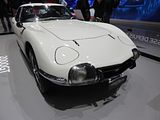
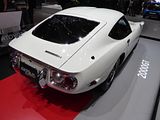
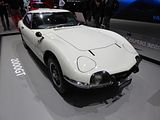
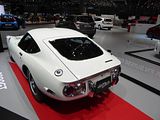
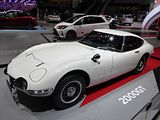
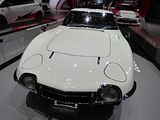

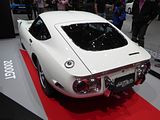
VOLKSWAGEN
No doubt that the star of the VW stand – one of the largest at the Show – was the new Arteon, the German car maker’s up-market replacement for the discontinued CC. First previewed by the Sport Coupe Concept in 2015, the new five-door fastback slots into the Volkswagen line-up above the eighth-generation Passat, with which it shares its platform, engines, chassis and interior. The styling of the Arteon is credited to Volkswagen brand design boss, Klaus Bischoff, who describes it as “the start of a new design era”. Set to challenge the new Vauxhall Insignia Grand Sport when UK sales get underway during the third quarter of 2017, it retains the highly contemporary lines of the well received Sport Coupe Concept, albeit with detailed changes to its prominent grille, which forms part of a distinctive full width graphic at the front of the new Volkswagen model in combination with its LED headlamps. Further design elements carried over from the earlier concept include a contoured clamshell style bonnet, highly detailed air duct design within the front bumper, heavily flanged wheel arches, prominent shoulder line along the flanks, distinctive scalloping within the lower section of the doors, curved roofline, muscular rear hunches, fastback tailgate, horizontally positioned LED tail lamps and twin trapezoidal shaped tailpipes integrated within the lower section of the rear bumper. The Arteon will be offered with three different styling packages: standard, elegance and R-line. In its most sporting guise, the new five-door fastback receives high gloss black air intakes at the front, uniquely styled bumpers, chrome embellishments within the lower bodywork, 18-inch alloy wheels and chromed tailpipes. At 4862mm in length, 1871mm in width and 1427mm in height, the Arteon is 60mm longer, 16mm wider and 10mm taller than its predecessor, the CC. Inside, Wolfsburg’s new fastback adopts an updated version of the Passat’s dashboard and interior appointments. Included among a number of high end options is Volkswagen’s high definition Active Info Display as an alternative to traditional analogue instruments as well as a centrally mounted 9.2-inch infotainment monitor with both touch and gesture control. With a wheelbase of 2841mm – some 131mm longer than the CC and 51mm longer than the existing Passat, Volkswagen claims the Arteon offers class leading rear seat accommodation. Nominal boot space is put at 563 litres, some 33 litres more than the CC, increasing to 1557 litres when the 40:20:40 rear seats are folded away. Among the new developments brought to the new Volkswagen is a revised version of the German car maker’s Emergency Assist driver assistance system. As well as being able to bring the car to a stop when it detects the driver is incapacitated as before, it now enables the car to autonomously change lanes before stopping to avoid a possible collision. The Arteon will be sold with the choice of three turbocharged four-cylinder direct injection petrol and three turbocharged four-cylinder common rail diesel engines from the start of UK sales later this year. Among the petrol units is Volkswagen’s newly developed 1.5-litre engine, which produces 148bhp in the base 1.5 TSI Evo. It is joined from the outset by the German car maker’s more familiar 2.0-litre powerplant offering either 187bhp or 276bhp in the 2.0 TSI. The trio of diesels models in the new Arteon line-up all use the same 2.0-litre engine, albeit in different states of tune, with buyers able to choose between 148bhp, 187bhp and 236bhp variants of the SCR equipped oilburner in the 2.0 TDI. The 148bhp 1.5-litre petrol as well as the 148bhp and 187bhp variants of 2.0-litre diesel engines come with a standard six-speed manual gearbox, while the 187bhp and 276bhp 2.0-litre petrol and 236bhp 2.0-litre diesel engines receive a standard seven-speed dual clutch gearbox. The transversely mounted engines channel drive to the front wheels in all but the most powerful 2.0 TSI and 2.0 TDI models, which run a fifth generation version of Volkswagen’s electro-hydraulic 4Motion four-wheel drive system as standard. Further driveline options, including a petrol-electric hybrid unit, are planned to be added later on. Rivalling cars including the BMW 4 Series Gran Coupe and Audi A5, the model is expected to start from above £30,000, a considerable rise over the CC which starts from £25,475.
Second newcomer here was a car which debuted at the Detroit Show in January, the Tiguan AllSpace. Featuring seven seats, these are accommodated as tere is 215mm added to the overall length of the Tiguan including 110mm added to the wheelbase which allows the interior to accommodate the extra row of two seats or an additional 115 litres of boot space. This puts the total boot space of the Tiguan Allspace at 730 litres with the rearmost seats folded flat, or 1770 litres with only the front two seats unfolded; 180 litres up on the Nissan X-Trail with the third row folded, but 212 litres down on the Nissan with both rear sets of seats flat. On the outside, it’s largely similar to the standard Tiguan, with only minor revisions to the bonnet and front grille. The car’s profile is also slightly altered due to the extra length. It will be available with the choice of six Euro 6 compatible four-cylinder engines when UK sales of the stretched second-generation SUV begin later in the year, with a choice of three petrol and three diesel engines ranging in output from 148bhp though to 236bhp. Volkswagen’s 148bhp turbocharged 1.4-litre petrol unit kicks off proceedings in an entry level 1.4 TSI featuring Active Cylinder Management that sees it return 47mpg on the combined European test cycle for average CO2 emissions of 135g/km. It is accompanied by a turbocharged 2.0-litre petrol engine with either 177bhp or 216bhp in the 2.0 TSI. On the diesel side, Volkswagen’s widely used turbocharged 2.0-litre engine provides the Tiguan Allspace 2.0 TDI with either 148bhp, 178bhp or 236bhp. All the diesels are equipped with an SCR catalytic converter and a 12 litre AdBlue tank to reduce nitrogen oxide emissions. The 148bhp 1.4 TSI and 148bhp 2.0 TDI are both sold as standard with front-wheel drive, although the latter can be optioned with Volkswagen’s 4Motion four wheel drive system, which comes as standard on all other Tiguan Allspace models. Four specs will be available, S, SE, SEL and SEL Premium, matching the US equipment levels. Europe gets three, called Trendline, Comfortline and Highline. It’s being brought to market in Europe in the second half of 2017, but is likely to reach the UK slightly later than other markets. It’ll be priced in Germany from around €30,000 (around £25,744); a premium of about £3000 over the standard. This means a UK starting price of over £26,000; the standard Tiguan costs £23,140 here.
VW announced a mid-life update to the Golf late in 2016, and there were a number of examples of these latest cars on show. Pride of place went to a gold-coloured Golf R which was apparently the new Performance variant, though VW were not saying much about it. All that has been said is that the new Golf R Performance is a faster and sharper version of the flagship model. The show car was wearing a titanium exhaust system and stickier Pirelli Trofeo R tyres, just like the ones offered as an option in the Lamborghini Huracan Performante. The Performance package also deactivates the top speed limiter of the Golf R, taking it from 155mph to 166mph. The 2.0-litre TSI engine continues to produce 306 hp and the 0 – 60 acceleration time is unchanged. Also included in the Performance package are the drilled brake discs and extra aero elements like the air-curtains on the front bumper and the rear spoiler which adds up to 20kg of downforce.
With a huge range of different models and body-styles, let alone variants, VW could only show a selection of other current product. The range starts with the diminutive Up! and there were a couple of examples of this on display, the Up! Beats and eco Up!
An all new Polo is due out later this year, so it was no surprise that it was low key for the current model, with just one version on show. There was also only one Beetle, a Cabrio model.
From the middle of the range were a number of Golfs, including the latest GTi, the Estate as well as the SportVan and the latest Touran.
Passat models were included in the display of hybrid GTE cars at the back of the stand (which I failed to photographs) as well as on the main part of the display were the AllTrack was the version selected for show.
More versatile models included the Sharan, the Touareg and the Caddy as well as one of the popular Amarok pickups.
Volkswagen’s Commercial Vehicle division is celebrating the 70th anniversary of the iconic Bulli (Type 2) by launching a special edition. Based on the Multivan Comfortline and created using a mix of elements from the Highline and California models, it will go on sale in Germany from the begging of May, with other European markets to follow. Some special identifying features adorn its body, such as the ‘Bulli’ badges, anniversary sticker, chrome trim, tinted windows for the passenger compartment, and matt black decals around the B-pillars. However, the two-tone paintwork that combines Candy White and Metallic Kurkuma Yellow, and the 18-inch ‘Disc’ wheels are optional. The same look continues inside, where the special edition VW Multivan benefits from a wood-like floor, Visitamo seat covers, and ‘deluxe’ lighting. These add up to the standard features that include a multifunction leather-wrapped steering wheel, ‘Premium’ display, glossy black look for the instrument panel, electrically adjustable heated and folding mirrors, and ParkPilot.
VW have tantalised show attendees in recent years with many a concept suggesting that they might introduce a modern reinterpretation of the much-loved (and now rather pricey) Type 2 Bus, and every time the concept has then quietly disappeared from view again. And here in 2017 was another one, called the ID Buzz Concept, yet another take on the idea of a modern Microbus and the second I.D. study after the hatchback that debuted at Paris last year. Powered by an electric powertrain that combines two 201hp motors on each axle which produce a combined 369hp, the I.D. Buzz is capable of a 0-60mph in 5.1 seconds before hitting the 99mph top speed limiter. Measuring 4,942mm long, 1,976mm wide and 1,963mm high, the I.D. Buzz concept is based on VW’s MEB platform which is reserved for electric models. The concept is also fully autonomous, featuring the I.D. Pilot system. The floor-mounted battery pack has a capacity of 111kWh, giving the Buzz a theoretical driving range of 270miles (600km NEDC) before it requires a recharge. Speaking of which, VW claims that an 80 percent charge can be achieved in 30 minutes with the Combined Charging System (CSS) or an inductive charging interface with a charging rate of 150kW is used. The futuristic design language contains a lot of retro elements in a bid to evoke the iconic looks of the original, with VW also releasing a new gallery showing the concept on the streets of Miami, where the I.D. Buzz meets its legendary ancestor. Will they build this one? VW have not said “no” this time, so given the enthusiastic reception which it received, it is just possible that they might. We shall see.
VOLVO
Volvo is another of those brands which has cut back massively on the number of International Motor Shows that they now attend, but unlike MINI, Geneva is one that they have kept in their program. That meant that they had the perfect location to present their new second generation of the XC60. Volvo hopes that this model will further accelerate the firm’s dramatic sales growth, with the all-new car set to be pitched against the Audi Q5, BMW X3, Jaguar F-Pace and Mercedes-Benz GLC in the booming mid-size SUV sector. Volvo sales have risen for the past three years, with the growth led by the popularity of the XC90, S90 and V90. Combined sales of the 90-series models grew 125% last year compared with 2015. However, the outgoing XC60, which was launched in 2008, hinted at the potential appeal of a new model by setting a new sales record in 2016, accounting for 161,092 units of Volvo’s 534,332 total annual sales. The new XC60 sits on Volvo’s SPA large car platform, which will underpin all of the firm’s 60 and 90 models, including the all-new S60 saloon and V60 estate that are expected early next year. The move to the new platform has allowed Volvo to make the new SUV longer, lower and wider than its predecessor, without adding weight. It is 4690mm long (up 62mm on the current car), has a 2865mm wheelbase (up 91mm), 1902mm wide (up 12mm) and 1658mm high (down 14mm). At the same time, practicality has been increased with more cabin space, especially in the second row of seats, and a greater ground clearance engineered, while the design retains a more dynamic, ‘cab-back’ look. The XC60 will go on sale following this week’s Geneva show reveal, with deliveries expected from September. At launch, it will be offered with the familiar 187bhp D4 and 232bhp D5 2.0 diesels, plus the 251bhp T5 2.0 petrol and 401bhp T8 petrol-electric hybrid unit. Few performance figures have been revealed beyond the T8’s 0-62mph time of 5.3sec. All launch, models will be four-wheel drive and linked to an eight-speed automatic gearbox. Manual and front-wheel drive models will arrive later, as well as new diesel and petrol engines and possibly an economy-focused three-cylinder petrol-electric hybrid. In an effort to enhance both the dynamic set-up and noise and vibration isolation, the XC60 has double-wishbone front suspension and a rear multi-link arrangement. Height-adjustable air suspension will be offered as an option, offering an additional 60mm of travel up and down. Inside, the XC60 is heavily inspired by the XC90’s award winning cabin, with all versions getting the same 9-inch central digital control screen and all but entry-level Momentum models having a 12.3in digital instrument dash display. The infotainment controls have also been updated, to offer greater clarity and ease of use; these changes will also be applied to the XC90 later this year, and may be retrospectively updated on cars fitted with the system. The cabin also has a large, sculpted central dash cowling, which will be offered in several designs of metal or wood finish, and several clever storage solutions, including laptop storage under the rear seats. This being a Volvo, there is also a suite of safety and self-driving equipment, both standard and optional. Standard kit includes automatic braking if the car senses a potential collision up to 37mph and steering support if the car detects either a head-on collision or any imminent accident. Optional systems that can hold the car in lane while keeping a safe distance from other vehicles up to 80mph, monitor traffic as you come out of junctions and brake the car if necessary or detect an imminent rear impact and pre-tension the seat belts in preparation are also available. Prices for the XC60 are expected to rise to be comparable with those of its premium rivals, starting at around £30,000, but Volvo hopes to gain an edge by offering a greater amount of standard kit, including a raft of active safety equipment. Sportier R-Design models are expected to dominate UK sales ahead of the Momentum and Inscription trims.
The executive S90 and V90 have now been on sale for a few months, and are starting to be seen our Europe’s roads. It will be interesting to see how well the cars sell, as this is a tough sector of the market to break in to, as Jaguar have found, where excellence is no guarantee of success. And be in no doubt, these cars are excellent, combining attractive styling with a particularly well judged interior, and dynamics that whilst prioritised in a different way from the more sporting rivals, are very livable with.
It does not seem very long since Volvo were launching the V40 and following it up with the “toughened up” looking V40XC, yet we are now told that these cars will be replaced within months. I had a week driving a V40 D4 late last year and apart from the truly bone-jarring ride from the R-Design suspension, thought it an excellent car, one you would be happy to own and drive.
There was no sign of the S60, but the hatch cum estate version, the V60 was here. Again, still a relatively recent design, but also destined for replacement later this year, sharing much of the underpinnings of the new XC60, of course.
Final Volvo model on show was the second generation XC90, a car which has impressed all who have come across it. in much the way that the first one did when it was launched.
ZENVO
This is the Zenvo TS1 GT 10th Anniversary, a Danish supercar that’s been built to mark its maker’s 10th year. The carbon-bodied, rear-wheel drive, mid-engined two-seater produces 1163bhp from its flat-plane crankshaft twin-supercharged 5.8-litre V8. Drive is sent to the rear wheels via a quick-shifting gearbox with helical-cut gears. Cogs are swapped in 40 milliseconds. The car’s top speed is 250mph. The car is an extensive redesign of the original ST1, first shown at the Le Mans supercar parade In 2009. It is priced from close to £1 million. The TS1 GT is set to begin a whole new era for Zenvo. The firm has built a new factory on the Danish island of Zealand, prototypes have been in Lapland testing a revolutionary new traction control system, and the company will soon announce details of a new dealer network in Europe, the UK and the US, designed to meet the needs of customers who are already waiting for our cars. Zenvo say that there is a continuing strong demand for big-power supercars like the latest Zenvo TS1 GT, which features a revolutionary “instant shift” manual gearchange. However, the company is preparing for the future by developing a hybrid EV, understood to draw on much of the car’s existing hardware. Zenvo, whose original prototype made an infamous TV debut by catching fire during early tests, is on the point of establishing an advisory board of supercar experts – a plan once used by Lotus – which is understood to include the McLaren F1 designer Peter Stevens.
So there we have it. Geneva 2017. A great show. Proof that the motor industry is in rude health and brimming with confidence as ever more sophisticated technology is applied to the benefit of the customer and also to meet political and environment pressures that are extremely challenging. You can see all this lot in a day, but you will be tired at the end of it. Hopefully, I will not have my diary sabotaged in 2018 and get the benefit of a bit more time to enjoy whatever that show has to offer. Oh, and the “Car of the Show”? Indeed, someone sitting next to me on the plane asked me this, and my answer surprised him. I told him it was the Monteverdi Hai. I had a Matchbox model of this car when I was growing up (indeed, I still have it, somewhere!), but I’ve never seen one before. To see it for real was an unexpected bonus. It may have been one of the oldest vehicles on display, and it may even not be that good to drive (I am never going to find that out, for sure!), but for me it was all I wanted it to be like: stunning to look at, and if only the engine could have been fired, apparently equally amazing to listen to. Cars have come a long way since 1970, and objectively are “better” in just about every way, but sometimes the latest is just that, rather than necessarily any more beguiling than what we produced a generation back. For the car enthusiast, that means that there is plenty more of interest yet to come. Hurrah!

